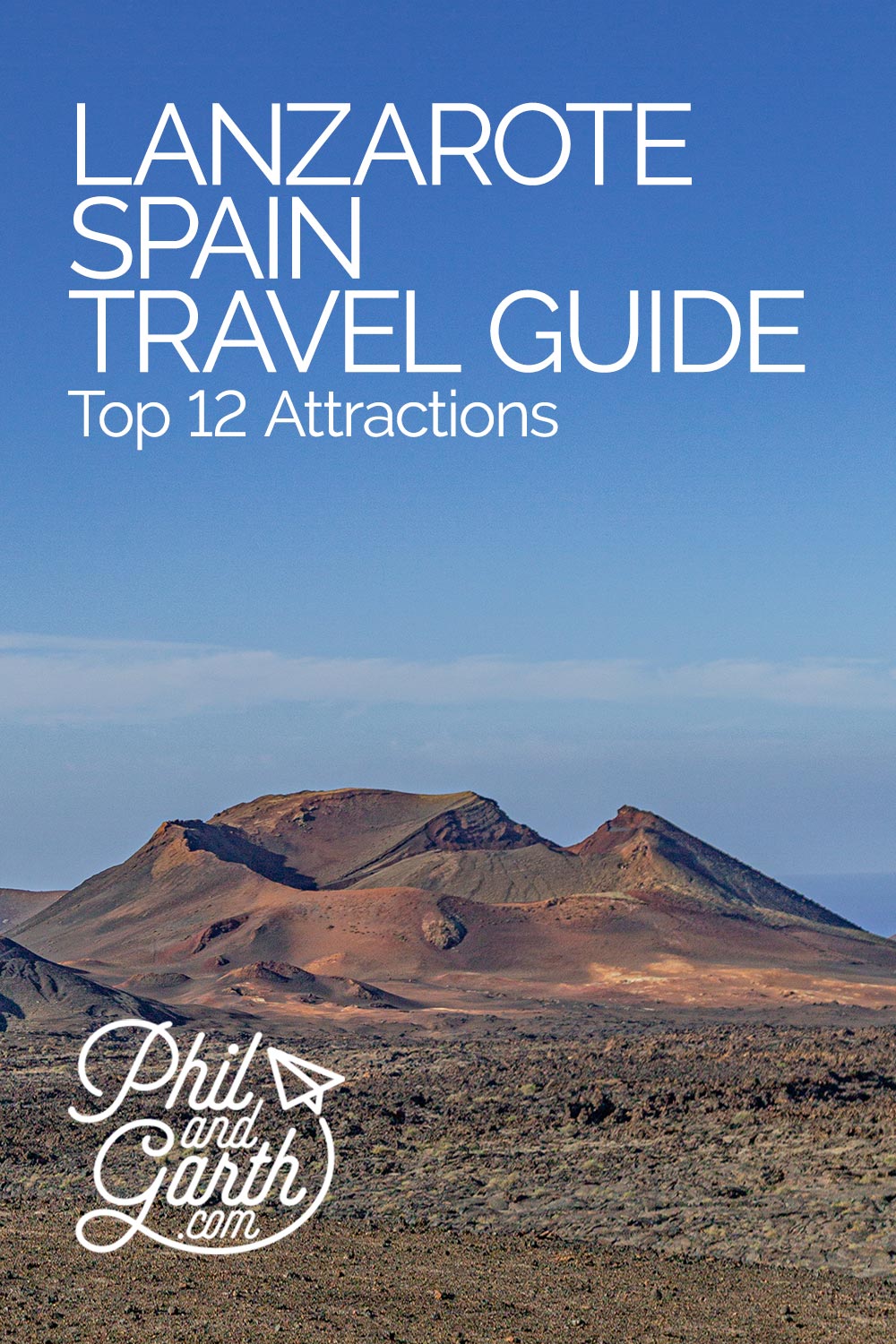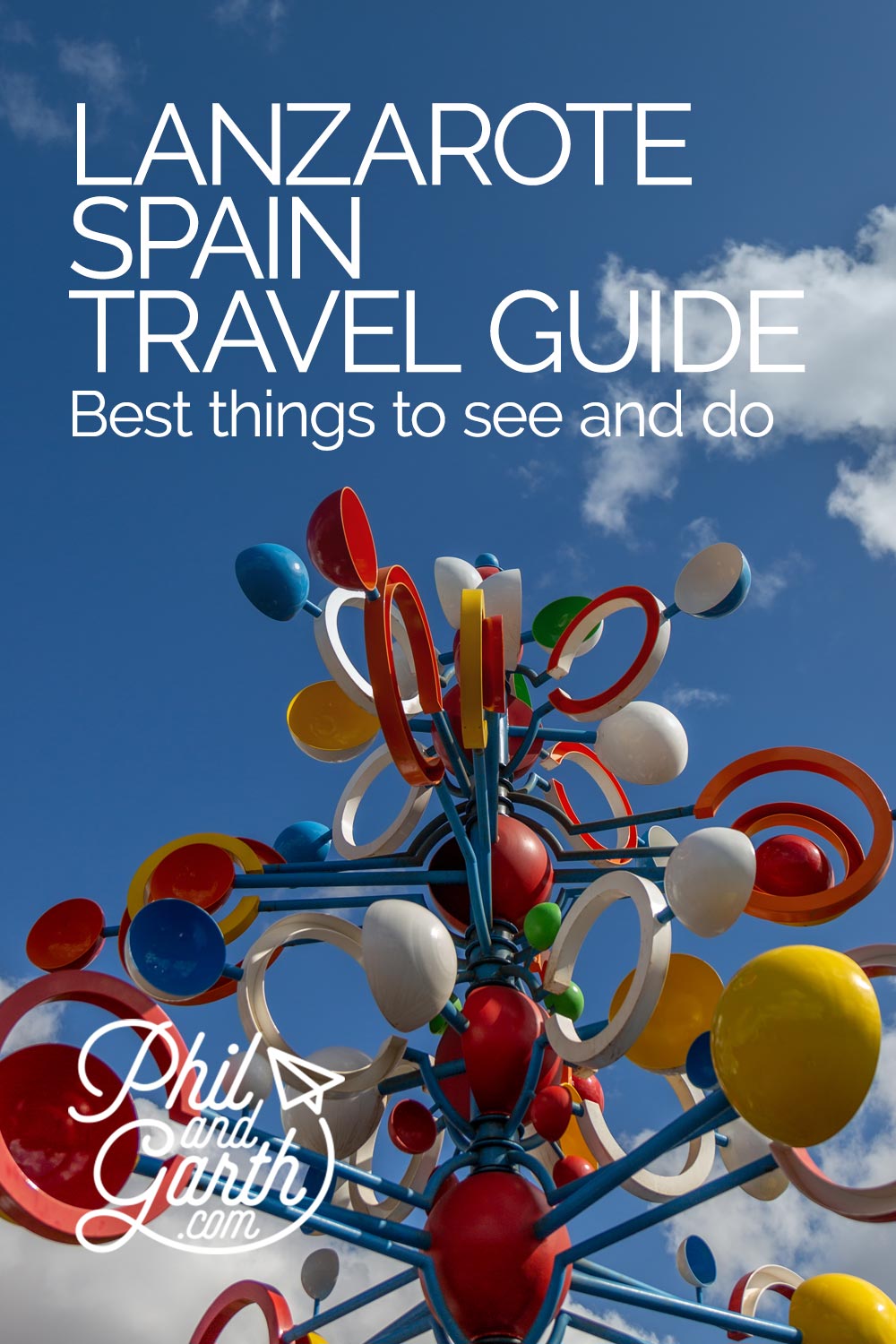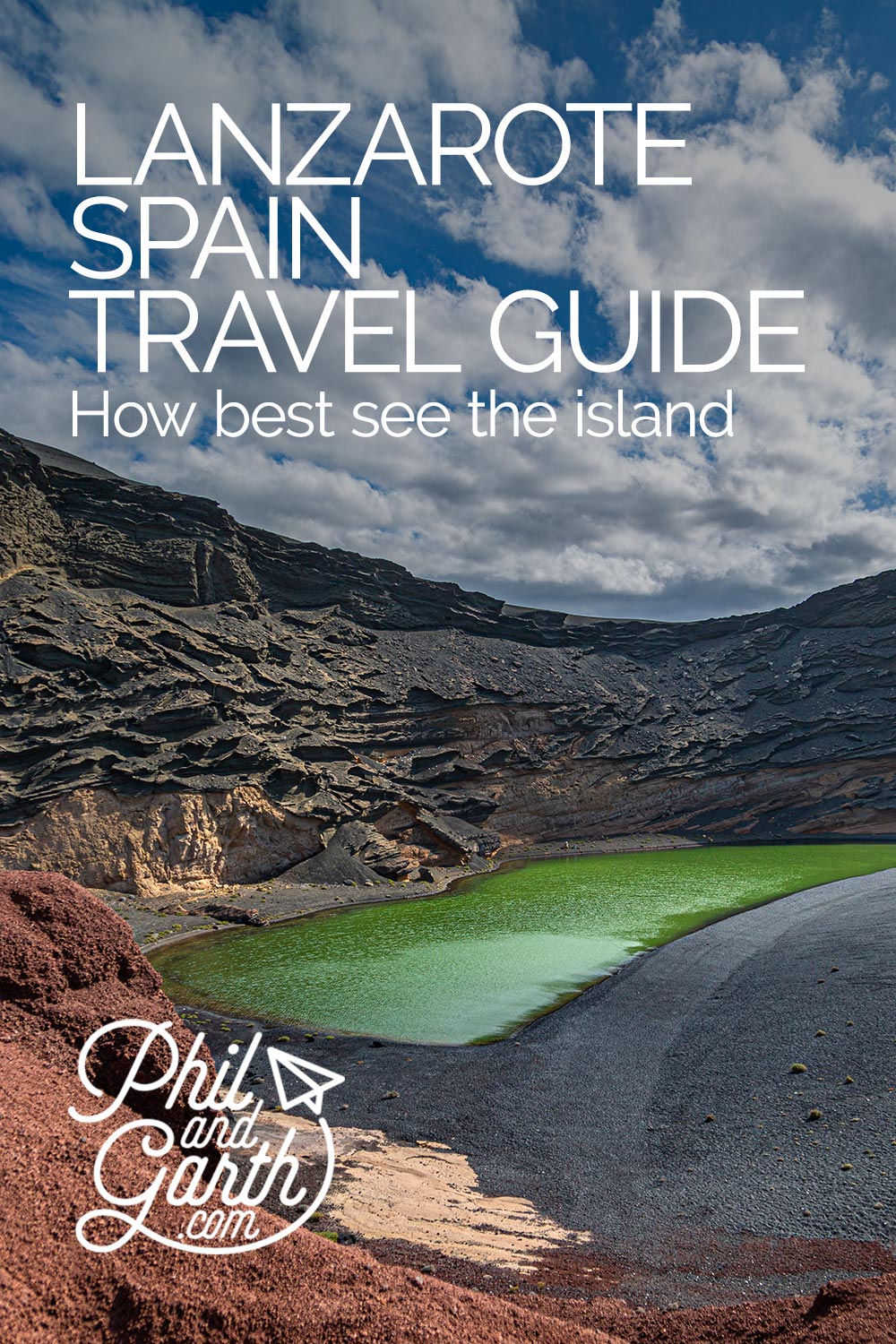Last updated: 11th January 2022
Lanzarote is a Spanish island famous for its otherworldly volcanic landscapes and delivering year round sunshine which is why it’s so popular with us Brits. Lanzarote is just a 4.5 hour flight from the UK so we decided to escape the damp British weather for a winter sun break. Garth wanted to see the work of his favourite Spanish artist César Manrique, whilst Phil wanted to chill out by the pool. In this travel guide to Lanzarote, we’ll show you the best of Lanzarote as there’s is so much more to do than sun and beaches. Just follow our list of the top 12 things to see on Lanzarote and how we did it all with our 7 day Lanzarote itinerary.
Table of Contents
About Lanzarote
Lanzarote is the 4th largest of the 8 Spanish Canary Islands. It has a stunning volcanic landscape to explore plus 97 black and golden sandy beaches perfect for a fly and flop holiday. Lanzarote’s has a mild sub-tropical climate and is dry with very little rain. Balmy temperatures average 20ºC year-round, so it’s not boiling hot like Caribbean islands or Asia, instead, it’s nice and comfortable especially with the regular Atlantic Coast breeze. To see the best of Lanzarote’s attractions you’ll need to hire a car. But don’t worry you won’t clock up huge mileage as it only takes about an hour and a half to drive from top to bottom.
We’ve been to the other Canary Islands like Fuerteventura and Gran Canaria and we think Lanzarote is possibly the most stylish of all the Canary Islands. It’s certainly not Lanzagrotty as some people call it.
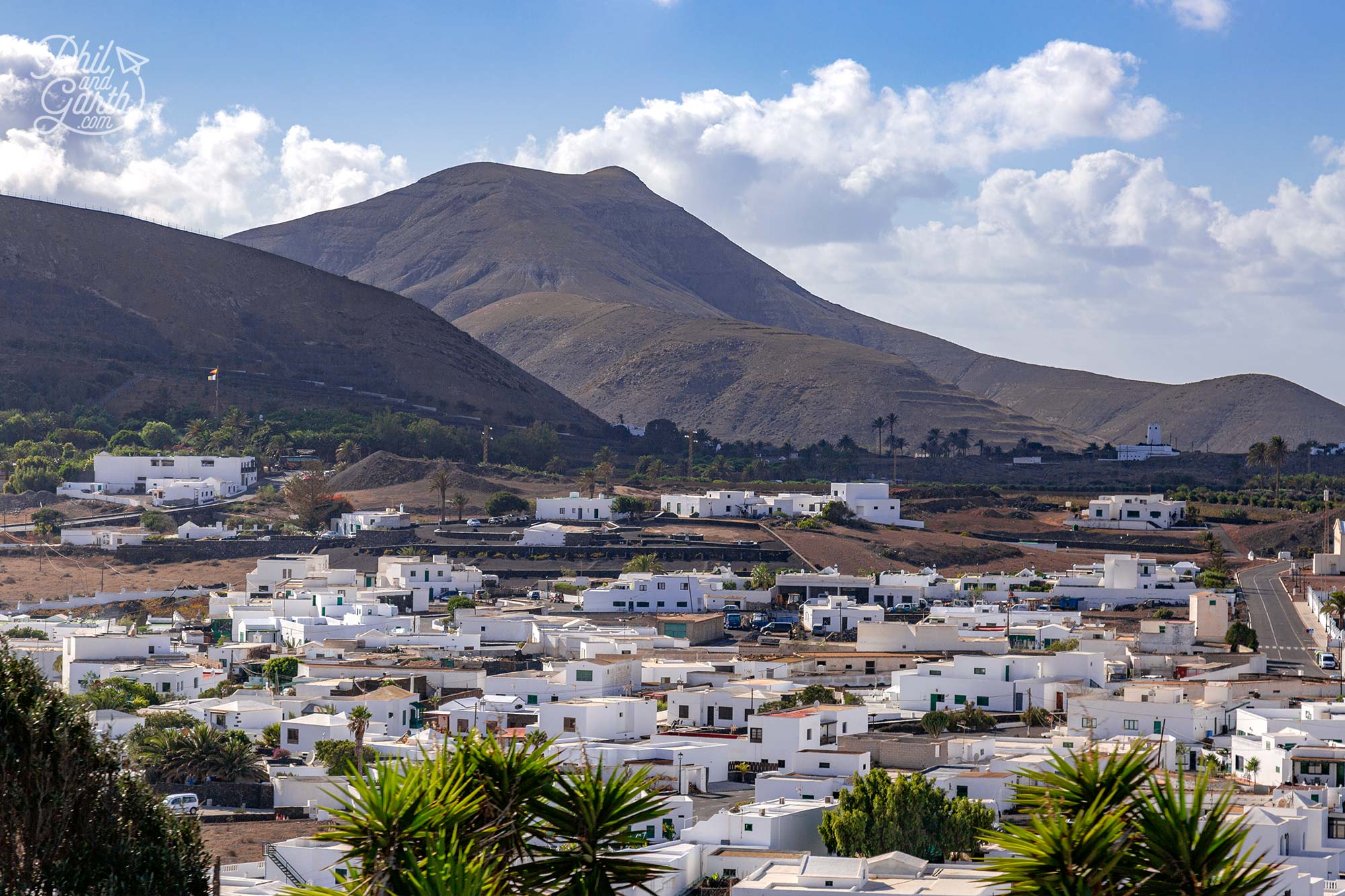
Typical single storey white-washed homes in Lanzarote
About César Manrique – Lanzarote’s Famous Artist
The bustling seaside resorts on Lanzarote still manage to retain a charm, that’s because high rise hotels, big billboards and overhead cables are banned. All thanks to the work of local artist César Manrique who pioneered sustainable tourism in the 1970s. He worked with the government to develop natural tourist attractions on the island and defend the beauty of the island by rejecting mass development. His ethos was to harmonise nature with art and protect the environmental values of the Canary Islands. César Manrique’s motto was “art into nature, nature into art”.
In the same way as Antoni Gaudí’s work is all over Barcelona, Manrique’s rich art, sculpture and architecture is dotted all over Lanzarote. From his signature whitewashed walls to his abstract wind sculptures on roundabouts, he certainly left a great legacy.
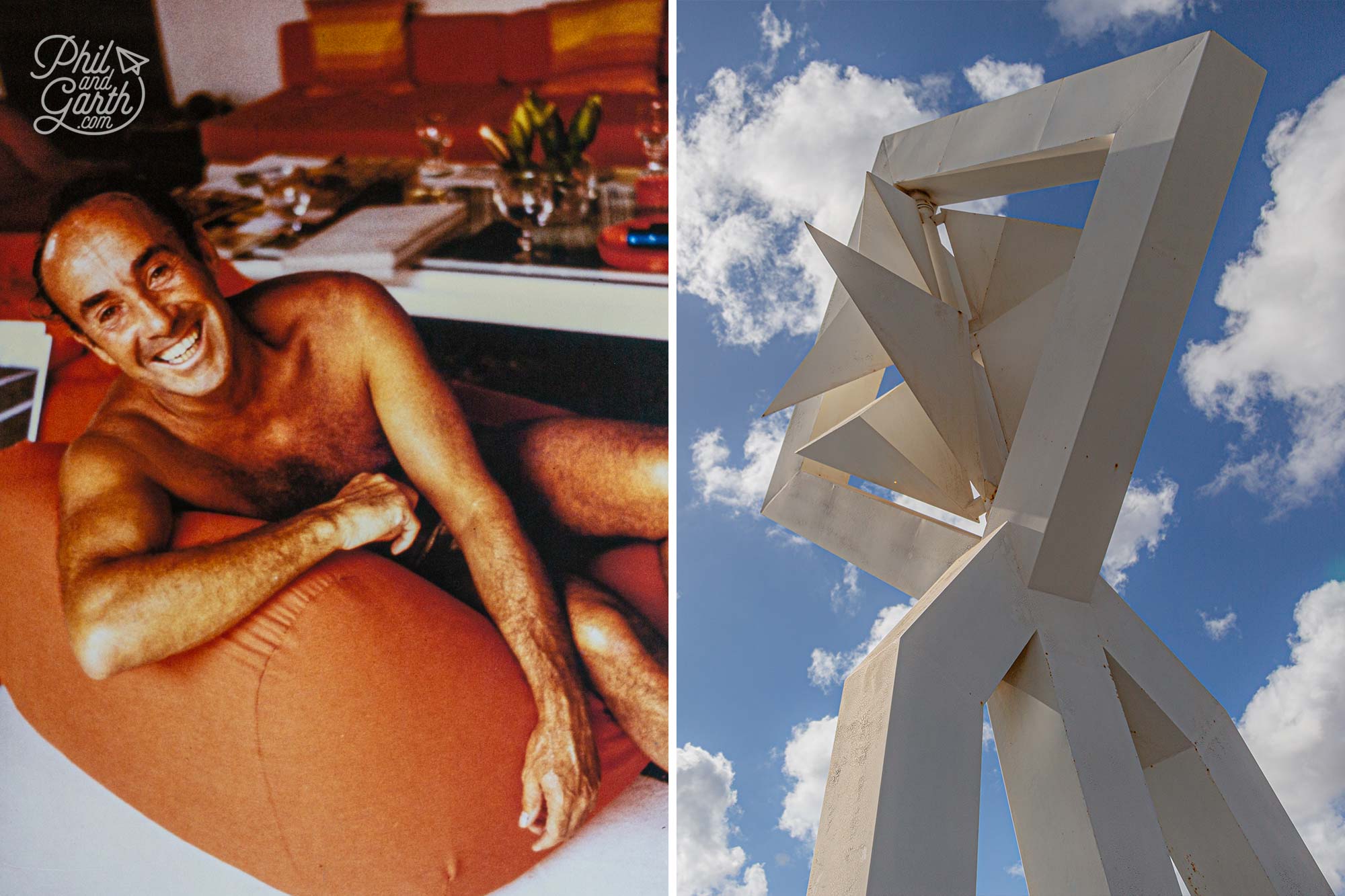
Lanzarote’s Artist César Manrique and one of his wind sculptures
Top 12 Attractions of Lanzarote
1. Timanfaya National Park
Lanzarote’s top attraction are the Montañas del Fuego, the ‘Fire Mountains’ of the mighty Timanfaya National Park. This unique and otherworldly landscape was created in 1730 when over 100 volcanoes fiercely erupted over a period of 6 years and destroyed numerous villages in its path. The last eruption occurred in 1824, since then the volcanoes have been long dormant for over 200 years. Apart from one active volcano – Timanfaya which the national park is named after.
Timanfaya is the must-see sight of Lanzarote. It’s an extraordinary place where the black lava landscape mix with copper and red colours creating a Mars lunar-like landscape. The BBC filmed an episode of Dr Who here in 2014 called ‘Kill The Moon’. Even NASA and the European Space Agency worked here to test their Mars Rovers for future expeditions. Back in the day NASA also trained Apollo 17 astronauts by showing them pictures of the Timanfaya National Park to give them an idea of what the surface of the moon would be like. We loved our morning here and thought Timanfaya reminded us a little of the volcanic landscapes we’d seen on the neighbouring Fuerteventura island and the lava plains in Iceland.
You are not allowed to drive off on your own around the park, instead, you must join the obligatory bus tour through the rocky landscape. It lasts 40 minutes with commentary in English, Spanish, German, French and Italian. You can only take photos through the bus windows, but don’t worry if you struggle as can also take some great pics from the terraces below the restaurant when you’re done on the bus.
TIP: Sit on the opposite side of the driver on the bus for the best views.
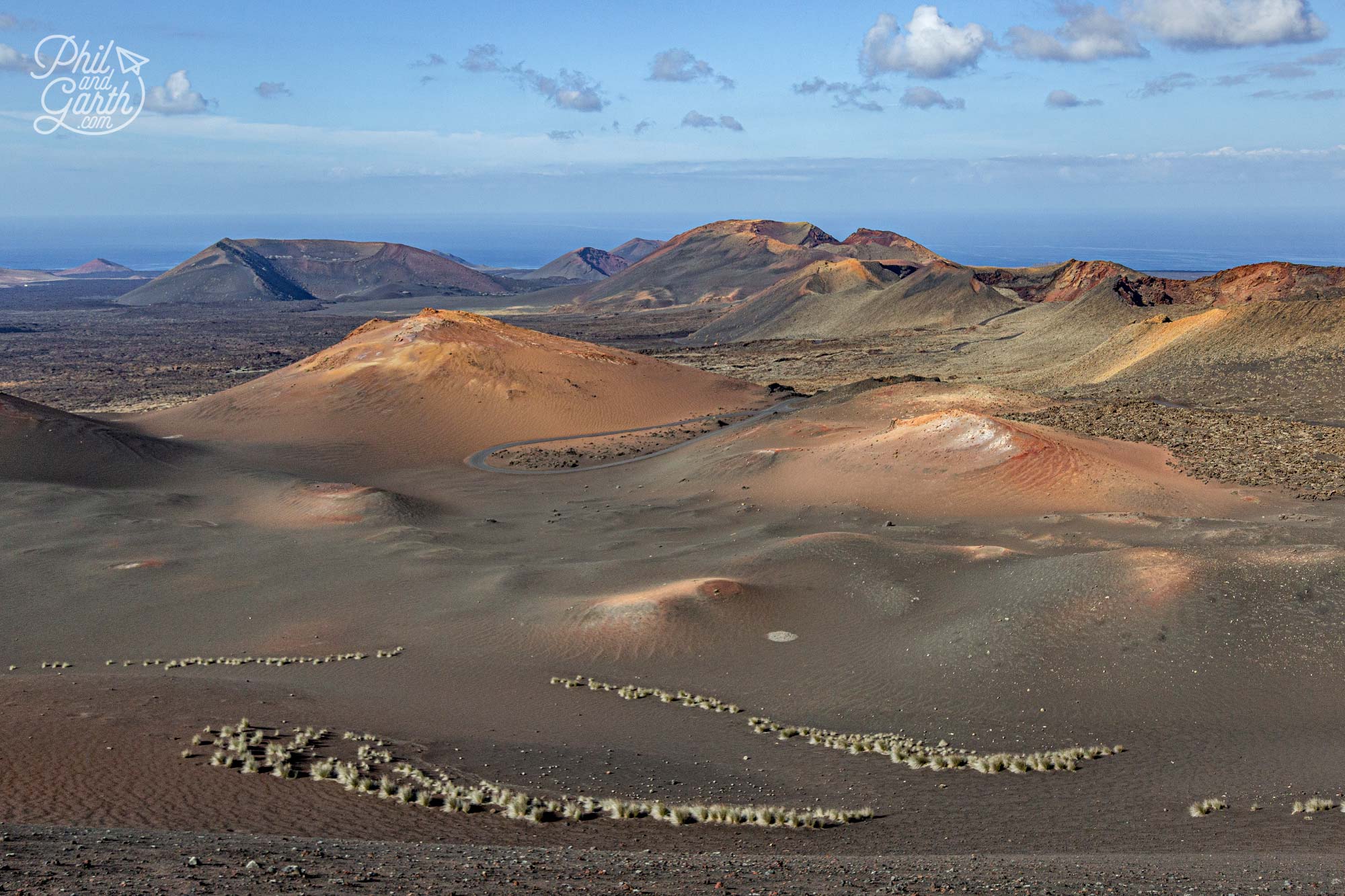
Timanfaya National Park was established in 1974 and takes it name from the still active Timanfaya volcano
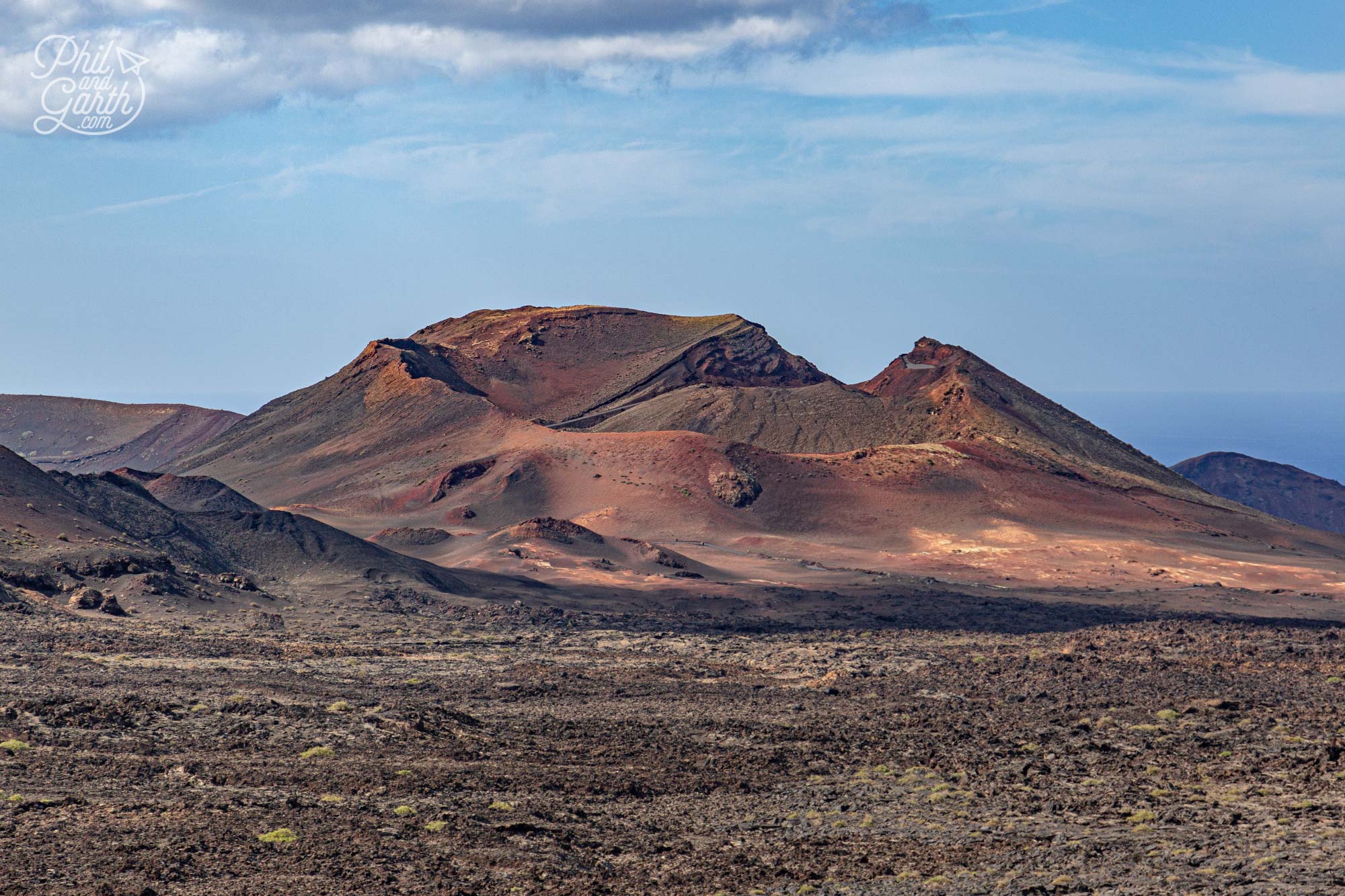
Red, orange and black colours make up this extraordinary Martian landscape
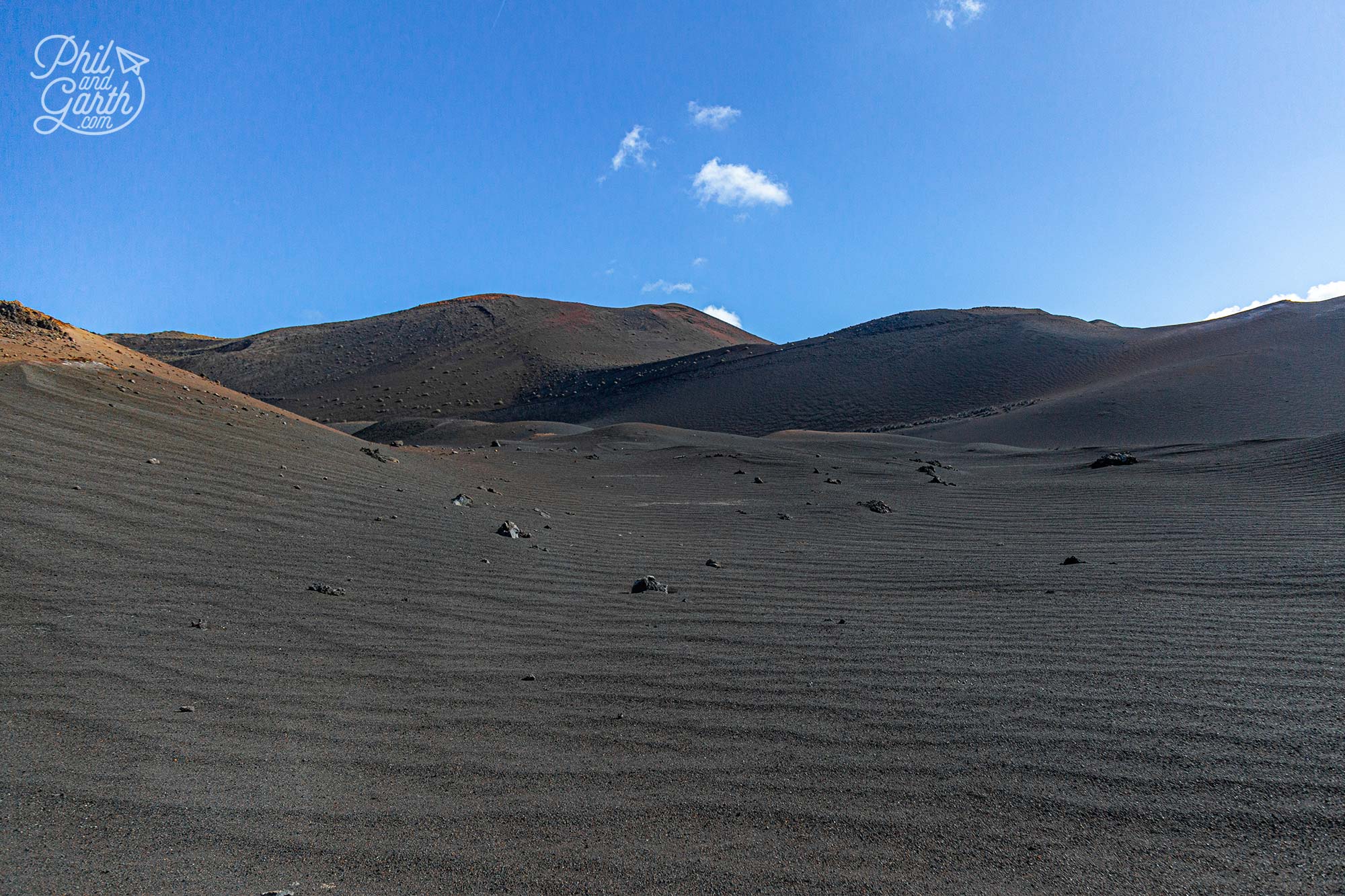
Barren lava plains covered in black volcanic ash
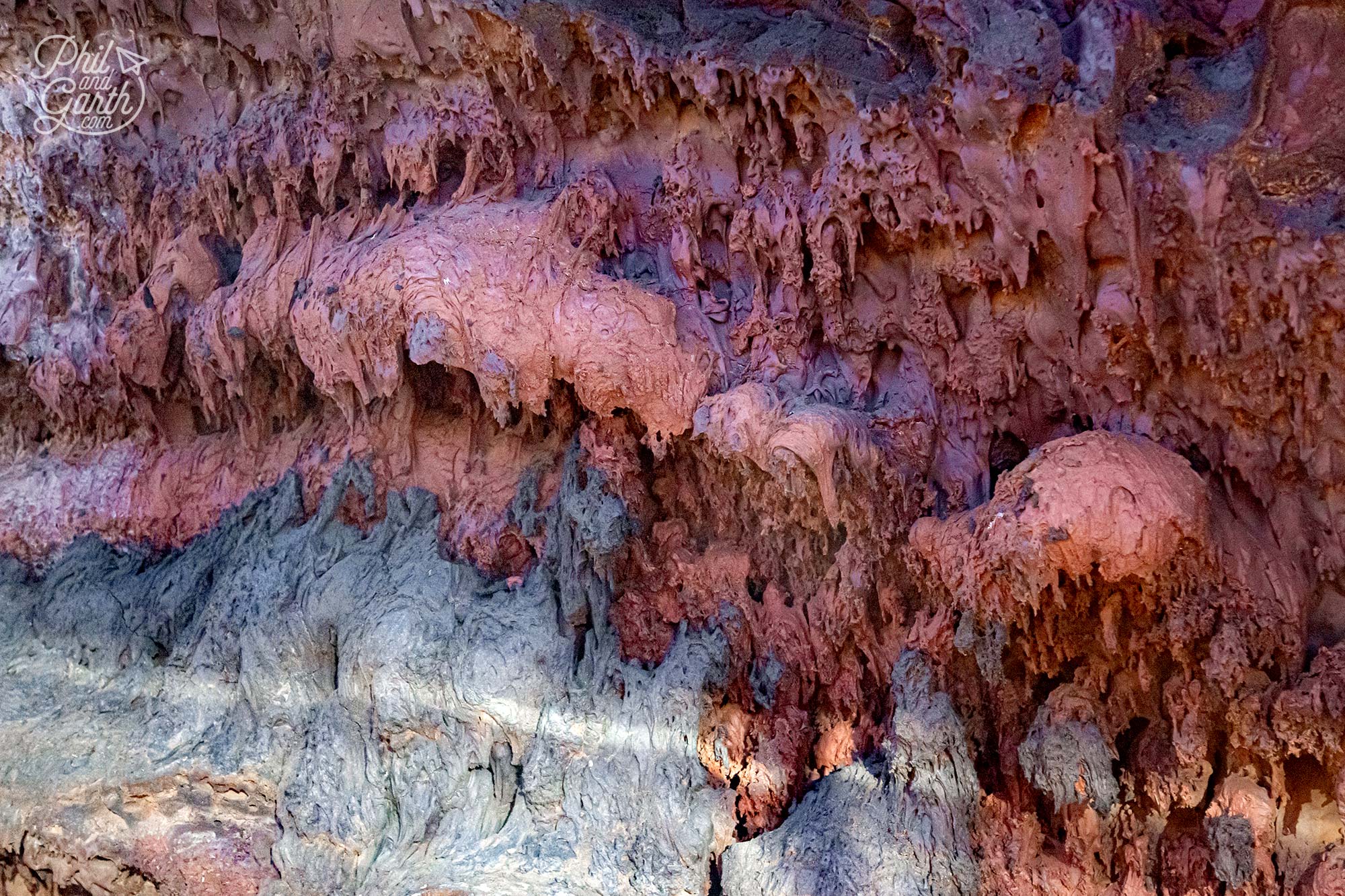
The bus tour passes some of swirling lava formations close up
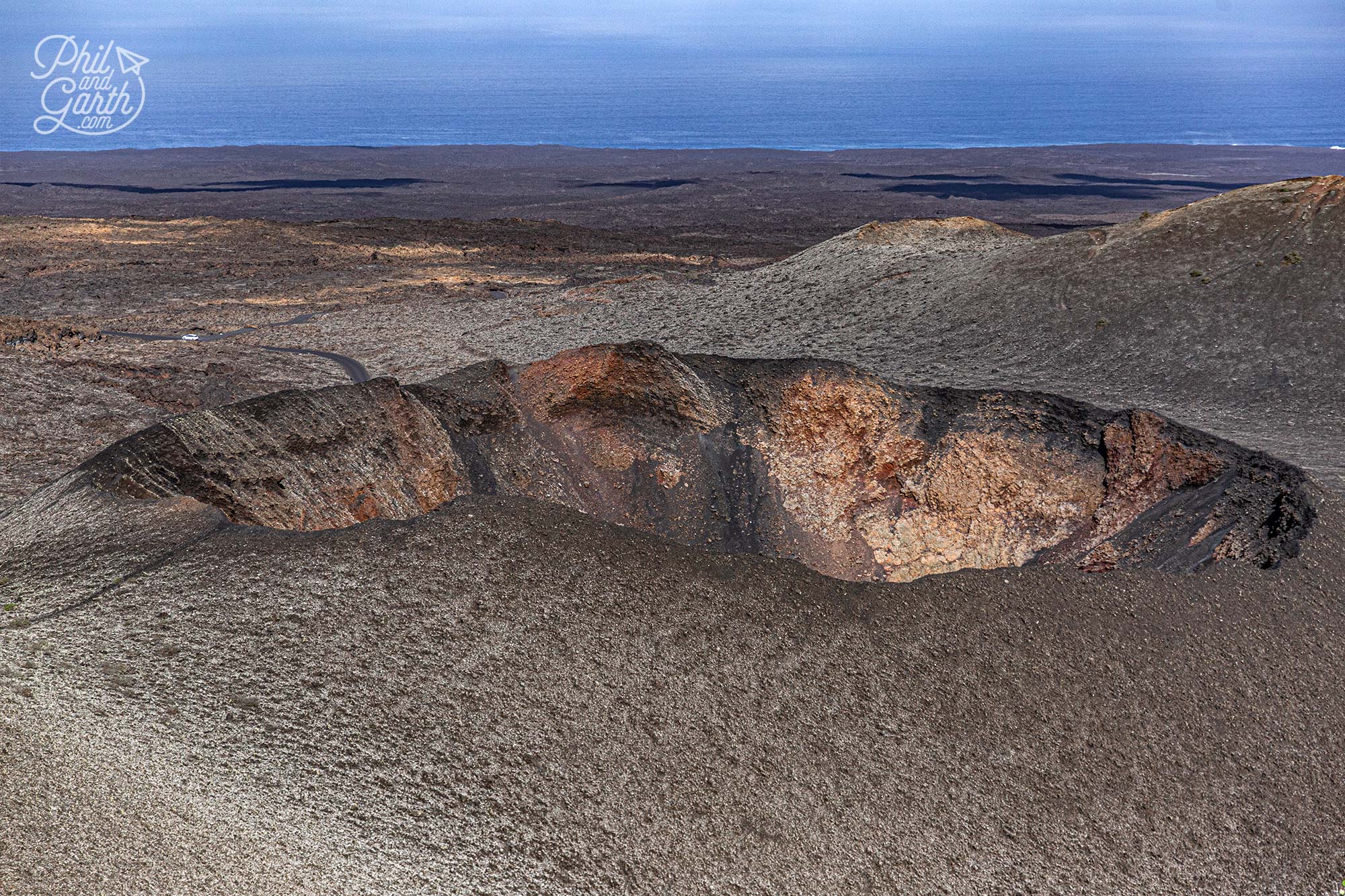
Dormant volcanoes dot the eerie landscape of Timanfaya National Park
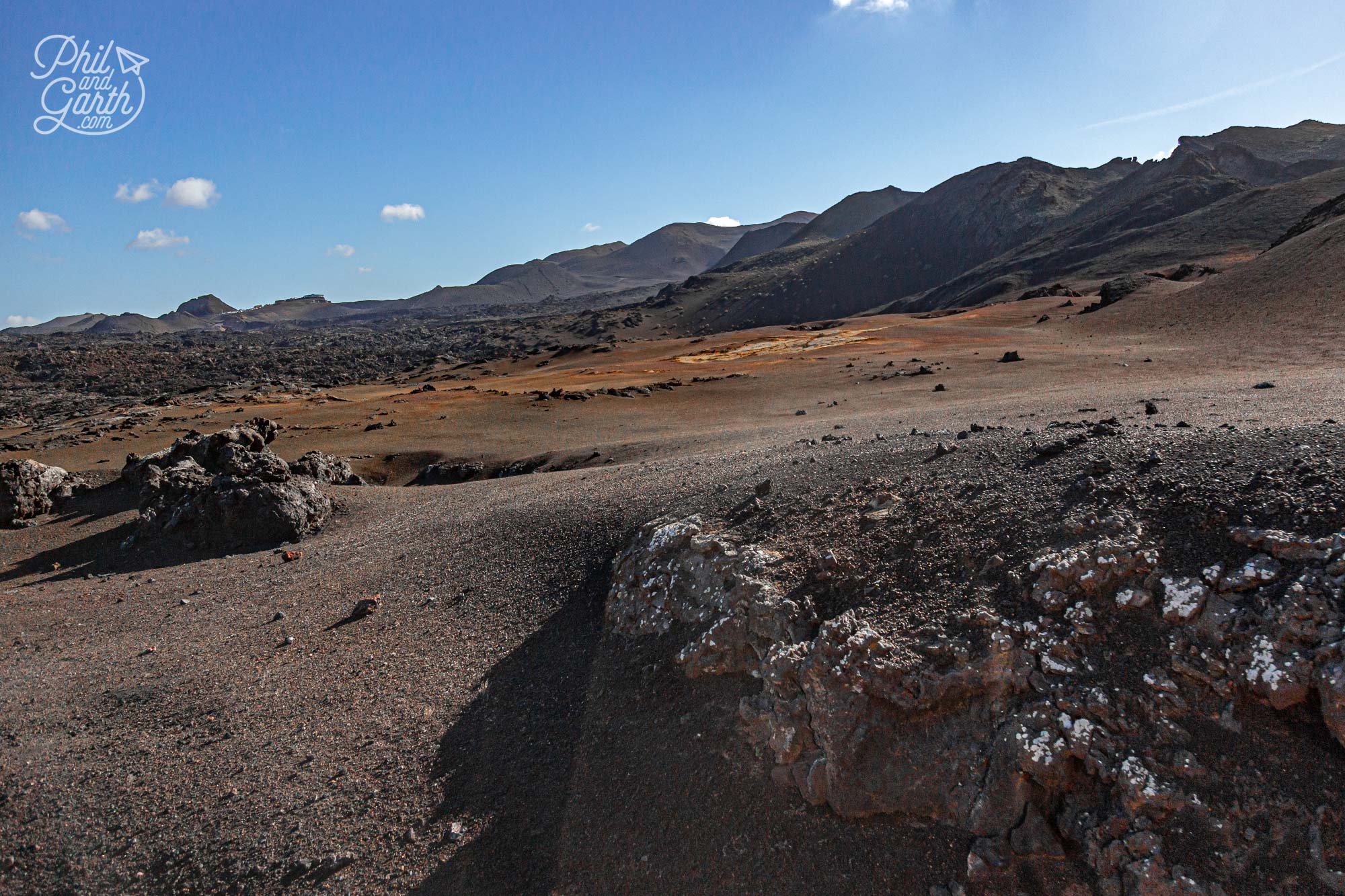
The Mars-like landscapes of Timanfaya National Park
After the bus tour, we watched the impressive geothermal demonstrations. Just a few metres below the ground the underground heat reaches temperatures between a scorching 400 – 600ºC. To demonstrate this some dry grass (brushwood) is dropped into a hole in the ground and quickly bursts into flames. Next, we watched water poured into a small hole, seconds later steam shoots up into the sky like a geyser. The demonstrations were a reality check that we really were standing at the top of an active volcano! When Garth came here as a kid, his dad said the volcano could blow at any moment! … Garth was petrified, we reckon it’s so his dad didn’t have to buy him anything from the gift shop!
Before you leave you can also watch and enjoy some geothermal cooked food at the El Diablo restaurant. Just like in Iceland this restaurant uses heat from the volcano in an open pit to barbecue meats like chicken (pollo) and conejos (rabbit).
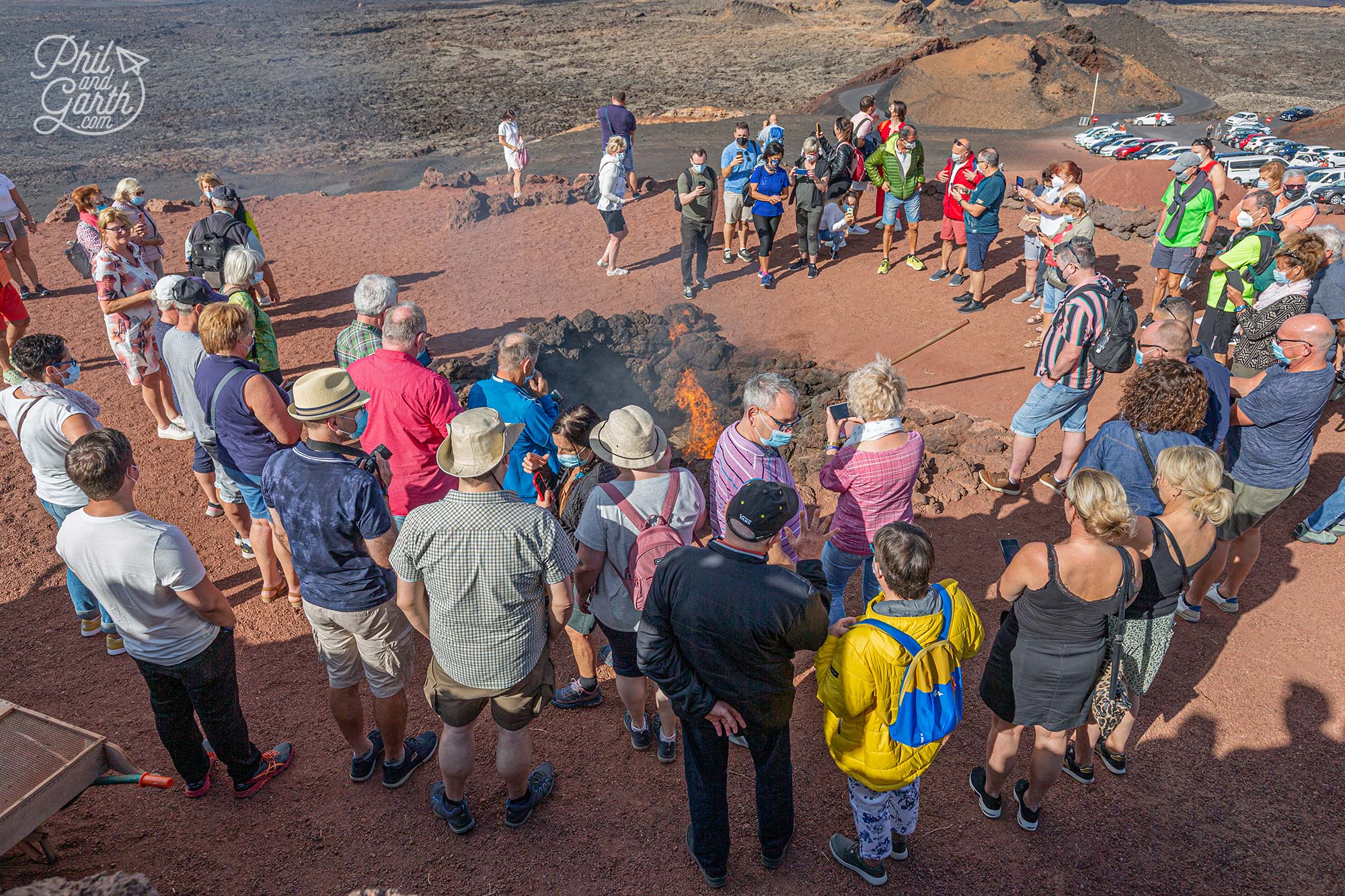
Tourists watch the impressive geothermal demonstrations
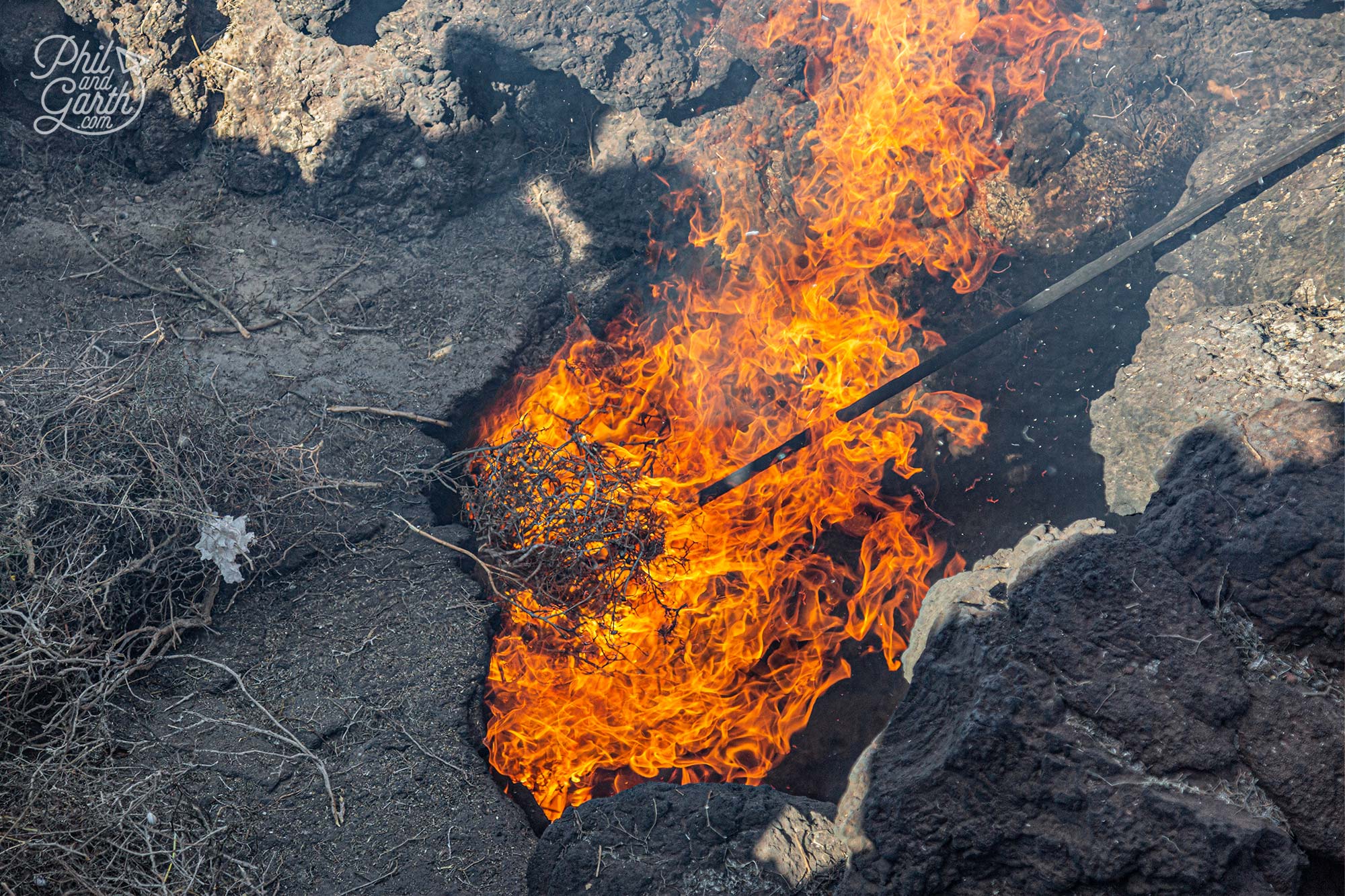
Dry grass is dropped into a shallow pit and quickly bursts into flames
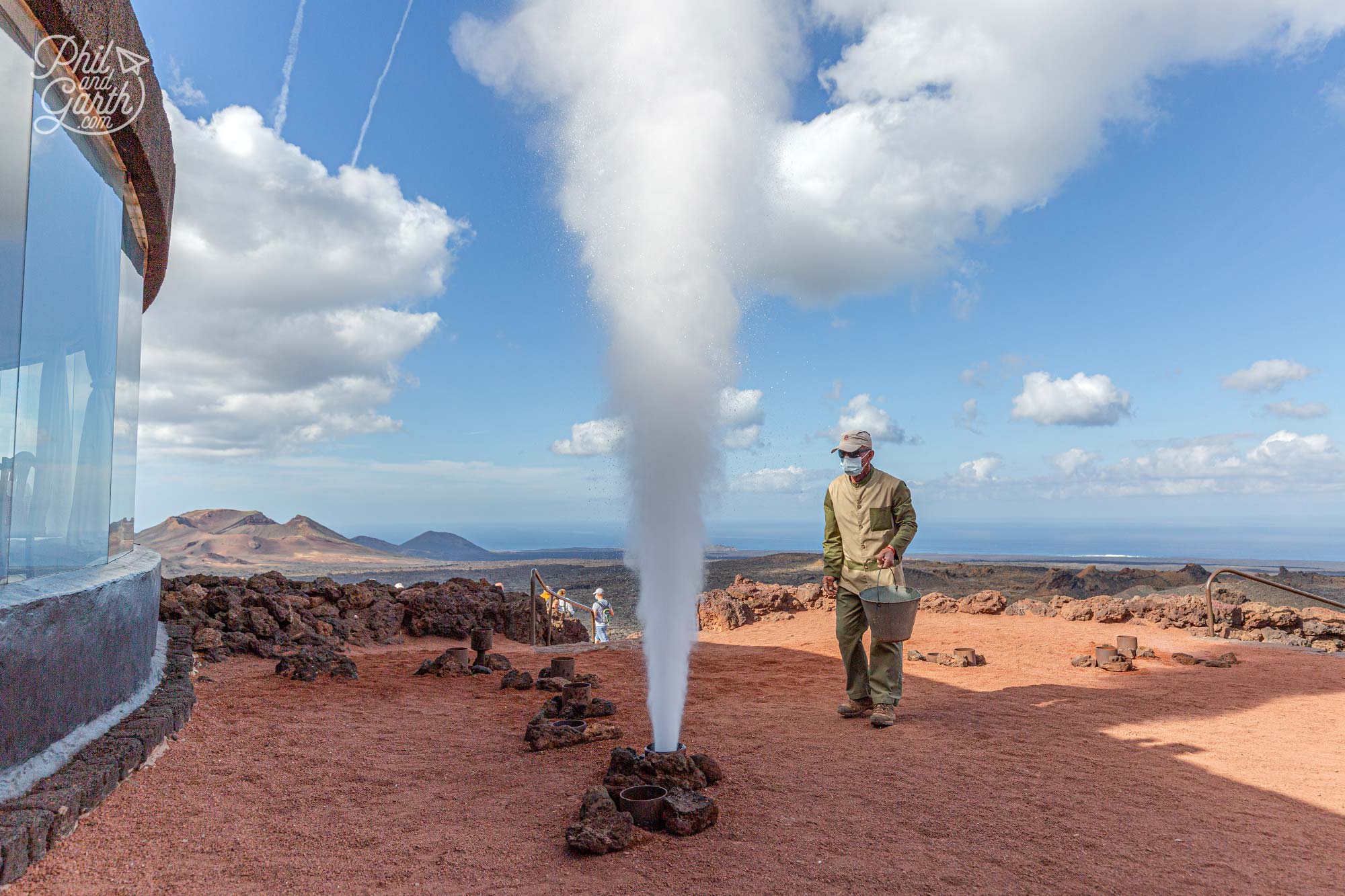
A demonstration of water turning to a jet of steam just like a geyser
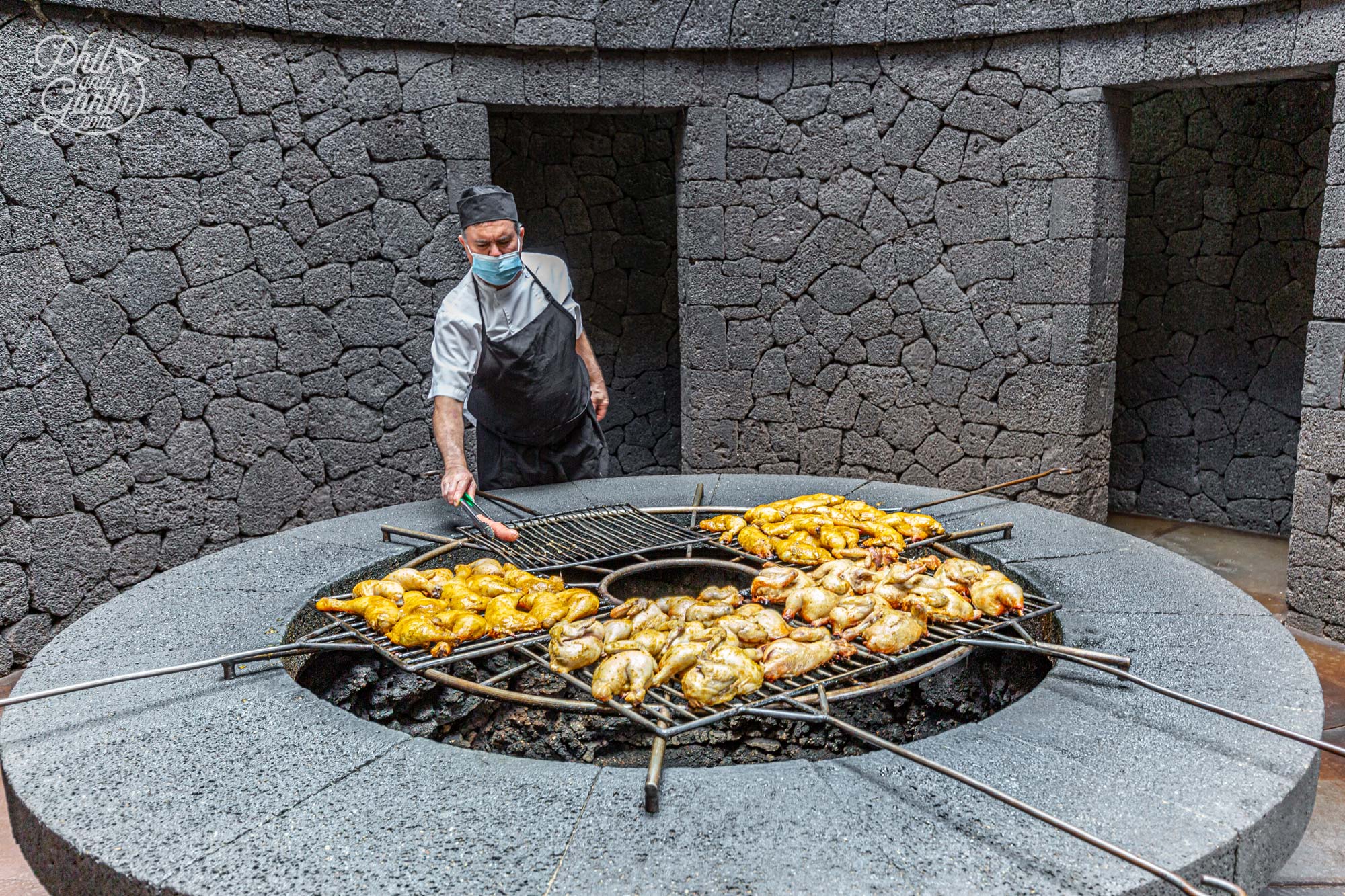
A chef uses the heat from the volcano to cook various meat at the El Diablo restaurant
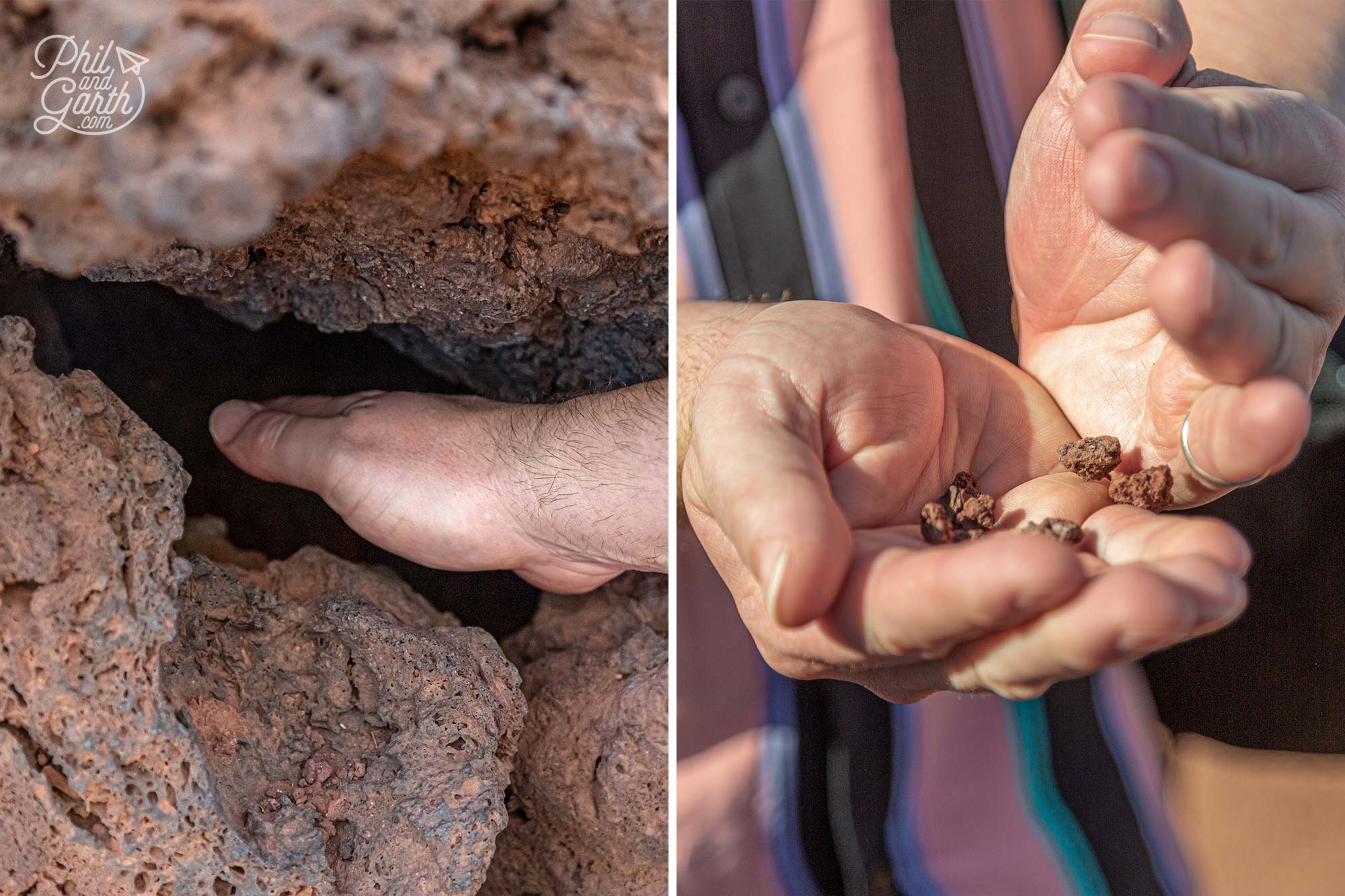
Feel the heat of the volcano by sticking your hand in a crack or picking up some gravel stones
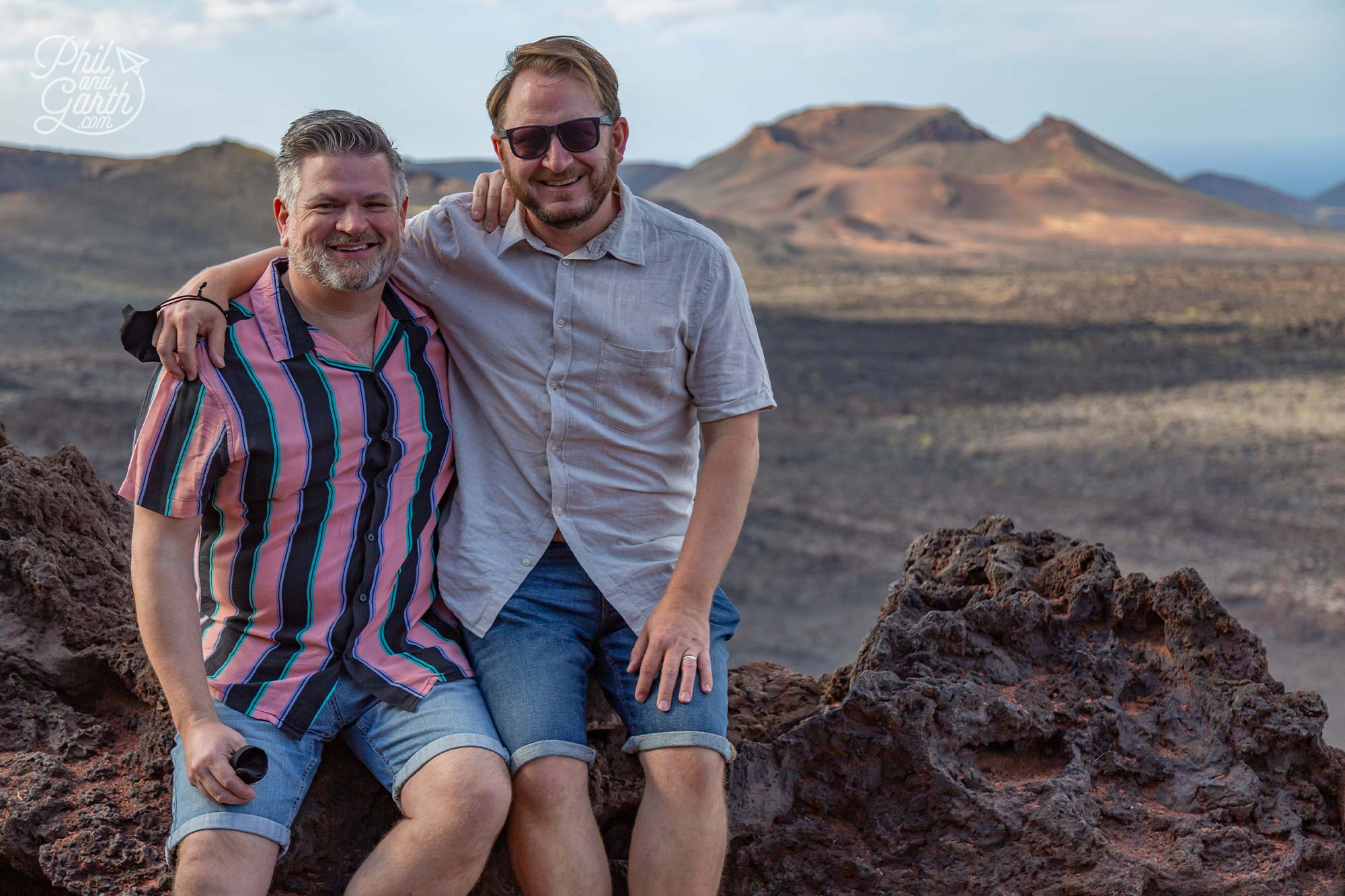
Phil and Garth at the Timanfaya National Park
The entrance fee to the park is €12 per adult and includes parking, geothermal demonstrations and the bus tour along the ‘Volcano Route’ (Ruta de los Volcanes). The Timanfaya Park is open from 9am to 5.45pm and the last bus tour is 5pm. We got here at 9am as parking is limited and it gets busy quickly, which means they then have to let cars in one at a time.
2. El Golfo ‘The Green Lagoon’
A 15 minute drive from the Timanfaya National Park is the Playa Del Charco De Los Clicos beach, more commonly known as El Golfo after the nearby village. This is Lanzarote’s famous ‘green lake’ named after a dramatic green lagoon that looks completely alien-like. It’s actually a volcanic crater and the luminous green colour comes from algae and sulphur in the salty water. It’s connected to the Atlantic Ocean via underground cracks. You can view it as we did from the elevated pathway or closer up on the black beach behind the fence. It’s quite touristy here, but worth a quick look.
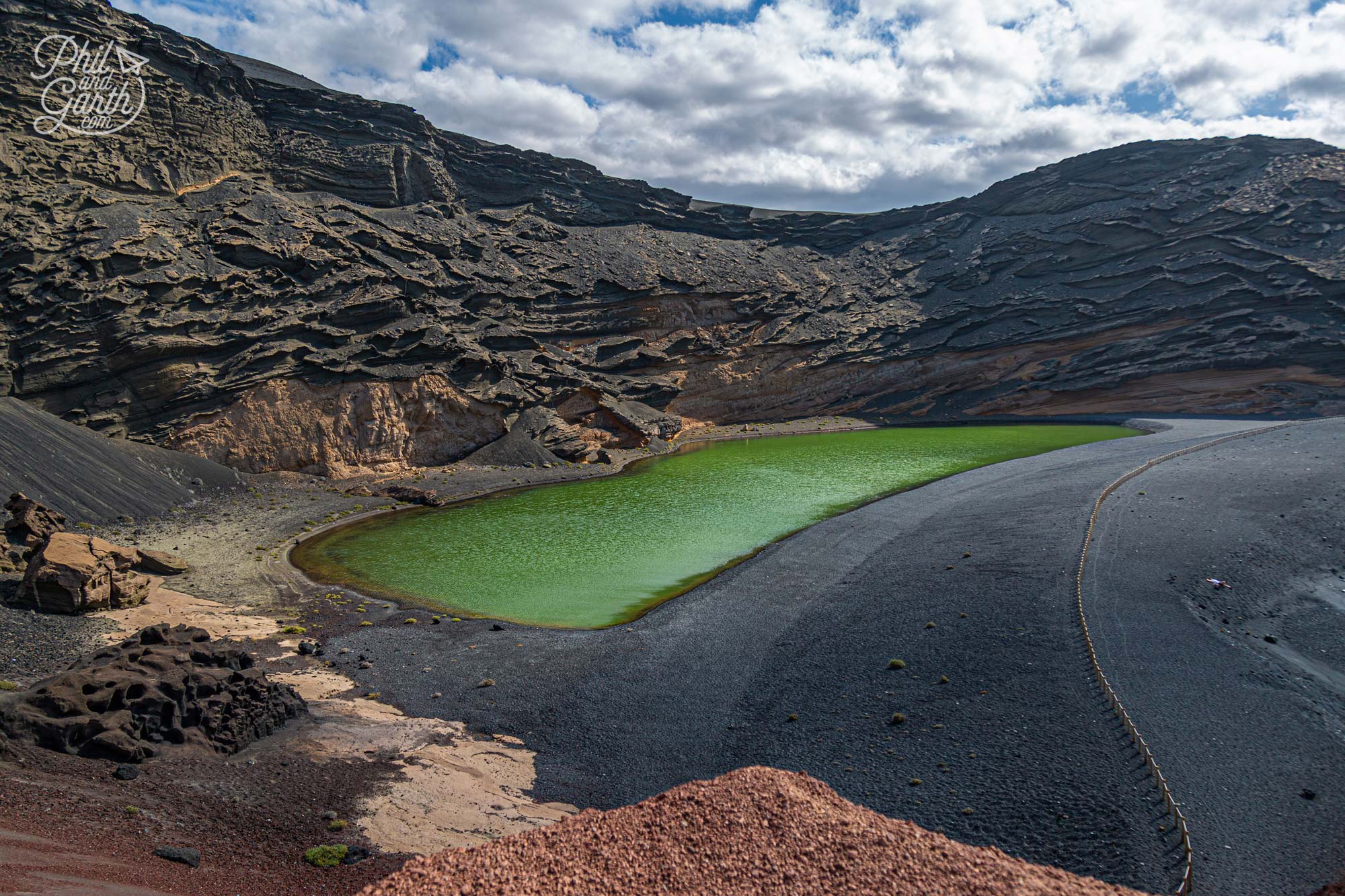
The striking El Golfo green lagoon is a crater from an extinct volcano
3. Jameos del Agua
Jameos del Agua is a series of volcanic caves transformed by César Manrique into a restaurant, nightclub and cultural centre between 1965 to 1968. He wanted to create the most beautiful nightclub in the world. A concert hall, bar and restaurant were added in later years, completed in 1977. Jameos del Agua was our favourite must-see sight of Lanzarote.
Jameos del Agua is part of the world’s longest underground volcanic tunnel. The tunnel was formed when boiling lava flowed and hardened on the outside, leaving the inside hollow. There are collapsed openings in the tunnel’s ceiling to the sky which are called jameos, similar to sinkholes. There are 3 openings here to explore.
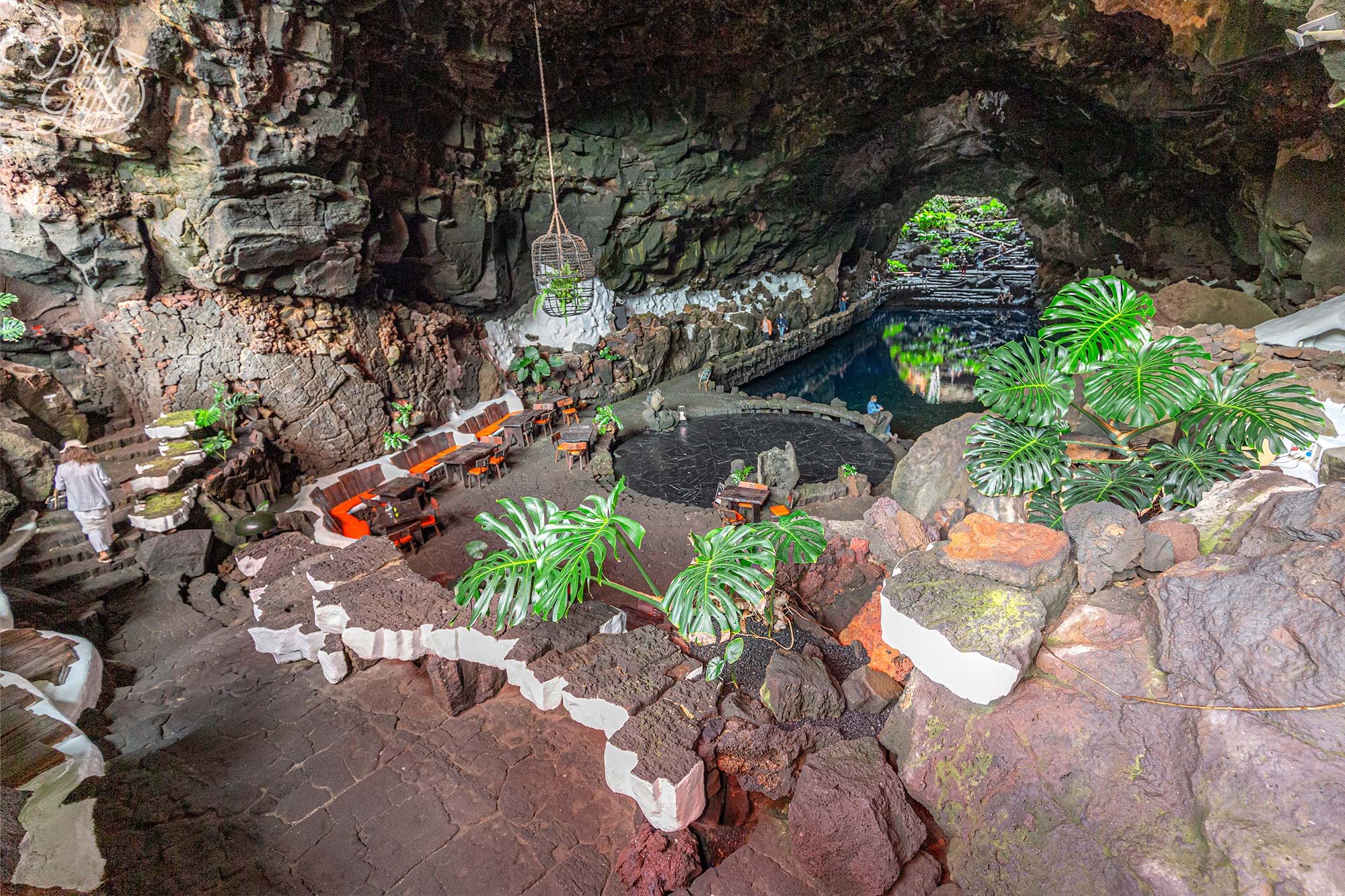
Jameos del Agua – César Manrique’s lavish entertainment venue from the 60s and 70s
We started at the first jameo which is their lovely restaurant. The setting is stunning, where we felt like a villain in a James Bond 1970s movie set. We stopped here for lunch, which we highly recommend doing. Phil ordered the beef and Garth had a fish dish, both delicious and so relaxing with the ambient music playing in the background.
It’s so chic, we could imagine it must have been THE place in the 70s where the beautiful people came to party on the wooden dance floor. The restaurant definitely boasts a unique setting on Lanzarote to eat dinner. On selected dates, you can dine at night for a concert and dinner, called Jameos Nights.
From the restaurant, we walked down into the cave which is absolutely enormous, the natural saltwater lagoon is where thousands of tiny blind albino crabs live in the perfectly clear water. They’re known as Jameitos and are so rare they’re not seen anywhere else in the world.
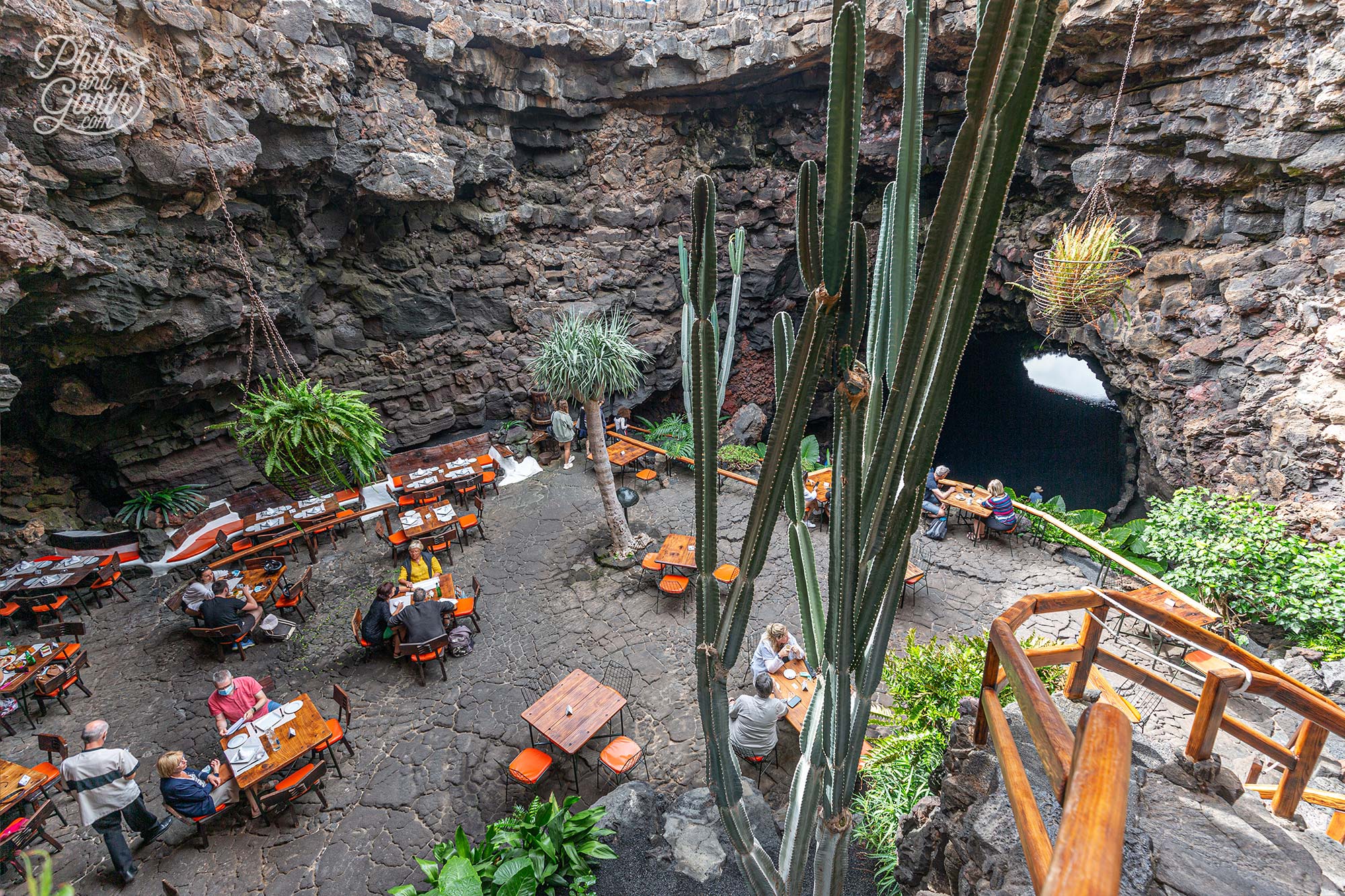
The most fabulous location for lunch at the cave restaurant
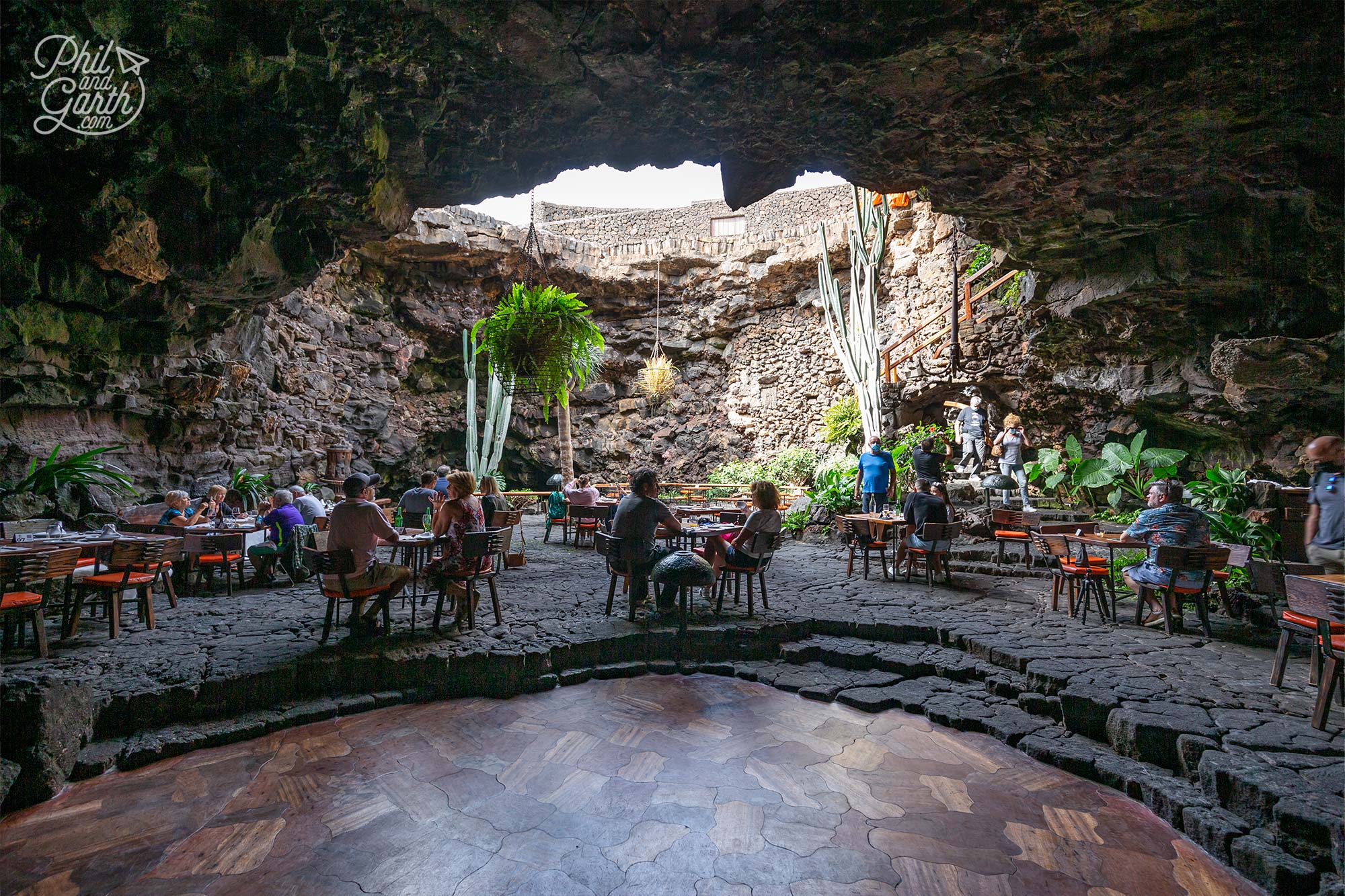
You can just imagine the beautiful people dancing on this dancefloor in the 70s
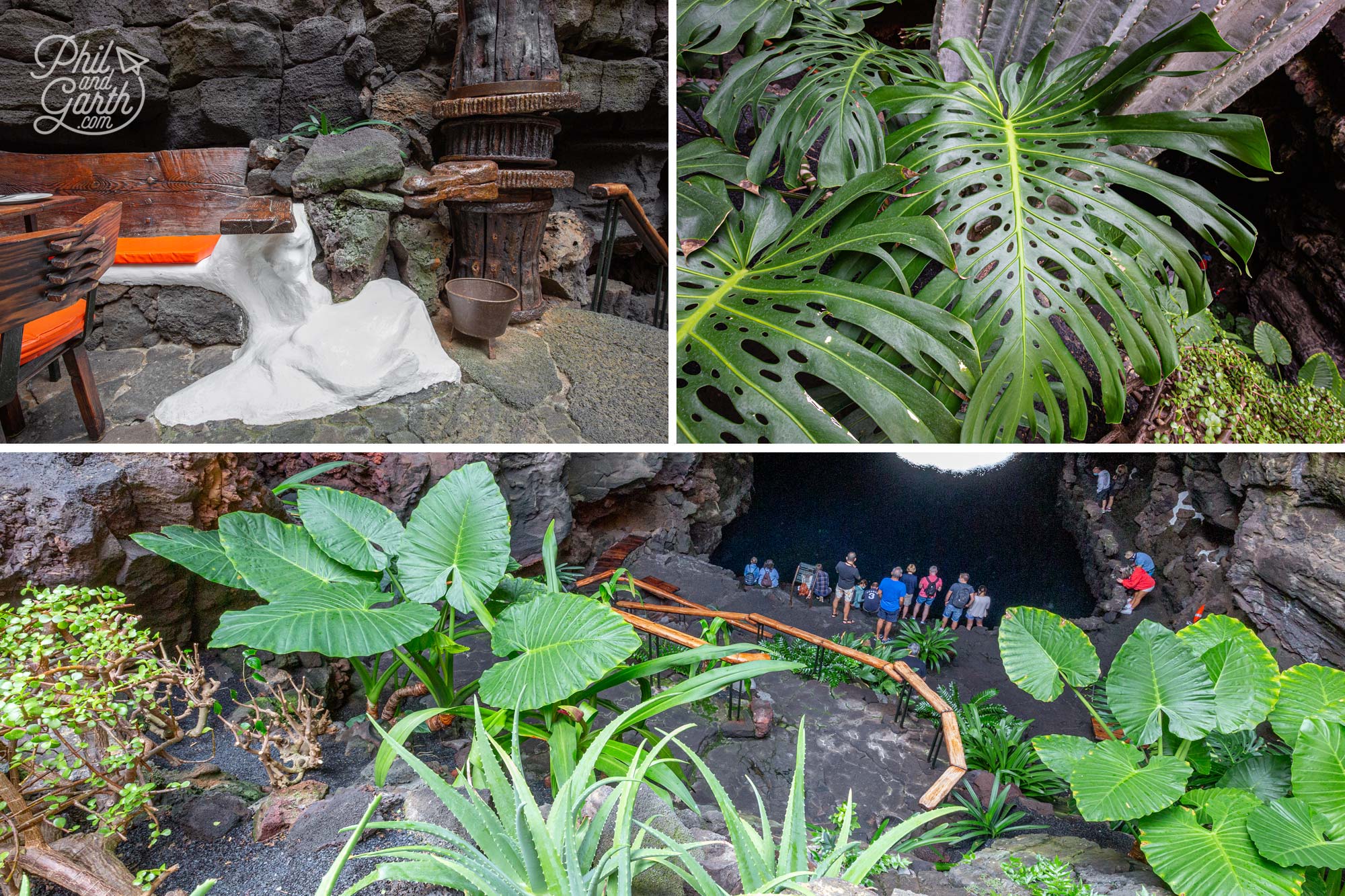
Love the gorgeous Monstera leaves against the black volcanic rock
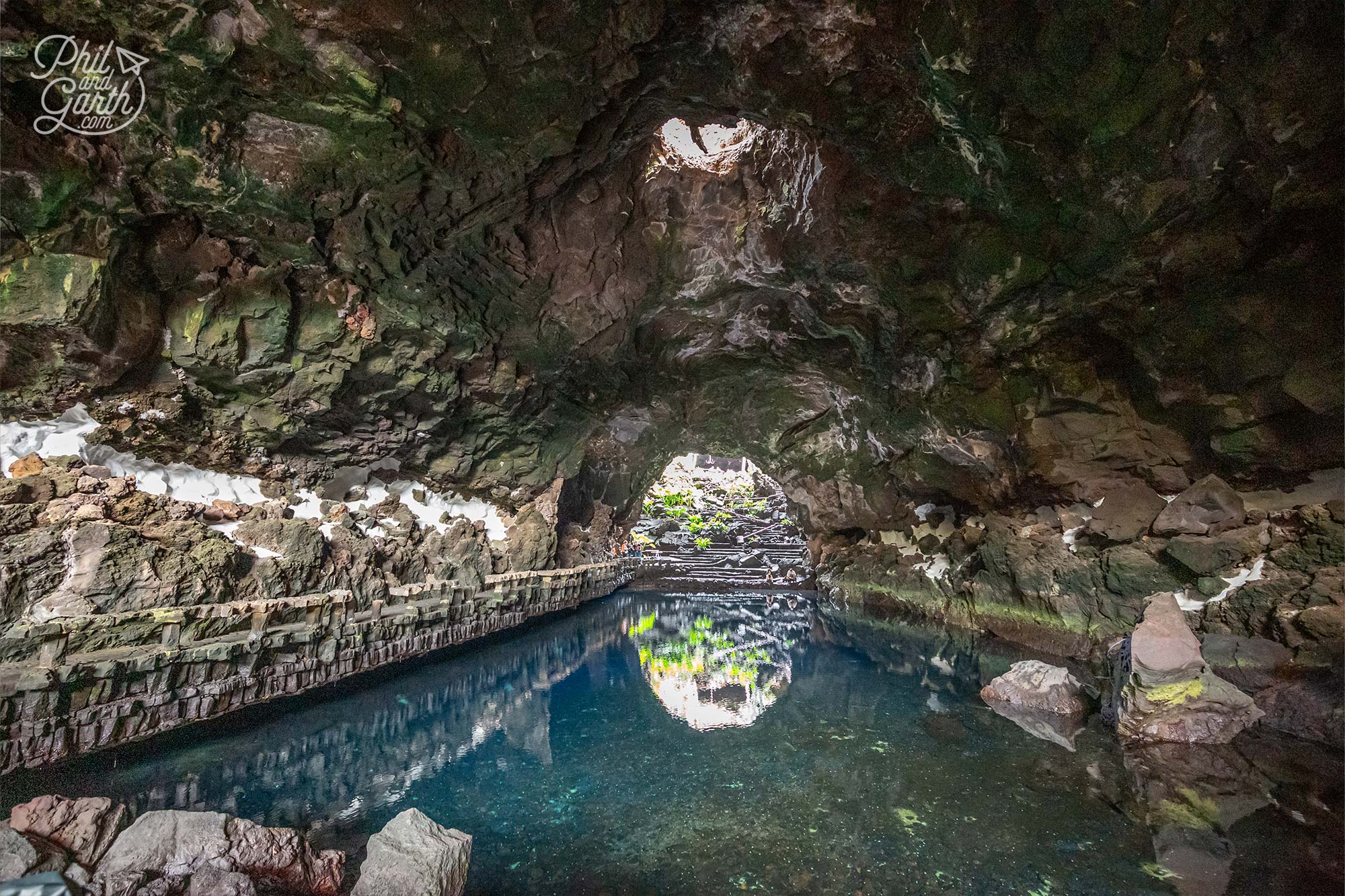
The clear saltwater lake is home to tiny blind albino crabs that have adapted to the dark
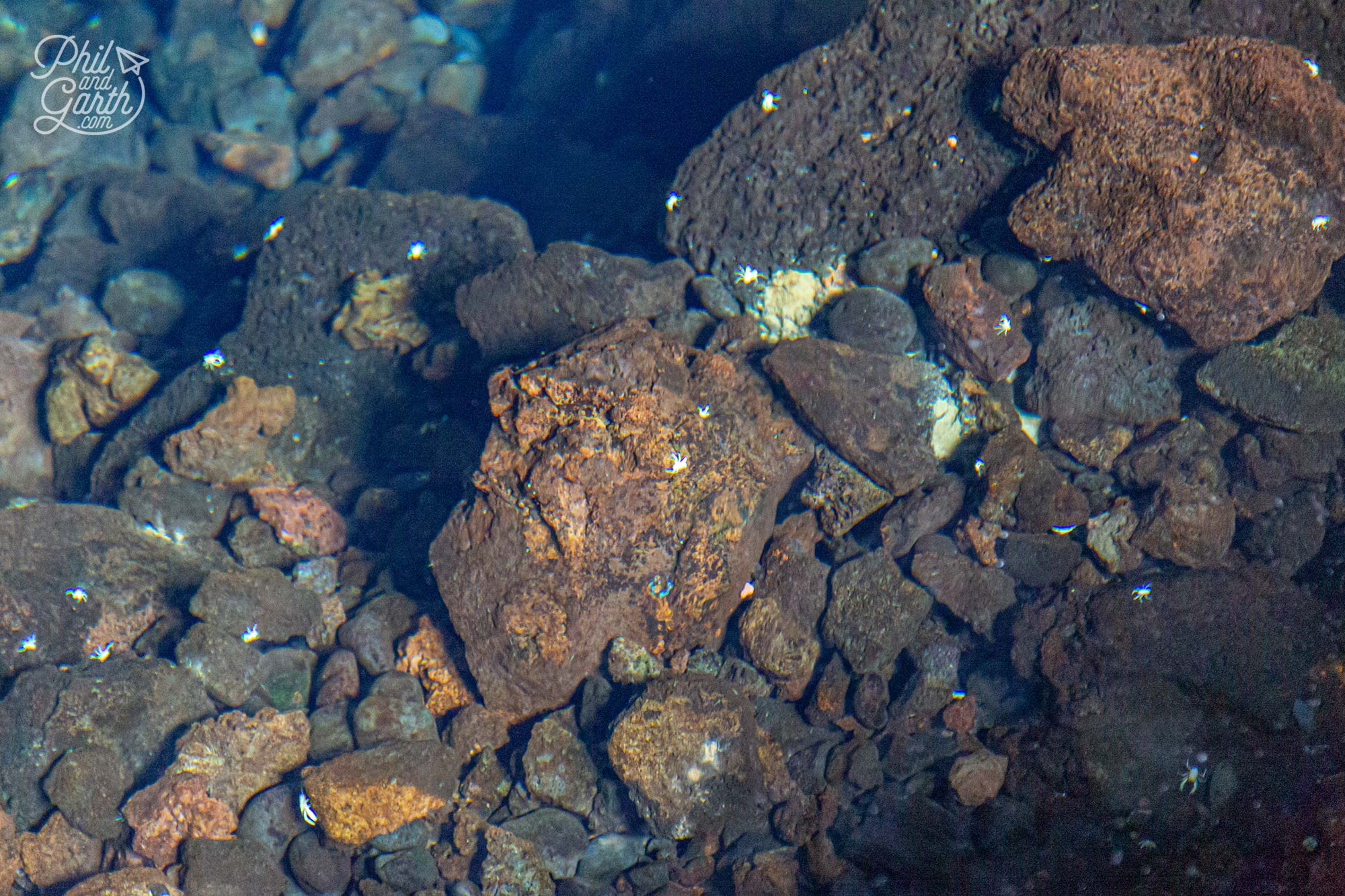
The tiny ‘Jameitos’ albino crabs
When you come back up to the open-air you are presented with an impressive garden and the most gorgeous swimming pool we’ve ever seen. The garden is made up of cactus, fig trees and even a 100 year old palm tree stretching out over the swimming pool water. Phil loved the intense blue of the kidney shaped pool, which looks so inviting! Apparently, it’s said the only person allowed to take a dip here is the King of Spain.
Next to the pool is the third jameo which holds a full size 550 seater auditorium. Live music concerts and traditional local folk music shows are still held.
It’s all so exotic and tranquil here. We loved exploring the sculptures, gardens and fabulous spaces. Manrique’s skill was understanding the beauty of the volcanic landscape and working with it, rather than completely transforming it. The way he harmonised art and nature is just beautiful. Garth loves his signature white walls and how they contrast into the black volcanic rock.
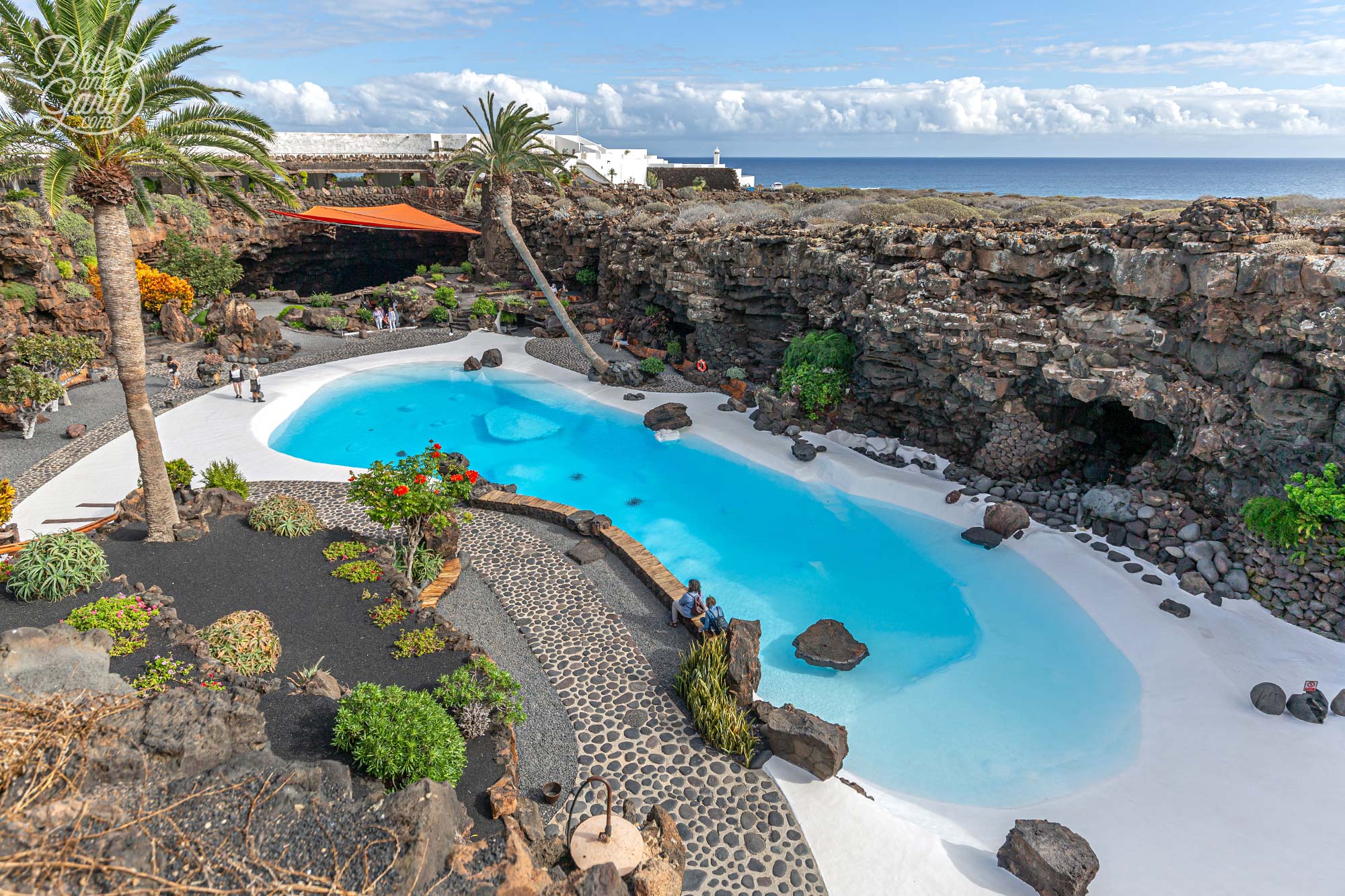
Apparently only the King of Spain is allowed to swim here
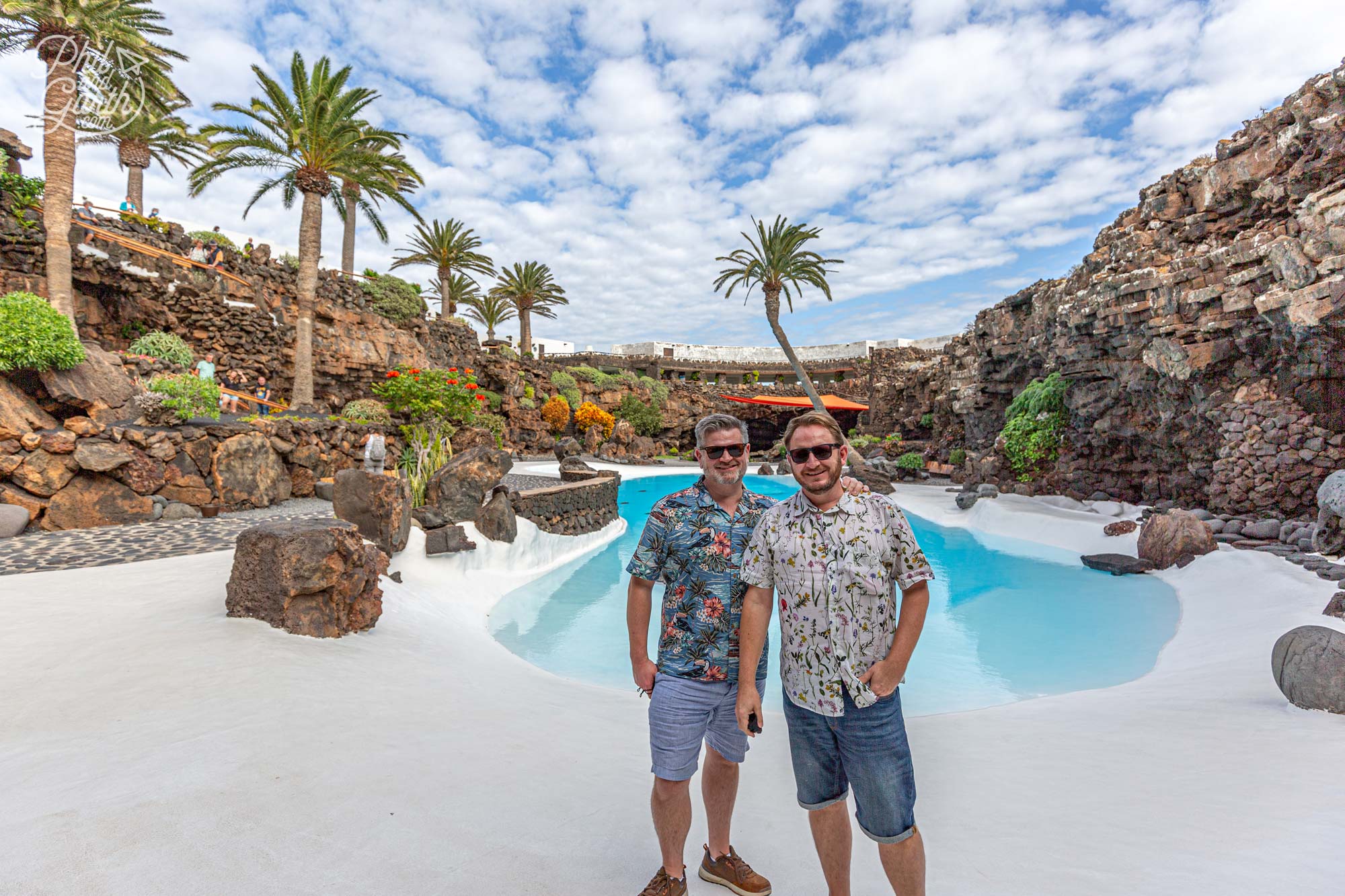
Next to the most beautiful turquoise paradise pool
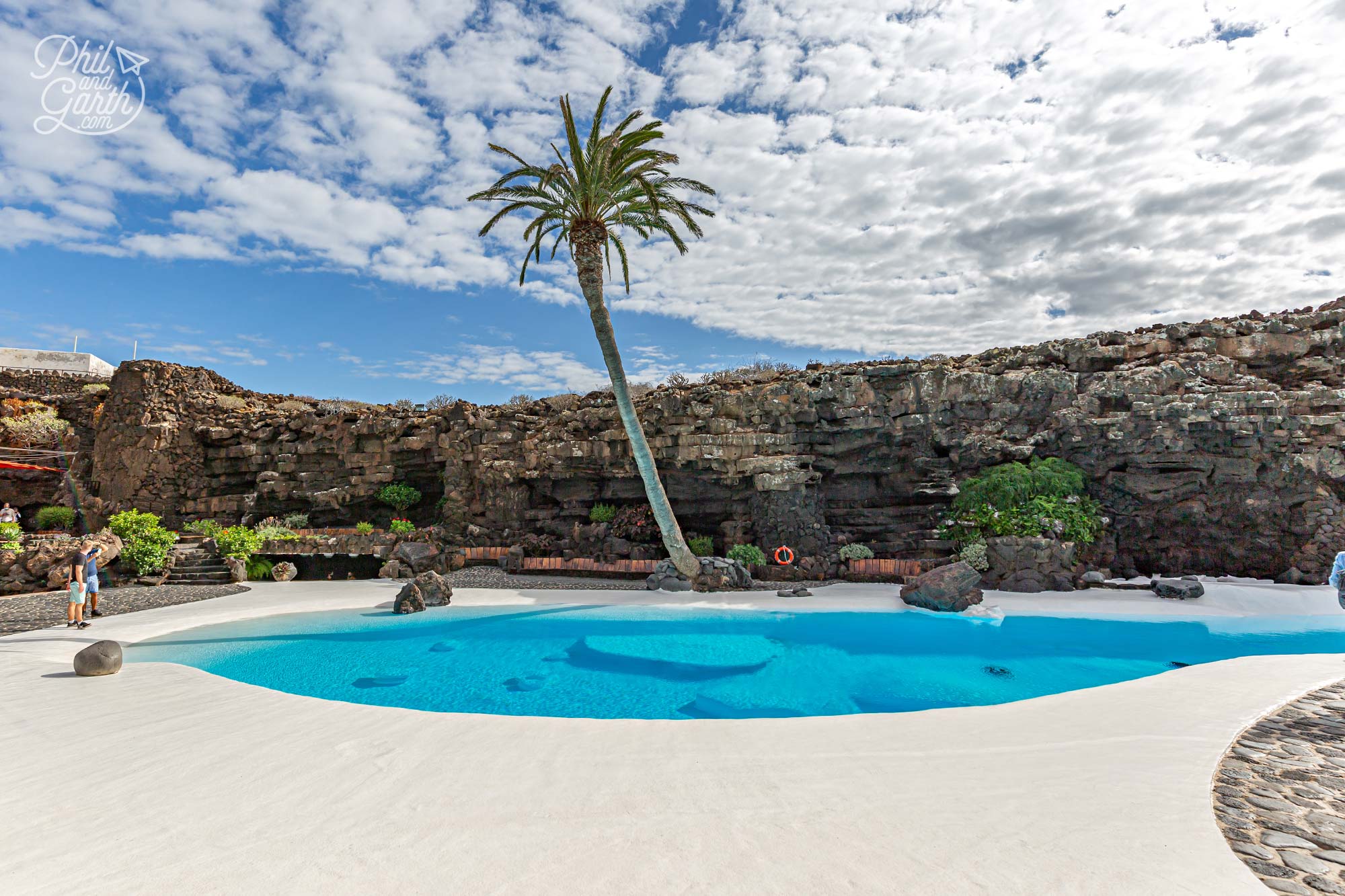
A 100 year old Canarian palm tree stretches over the swimming pool’s water
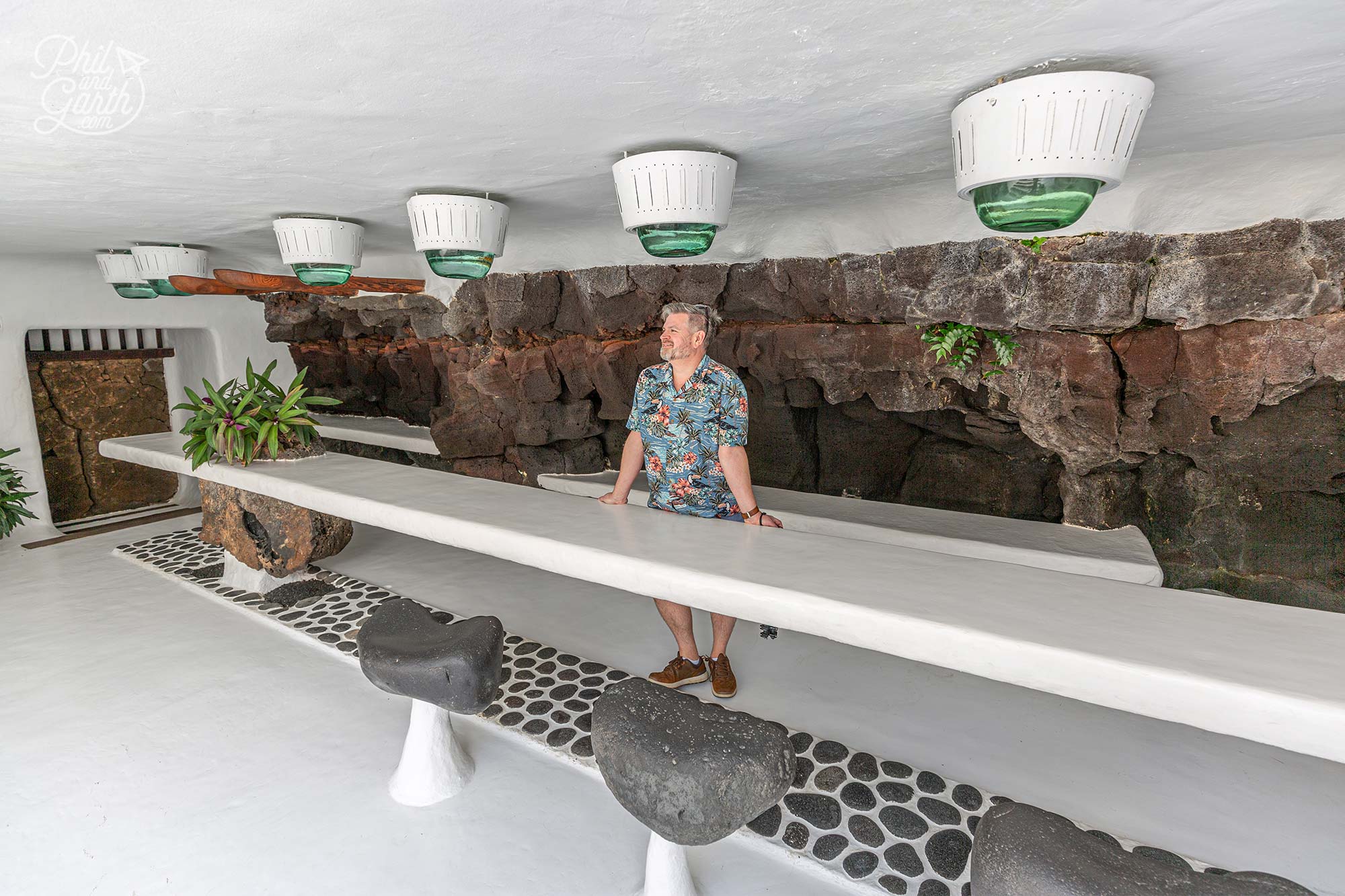
Just love César Manrique’s signature white walls and surfaces
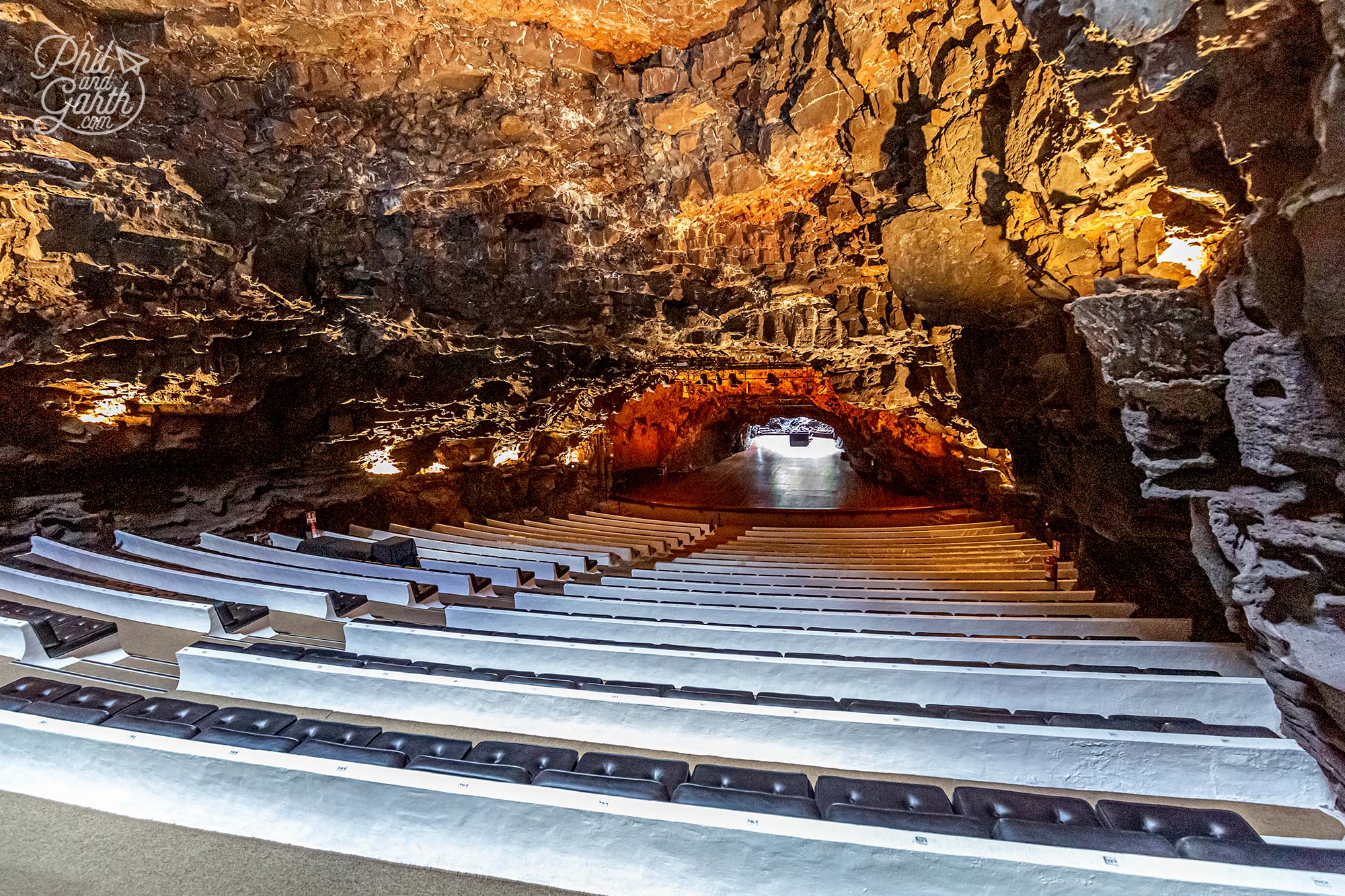
The cave concert hall hosts live music concerts and traditional local folk music
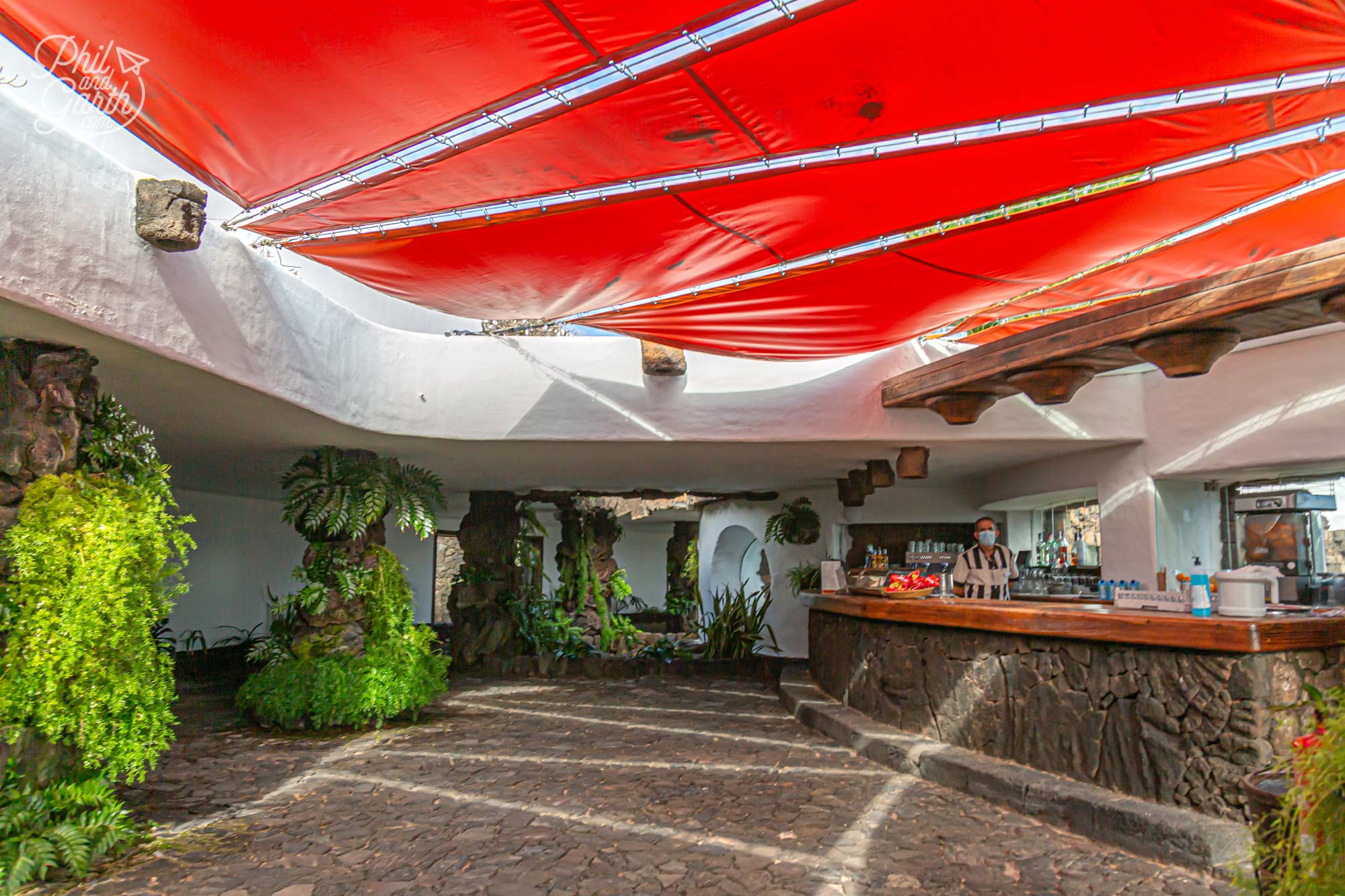
The bar at Jameos del Agua
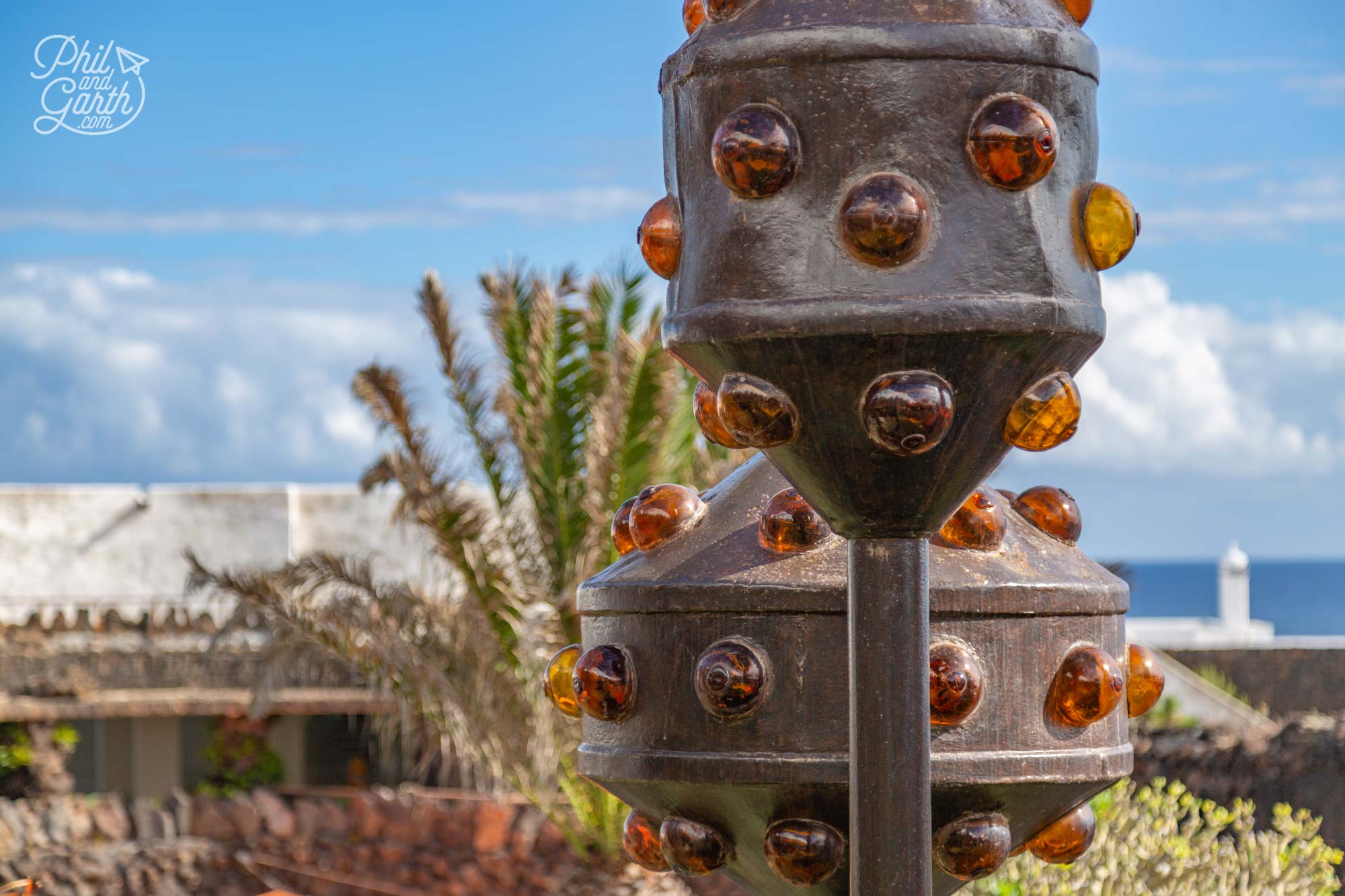
One of César Manrique’s abstract sculptures in the garden
Jameos del Agua is open everyday from 10.00am to 6pm, last entry is 5.15pm. An adult ticket costs €10.
4. Mirador del Rio
Mirador del Rio is a lovely viewpoint designed by César Manrique and built in 1973. It offers panoramic views across the Atlantic Ocean from an elevated position 400 metres high.
Manrique converted an old military lookout post into a perfectly camouflaged building that blends into the rock and the environment. It looks very unassuming from the outside at the car park. However hidden inside is a contemporary and somewhat futuristic looking space with curvy shapes and abstract sculptures. Featuring a nice cafe where had a cafe con leche.
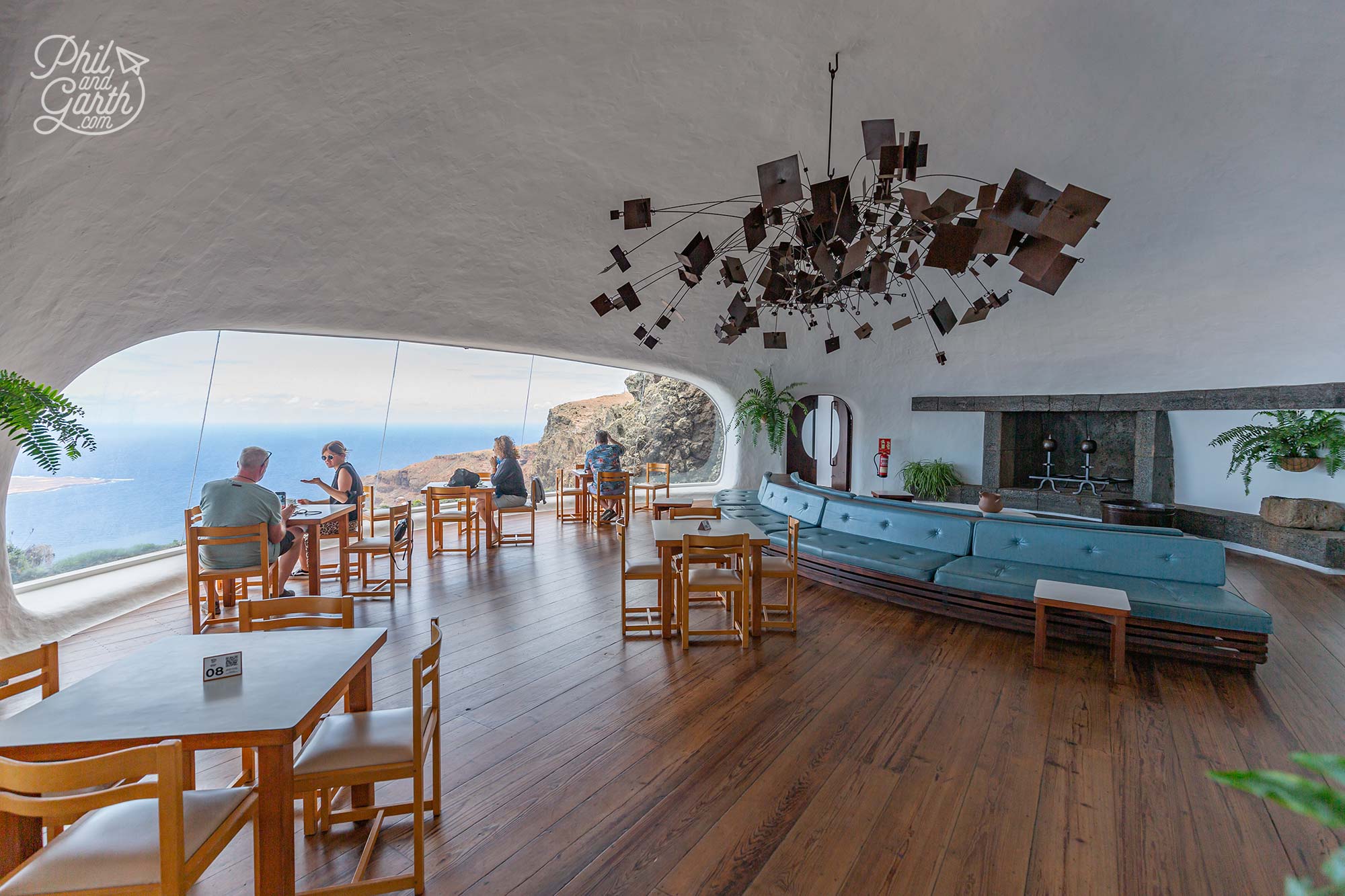
Mirador del Rio’s fabulous futuristic and contemporary interior built in 1973
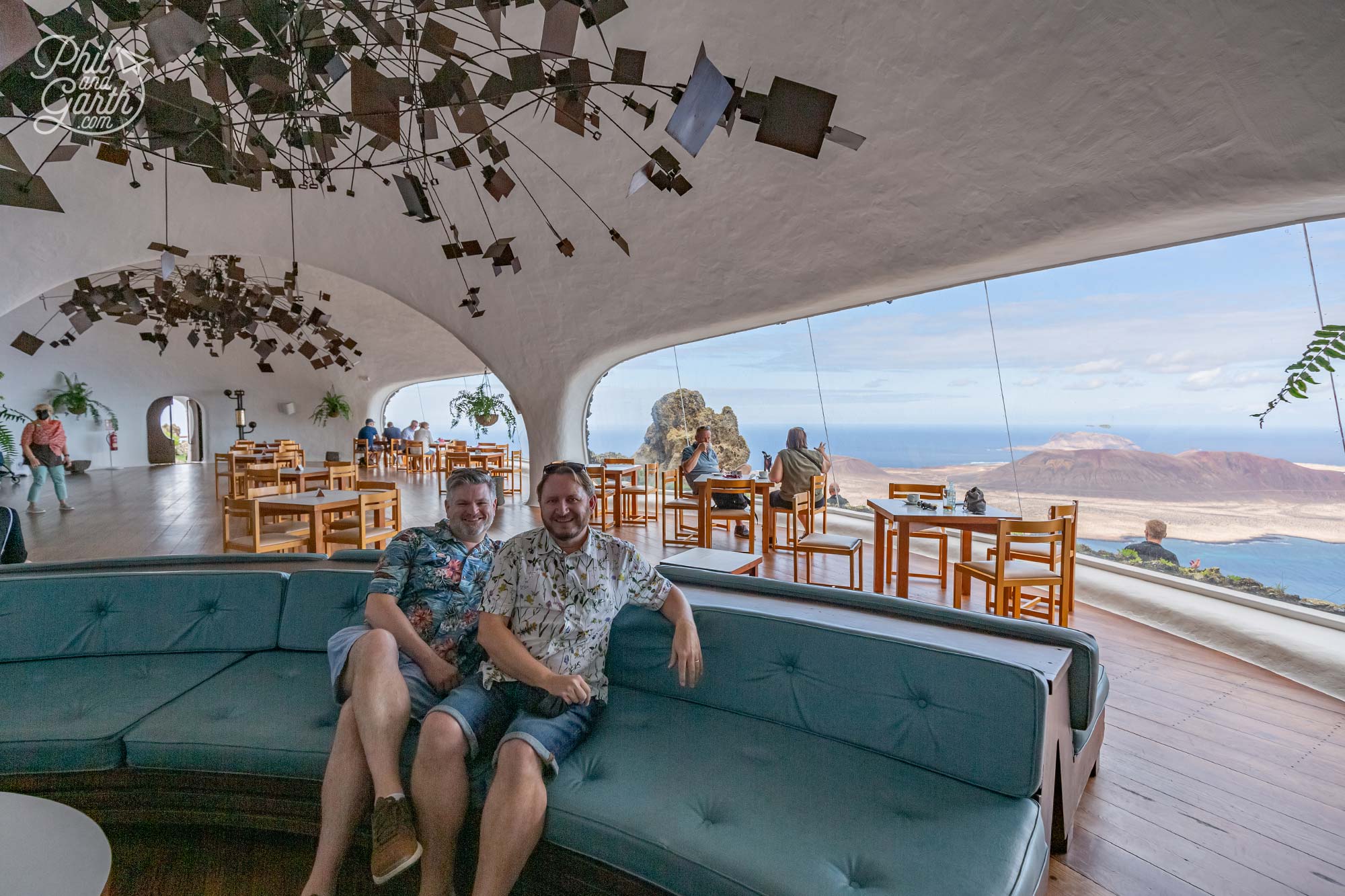
Amazing sculptures hanging from the ceiling look like they are defying gravity
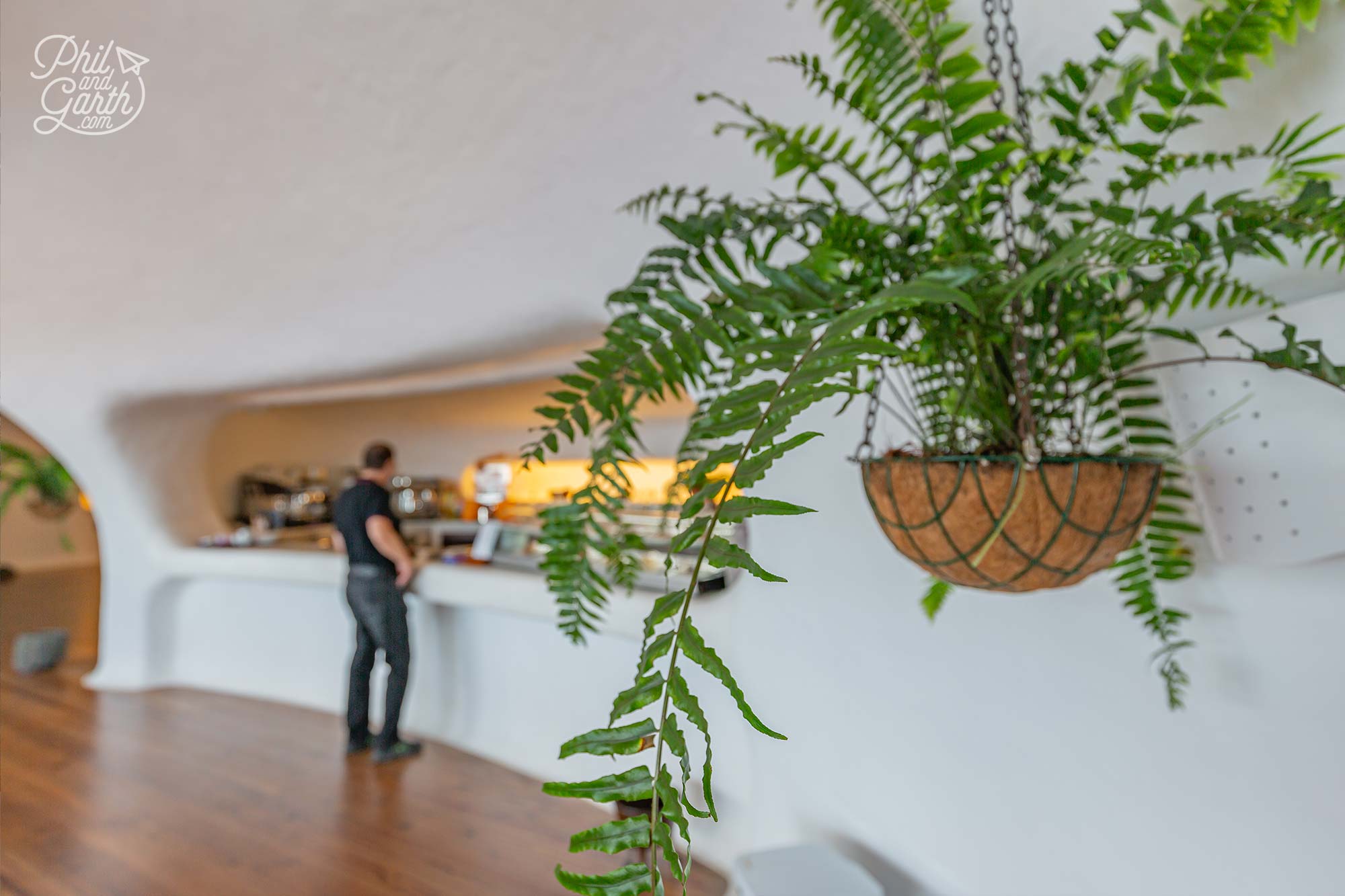
The curvy shaped bar and love the ferns in hanging baskets
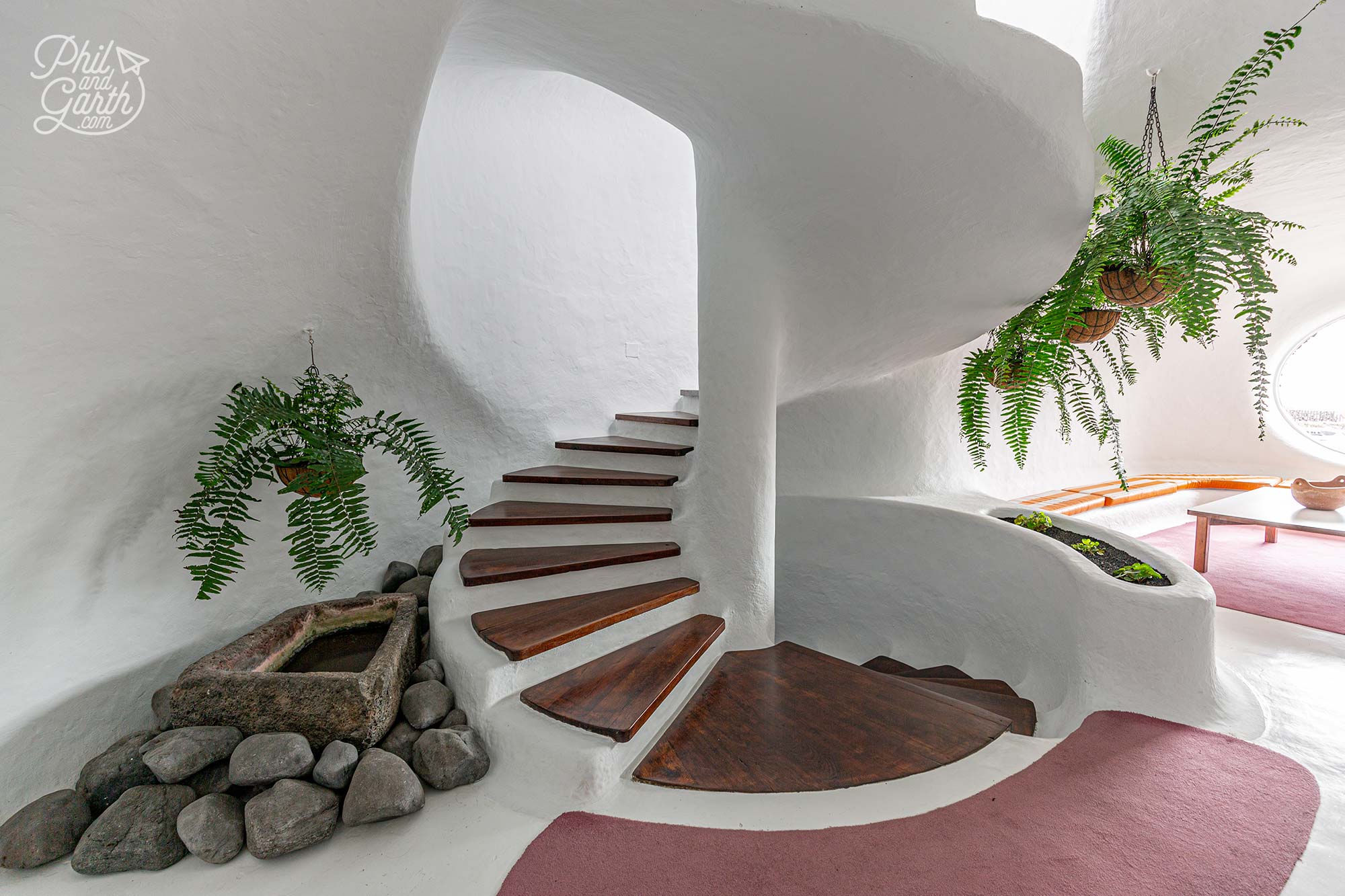
Love this spiral staircase with wooden steps inside the Mirador del Rio
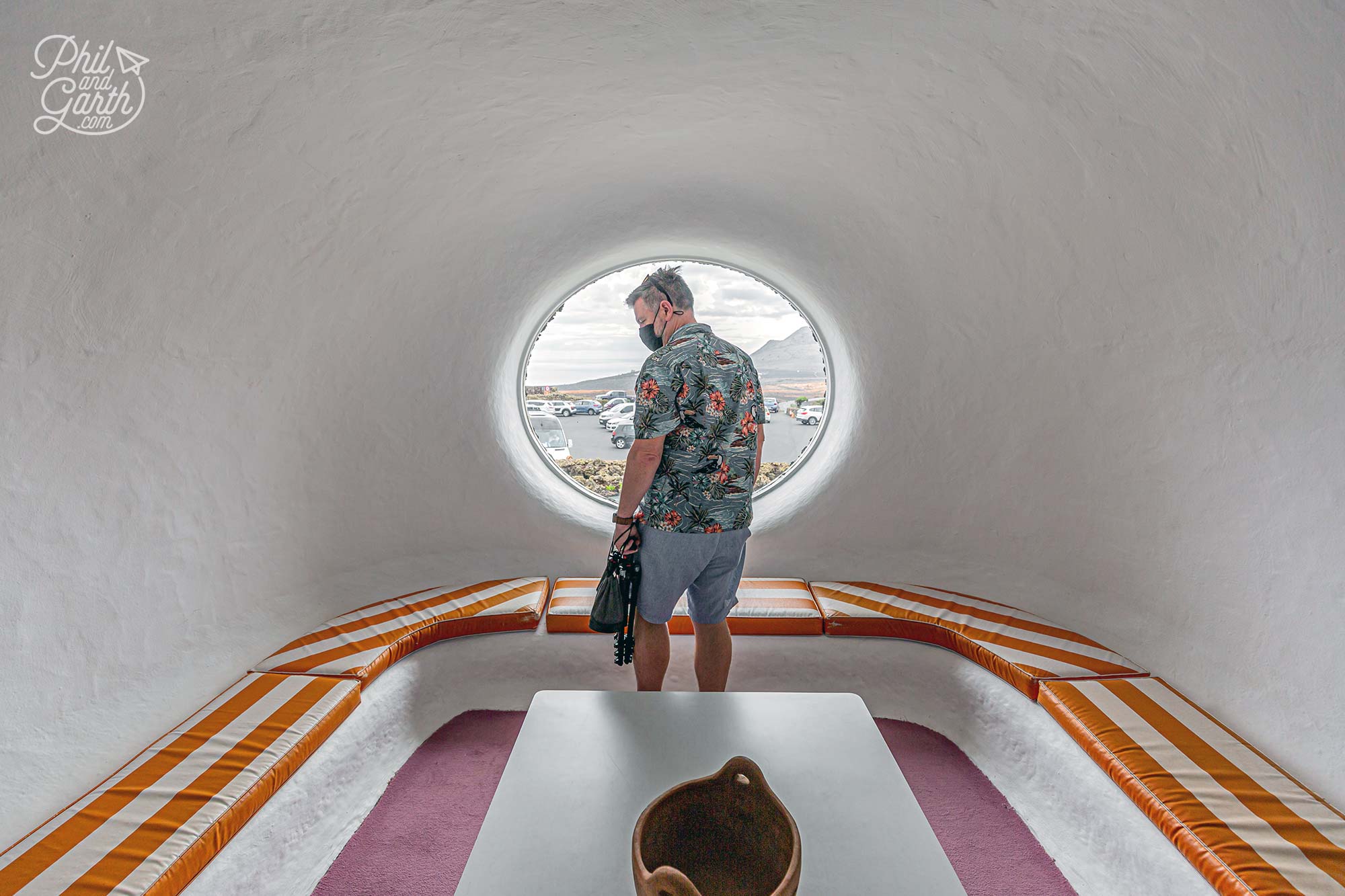
Phil checking out another cool interior space
Outside from the viewing balcony you can see the 8th Canary Island, La Graciosa and a group of islands which make up the Chinijo Islands National Park. If you have a pair of binoculars it’s a good idea to take them here. This northern part of Lanzarote is a protected UNESCO Biosphere Park.
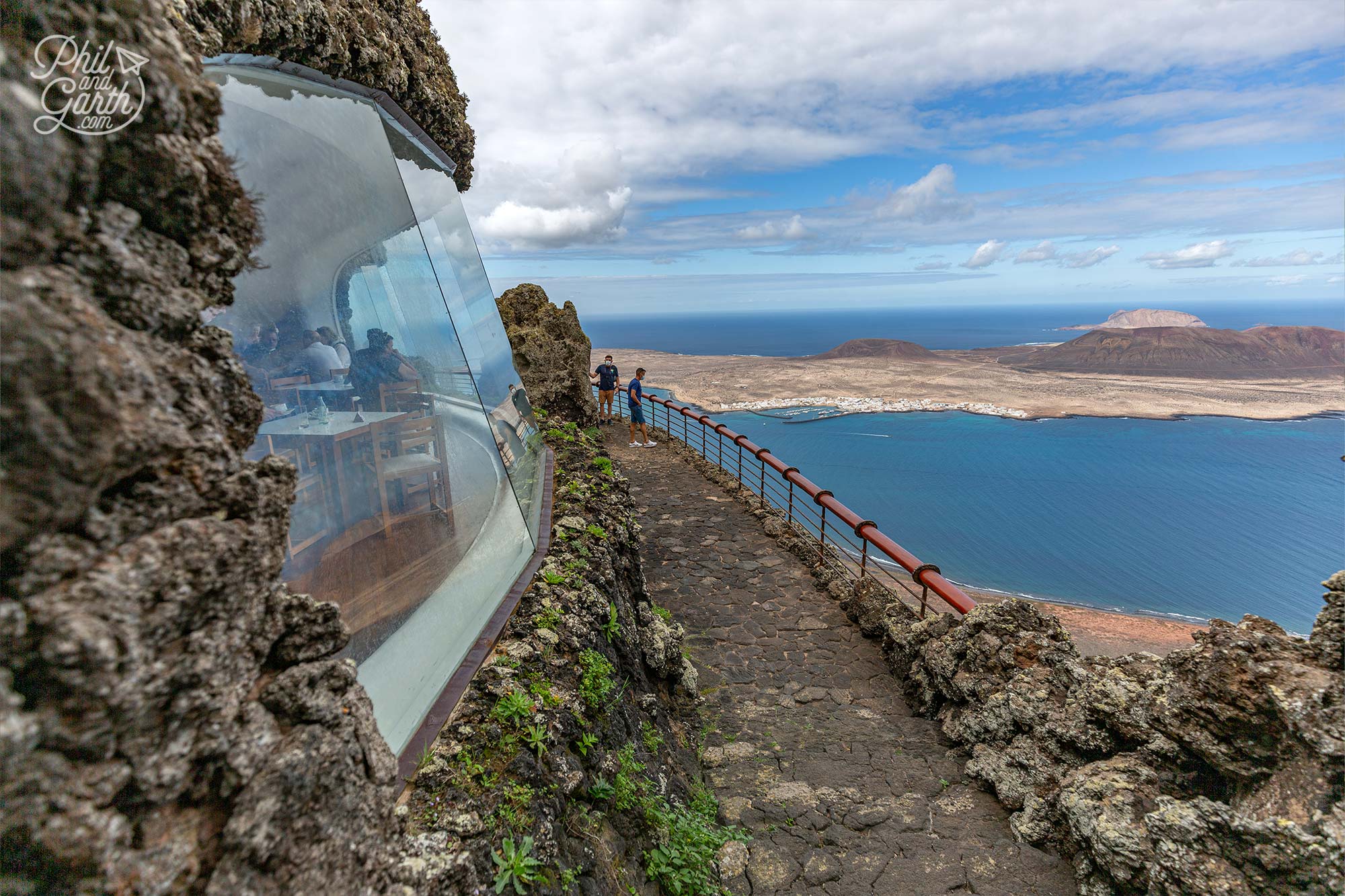
Mirador del Rio is blended perfectly into the volcanic rock landscape
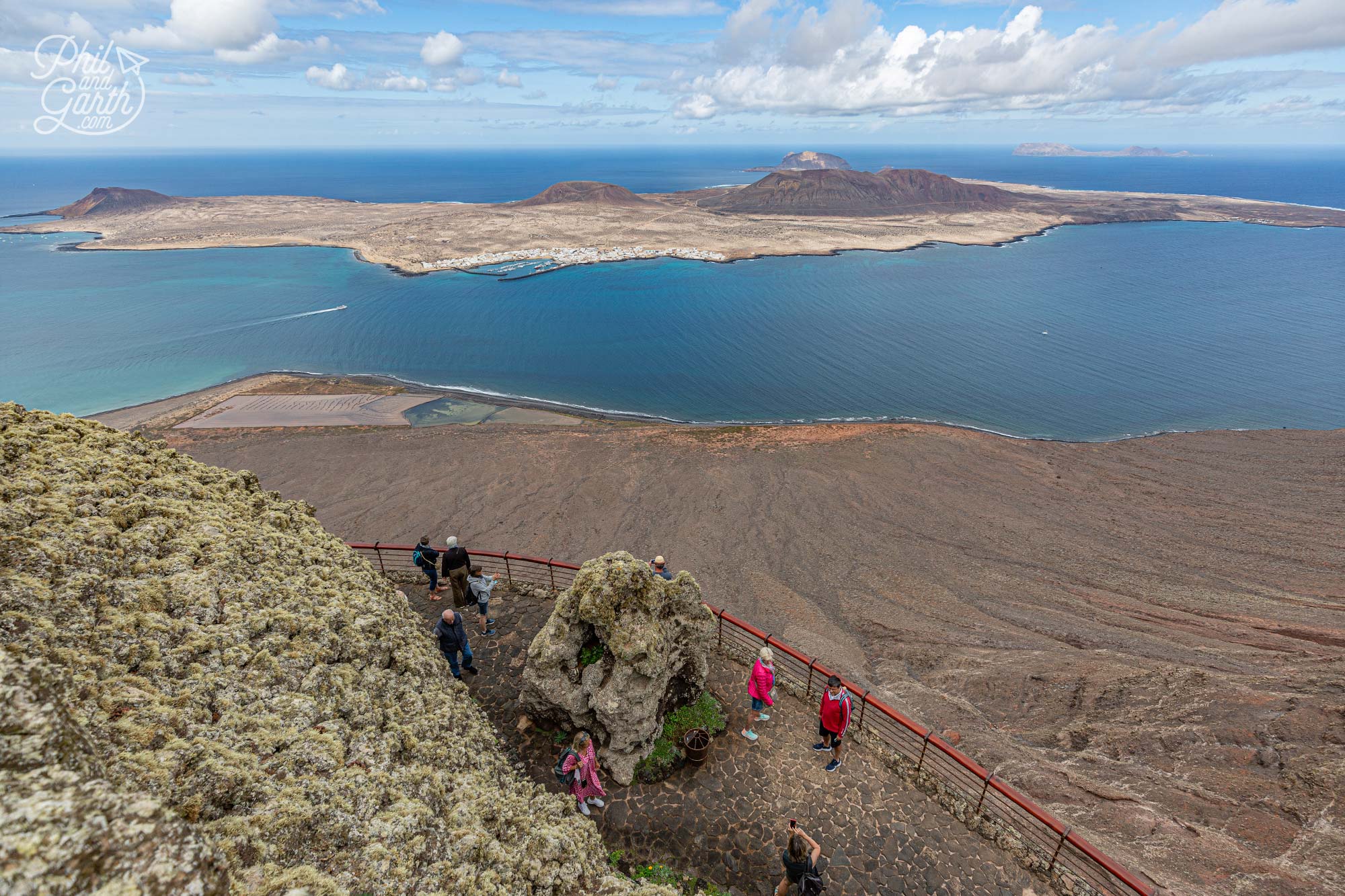
Views across to the 8th Canary Island La Graciosa and the Chinijo Islands National Park
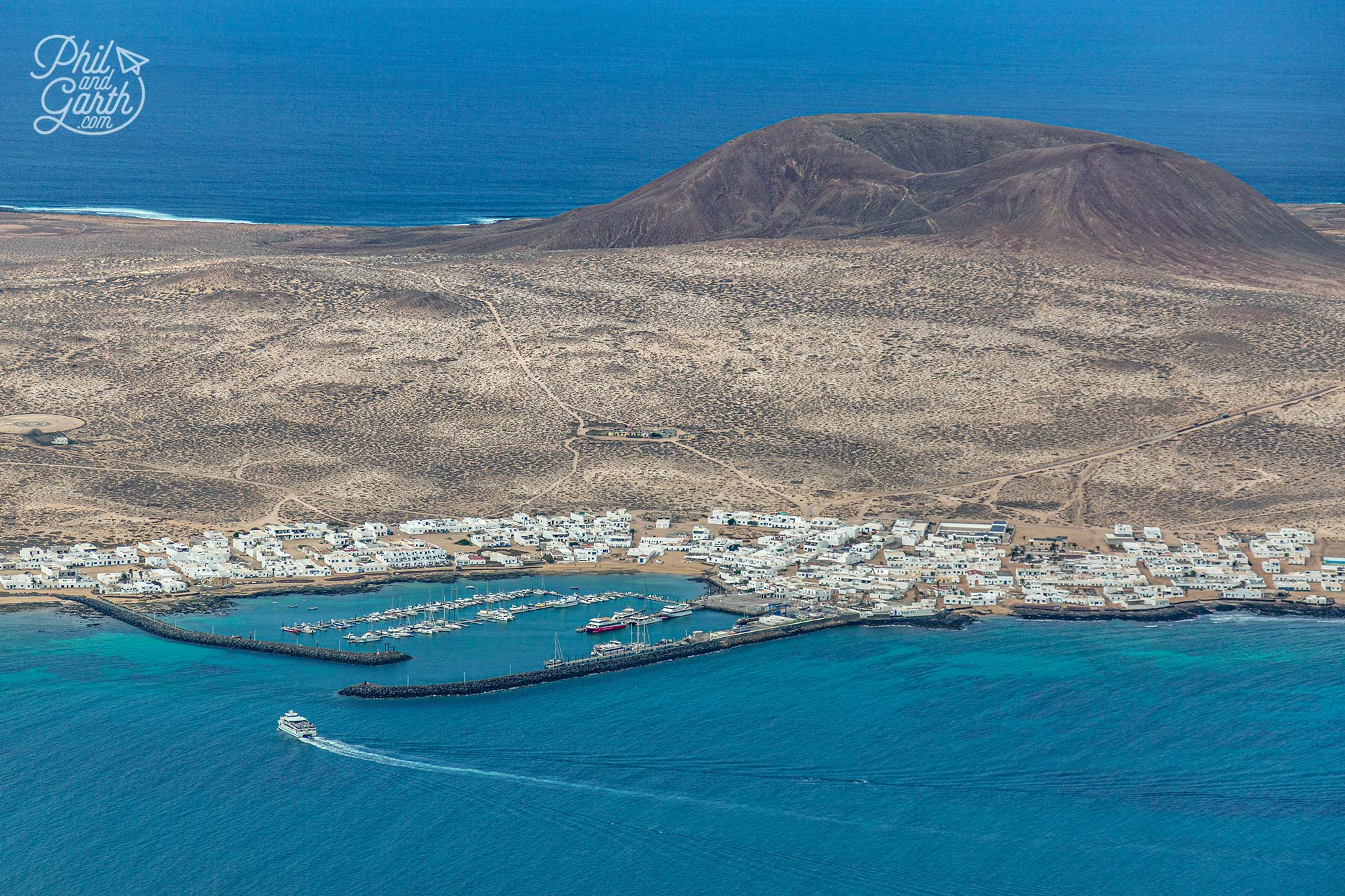
You can get a ferry from Lanzarote to La Graciosa – there are no tarmac roads on the island
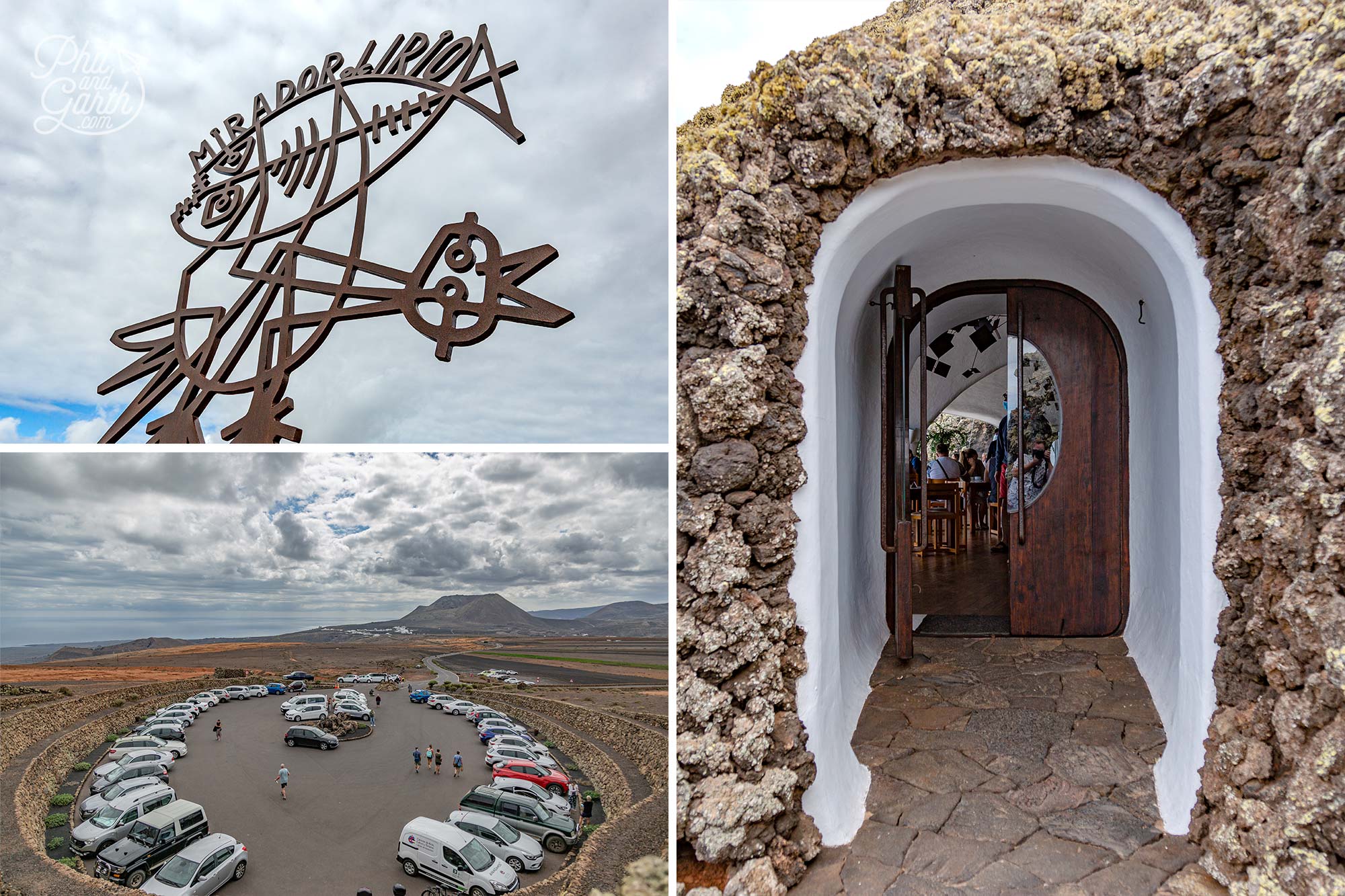
We’re loving the César Manrique designed Mirador del Rio
Mirador del Rio is open everyday from 10am to 5pm. An adult ticket costs €5 and the car park is free.
5. Casa Museo del Campesino
Located right in the middle Lanzarote in what appears to be the middle of nowhere is the Casa Museo del Campesino. It’s a museum and cultural centre built in 1968 by César Manrique as a tribute to Lanzarote’s indigenous people and as a sustainable tourist attraction. It’s a glimpse into Lanzarote’s past life when farmers struggled to rebuild the island after volcanic eruptions. The museum consists of a few buildings painted in typical white and green – a traditional style of farmer’s houses that hasn’t really changed for centuries. The outdoor exhibits showcase farming implements used by farmers and animals.
At the restaurant you can sample tapas and traditional dishes not easy to find elsewhere like goat’s meat stew or octopus with Canarian mojo sauce. Head down the spiral staircase past some huge monstera plants to see the impressive underground event restaurant. There are also a few artisan shops selling locally made crafts like soaps, jams, pottery and local goat’s cheese. These artisans also perform demonstrations of their crafting traditions like hat making and pottery making. You can even have a go yourself at making some of the handicrafts or cook up some Canarian mojo sauce for a small fee.
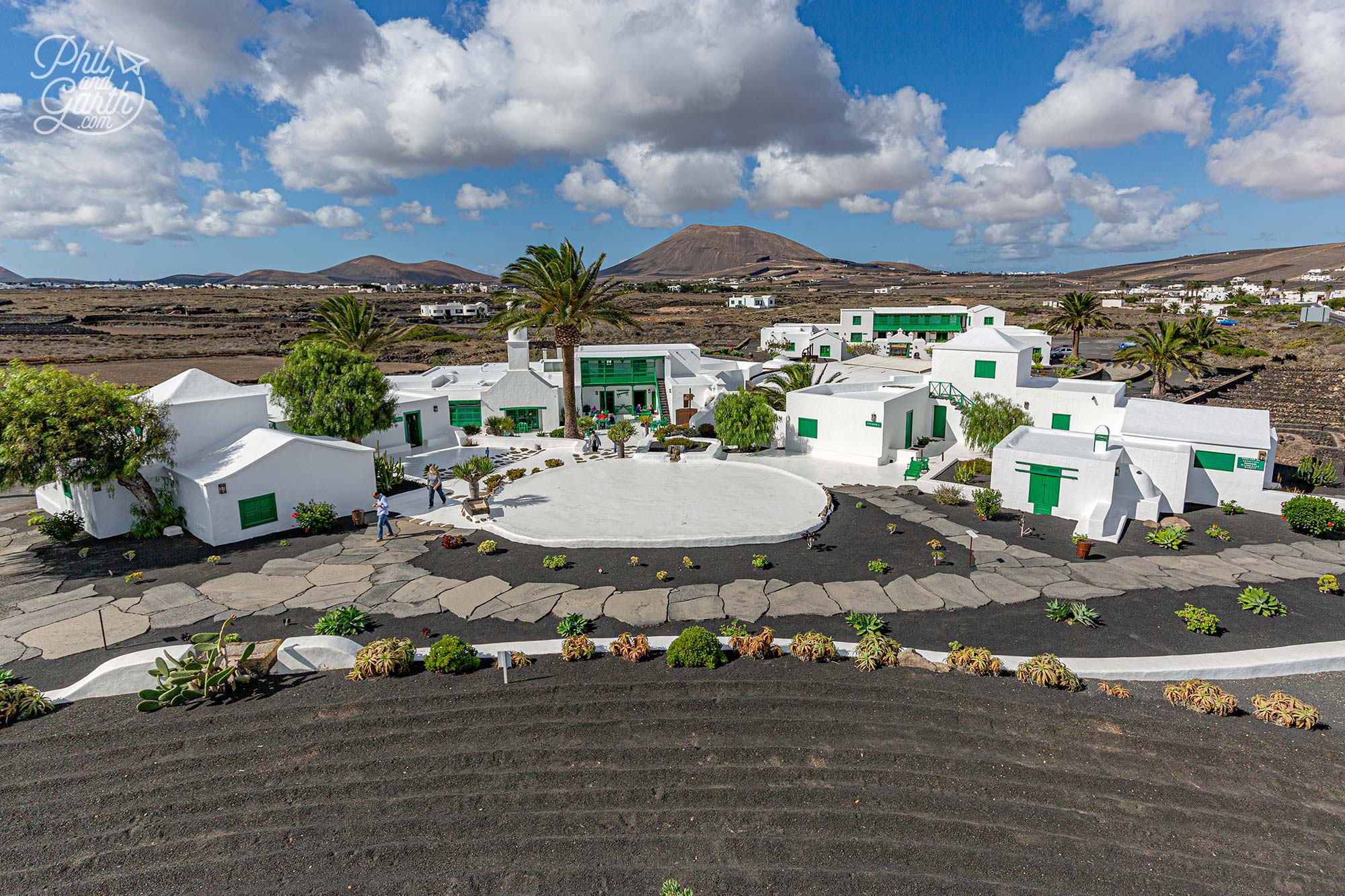
Casa Museo del Campesino – a museum and cultural centre
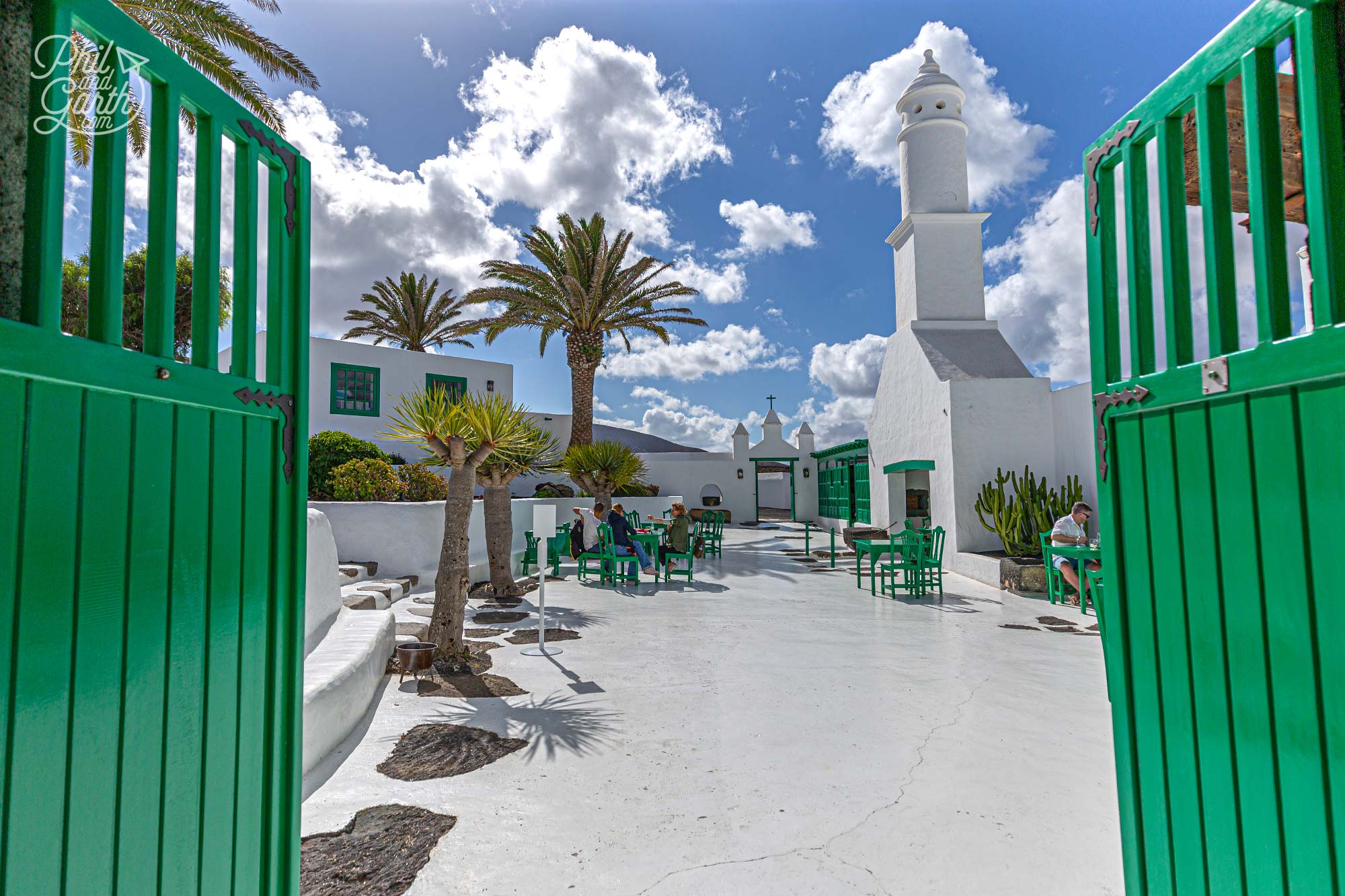
Designed by César Manrique in 1968
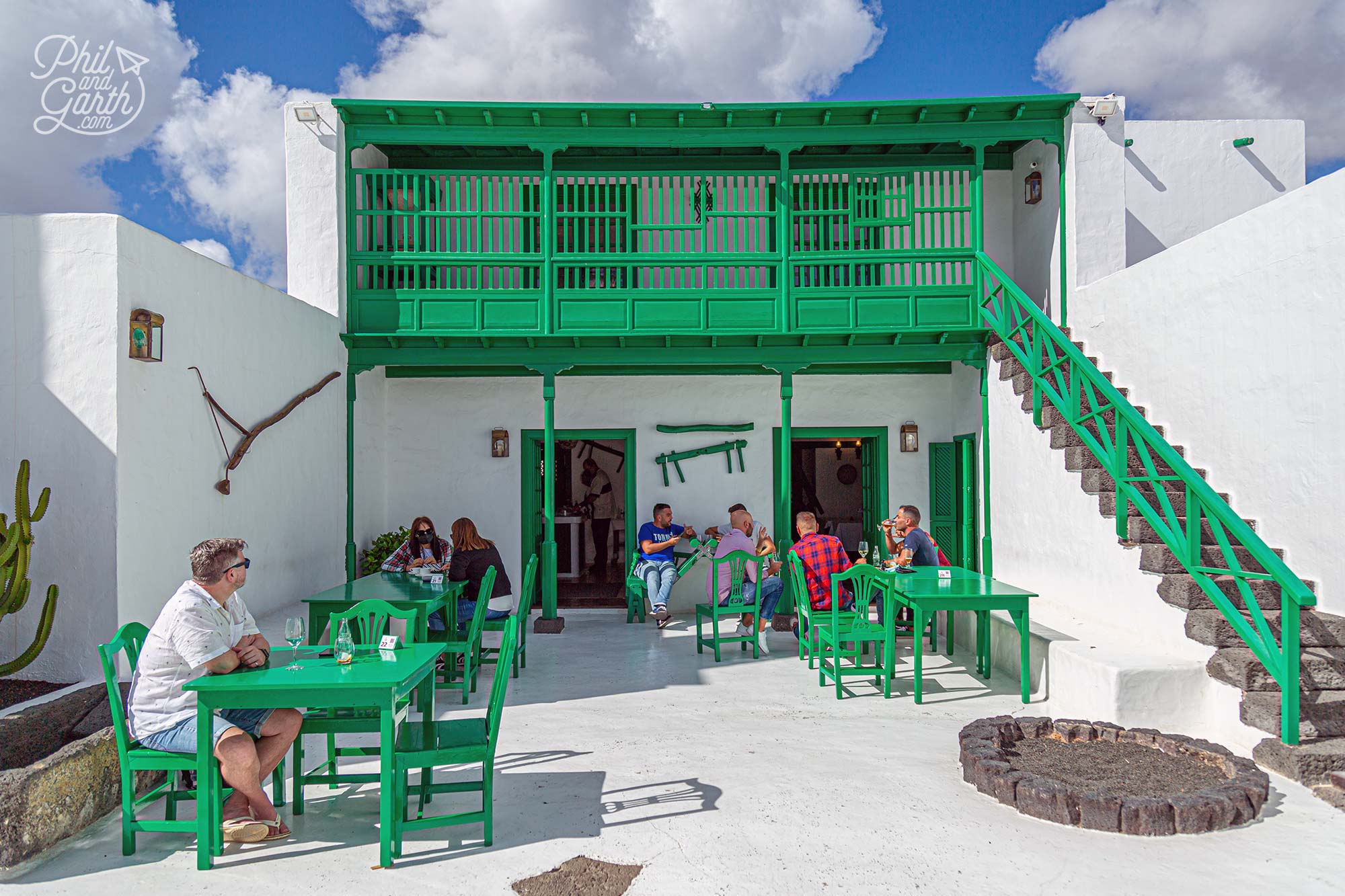
The bar painted in buildings painted in a traditional Lanzarote farmer’s style of white and green
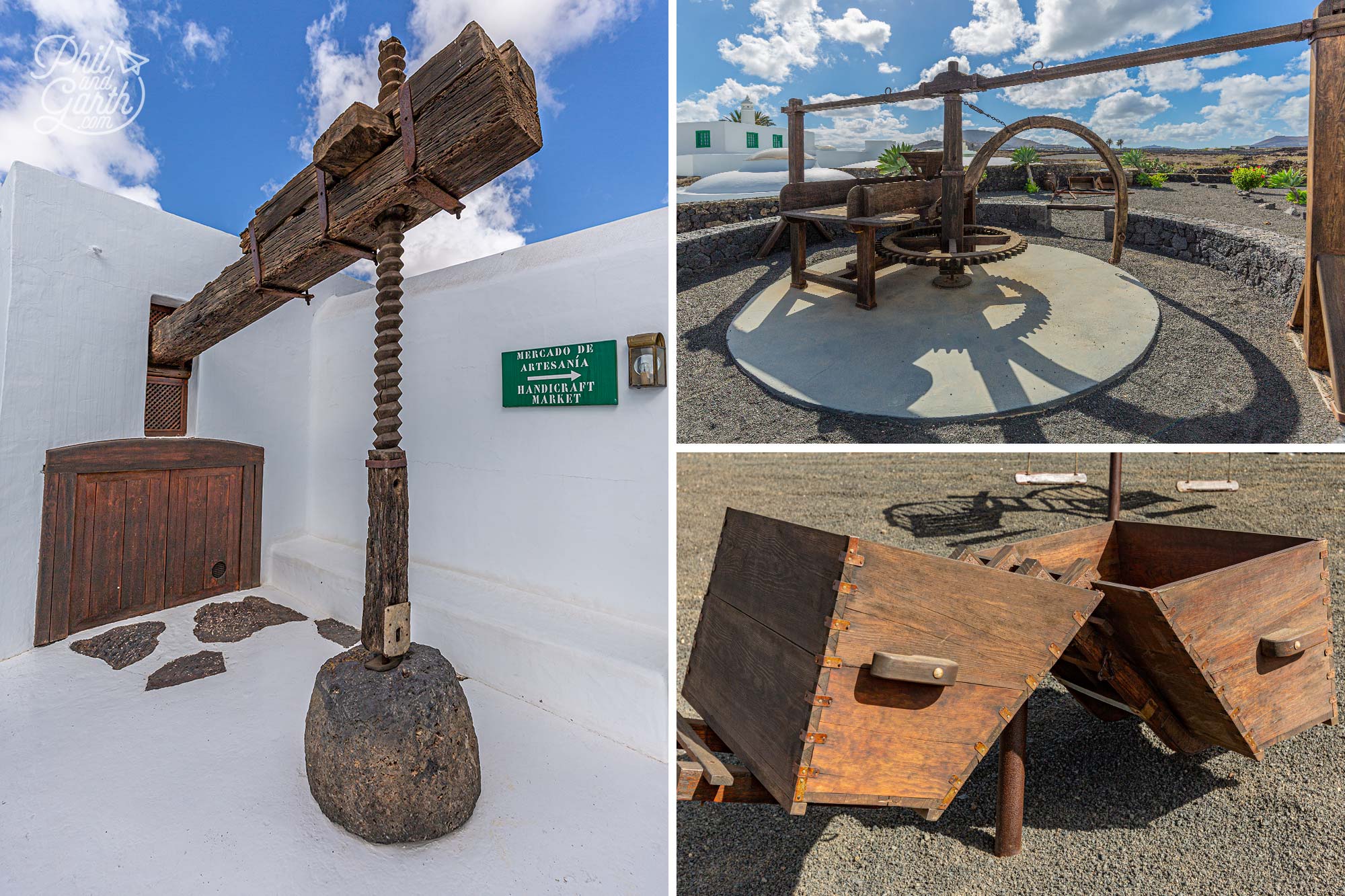
Old farming implements are exhibited like camel carrying boxes
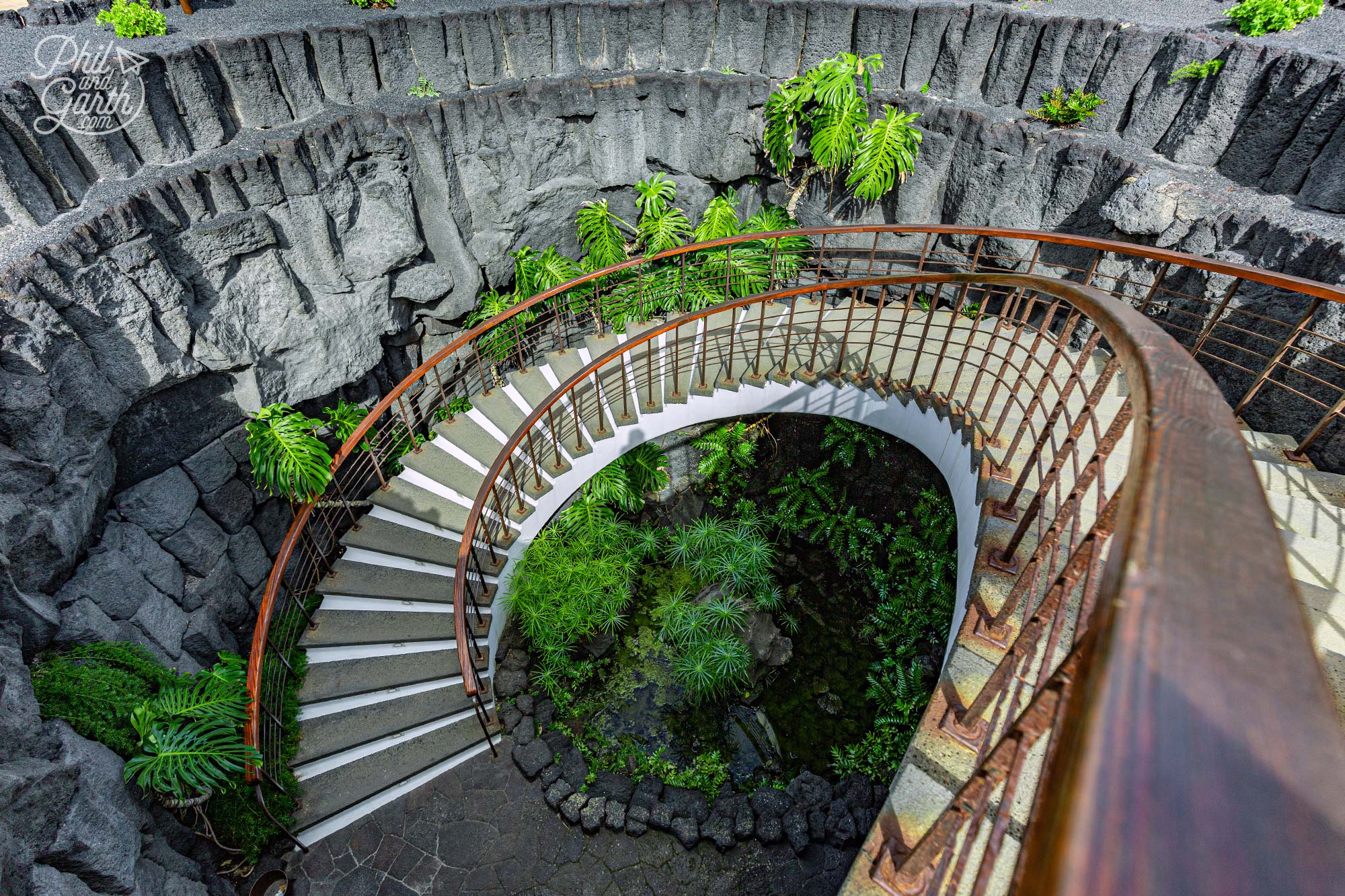
Love this spiral staircase to the event restaurant
One thing you can’t fail to miss here is the massive abstract sculpture, El Monumento del Campesino which has become a bit of a Lanzarote landmark. Built in 1969 and designed by César Manrique, it’s his personal tribute to the hardworking men and women of the island’s past farming communities. The sculpture is made from old fishing boat water tanks and symbolises 3 agricultural working animals – a camel, donkey and a dog.
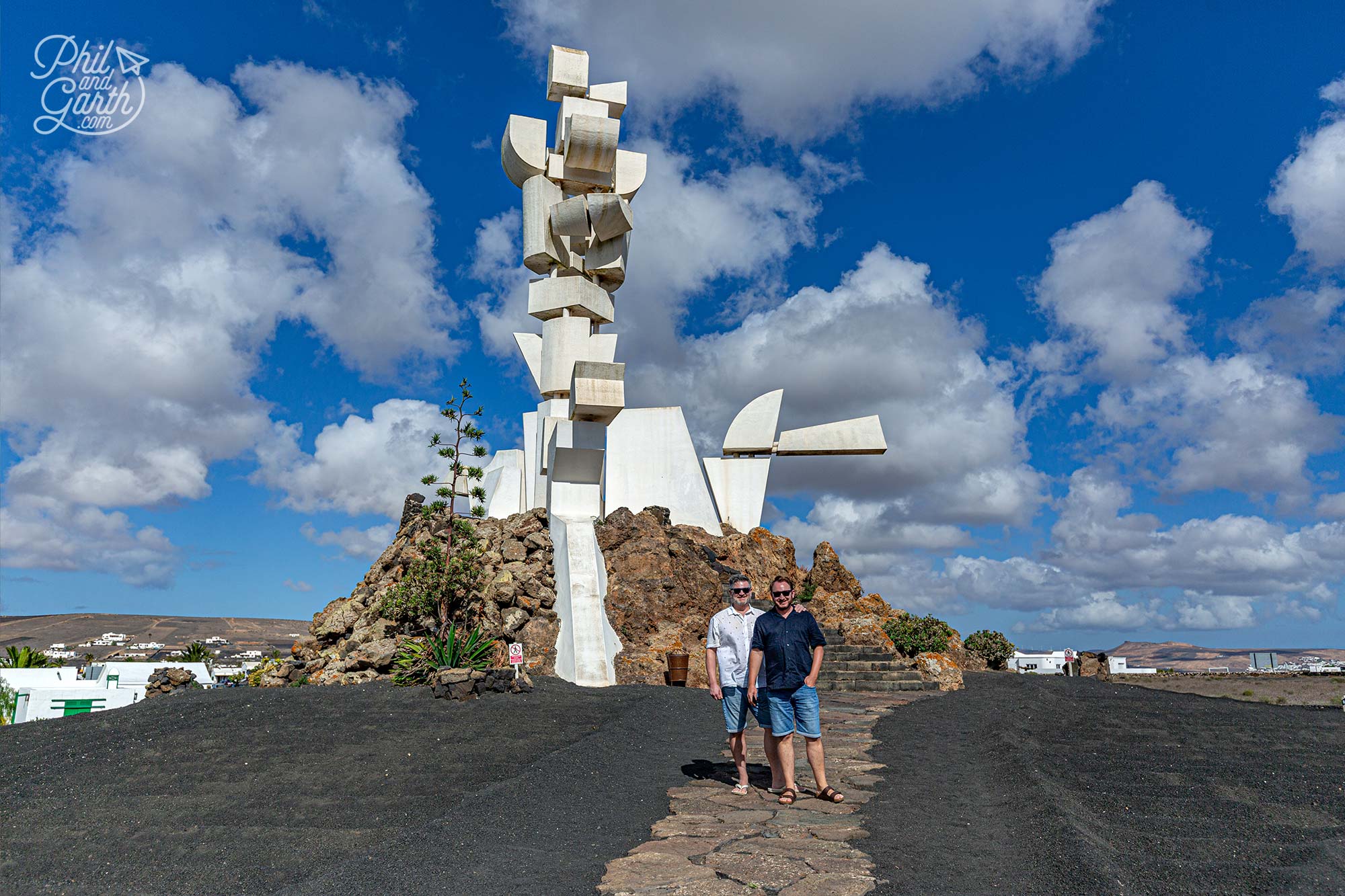
Monumento a la Fecundidad – Manrique’s avant garde sculpture
Casa Museo del Campesino is open everyday from 10am to 5.45pm. It’s free to enter and there’s loads of parking spaces, allow an hour here. The artisan shops are not open on Sundays.
6. César Manrique’s Volcano House (Fundación César Manrique)
Lanzarote’s most famous resident was artist, architect and sculptor César Manrique. You can visit two of his homes on the island, we chose his ‘volcano house’ or by its proper name Fundación César Manrique located in Taro, Tahiche. Manrique lived here for 20 years between 1968 to 1988 after returning to Lanzarote from New York City where he worked for 3 years. After his death in 1992 his home was turned into an art gallery and headquarters for his non-profit organisation, Fundación César Manrique. His other home, Palm Grove House in Haria is where he spent his last years.
Manrique’s volcano home is pretty incredible, blending art into nature, whilst respecting the natural environment. We really loved exploring his impressive home. Rooms on the first floor are art galleries and display his own private art collection including artworks by Miro and Picasso. A collection of photographs show Manrique’s somewhat hedonistic lifestyle of the late 60s and 1970s. The ground floor is where things get really interesting. Manrique sculpted 5 beautiful living spaces from 5 natural volcanic ‘bubbles’ essentially caves. Tunnels are excavated in the lava rock to create corridors between the bubble spaces. Phil thought it was like the something out of The Flintstones or Tracy Island from Thunderbirds!
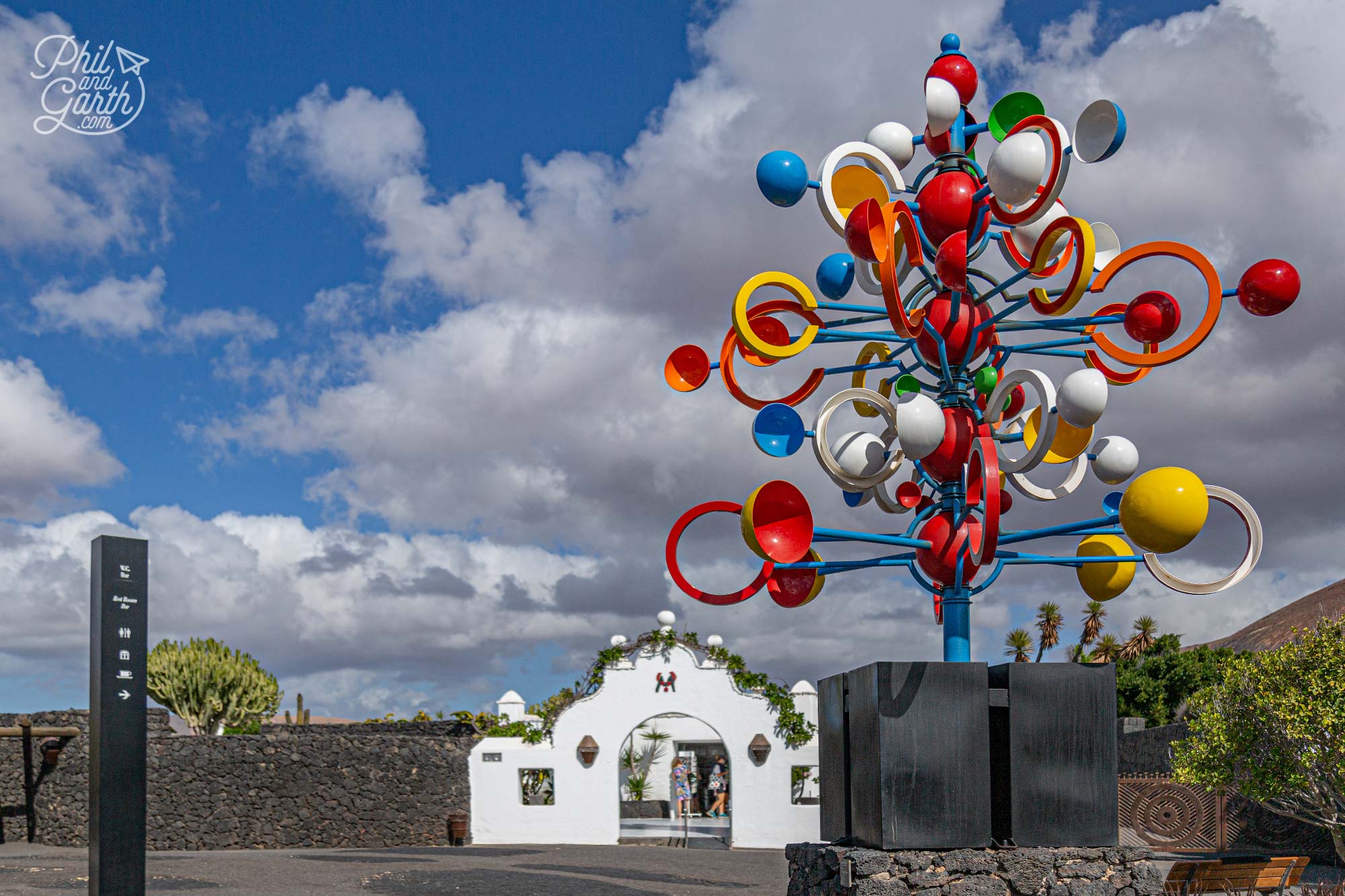
One of César Manrique’s fabulous wind sculptures welcomes you to his volcano home
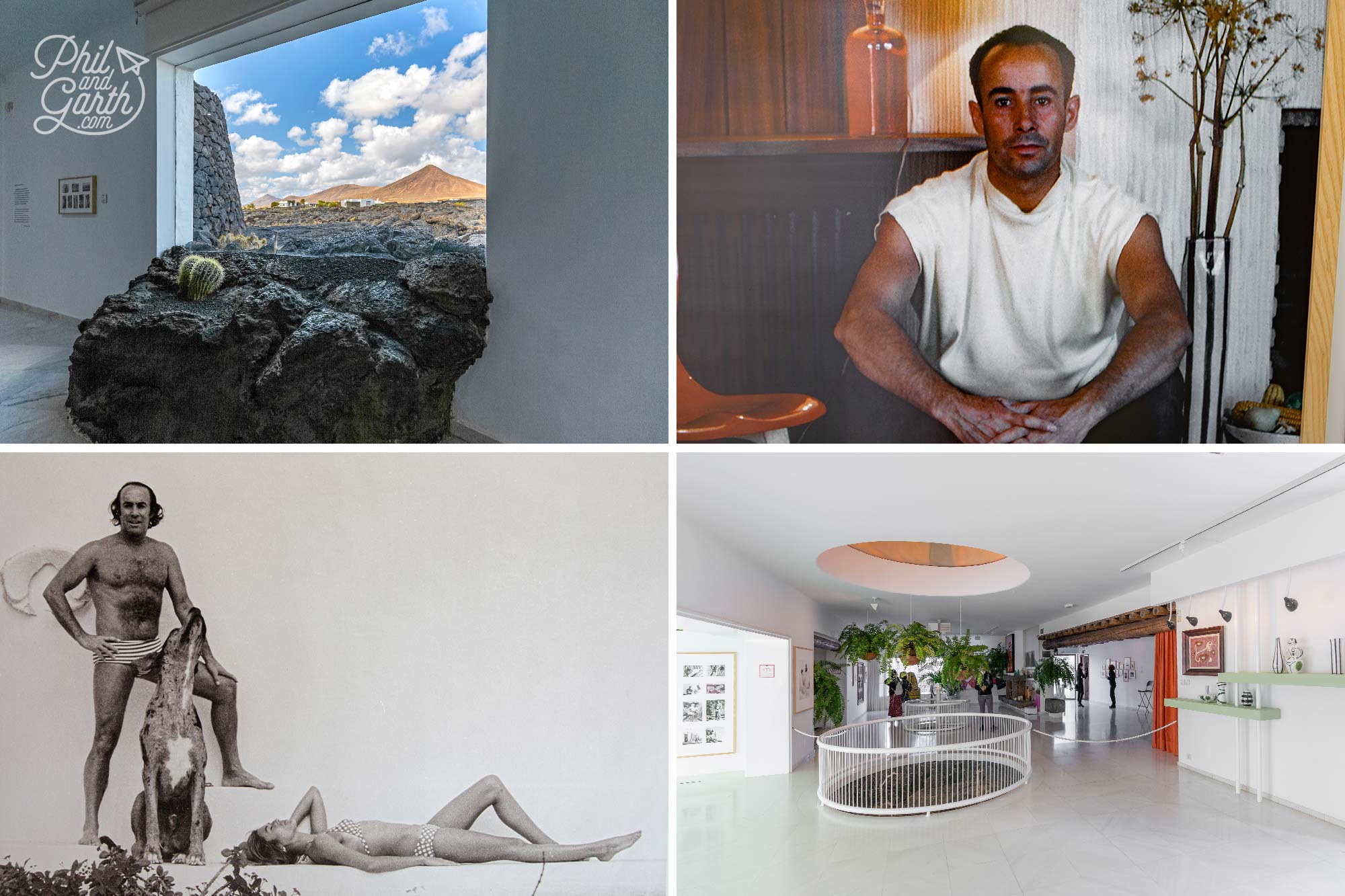
Fundación César Manrique museum galleries
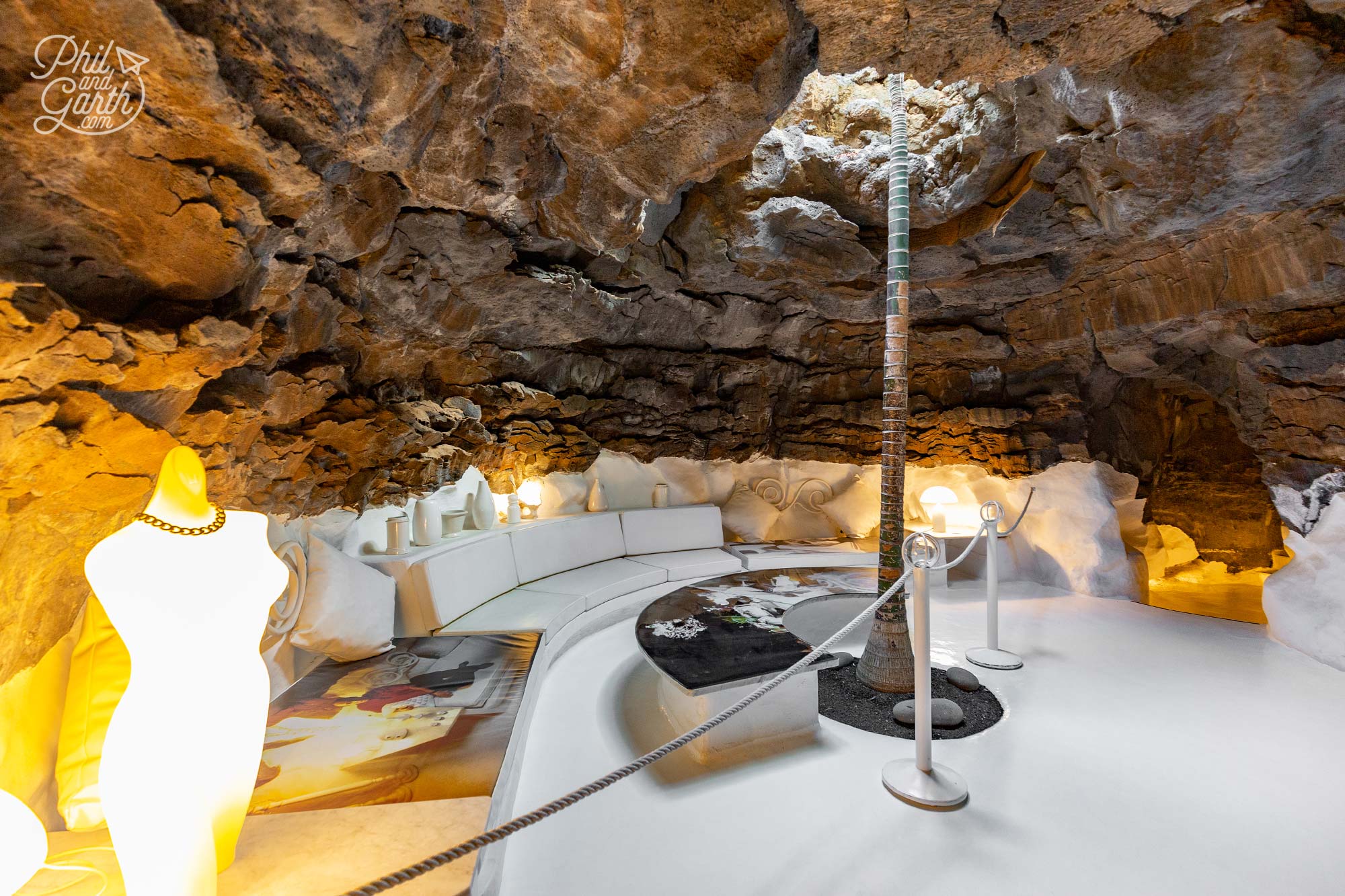
Inside César Manrique’s ‘volcano’ home – This is the main parlour entertaining space
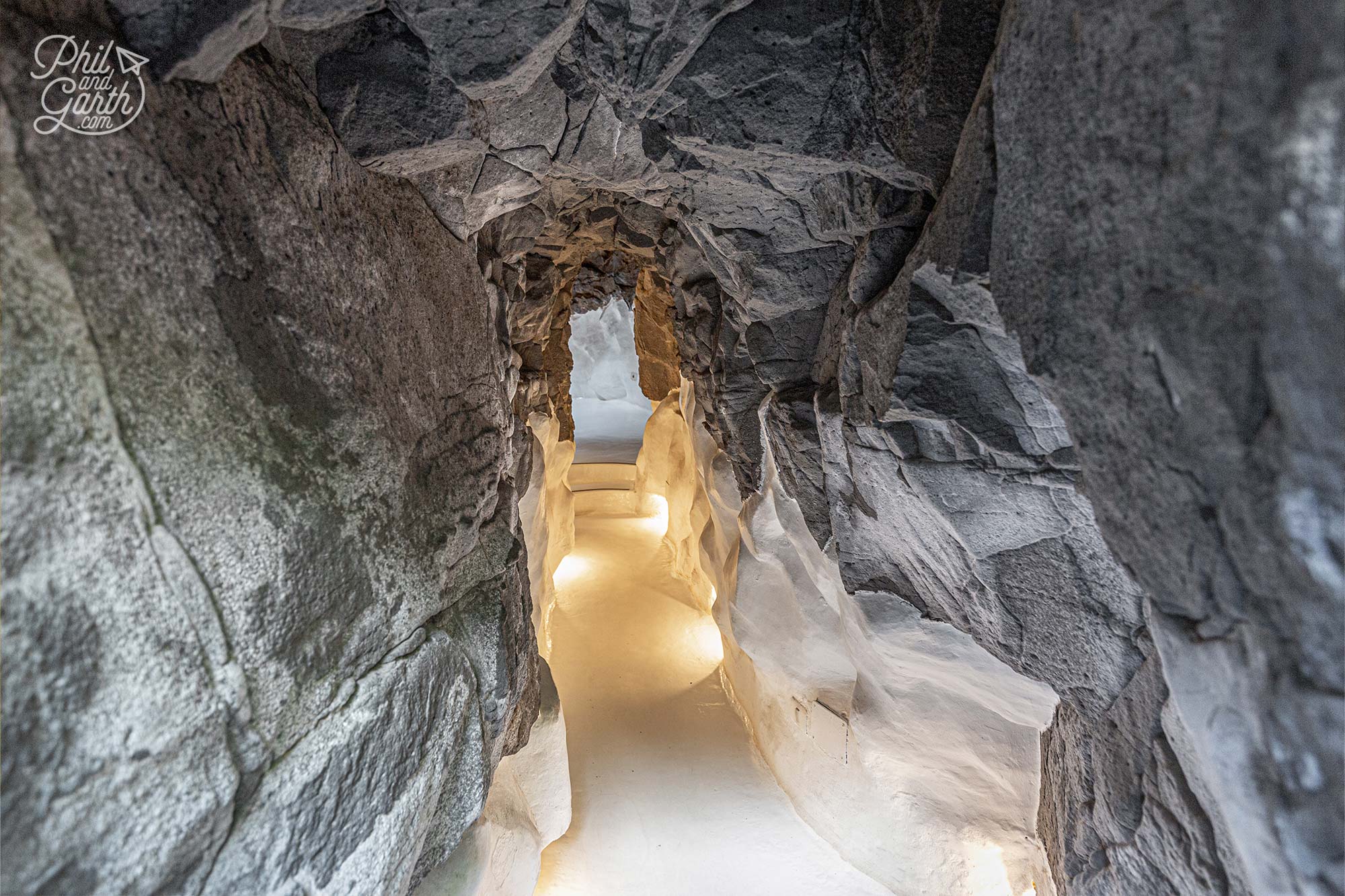
One of the corridors between the bubble spaces
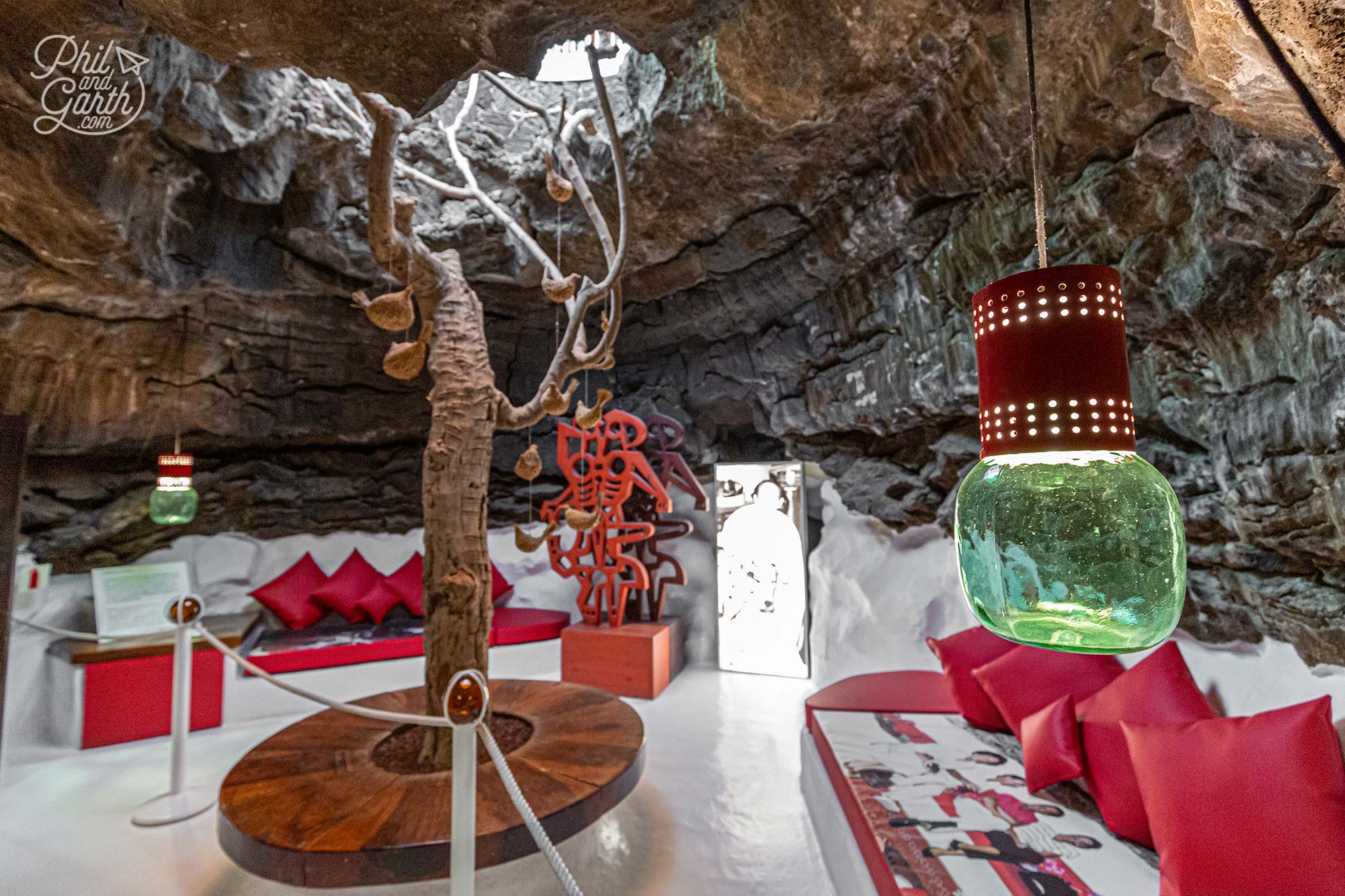
Another incredible living space within a volcanic bubble
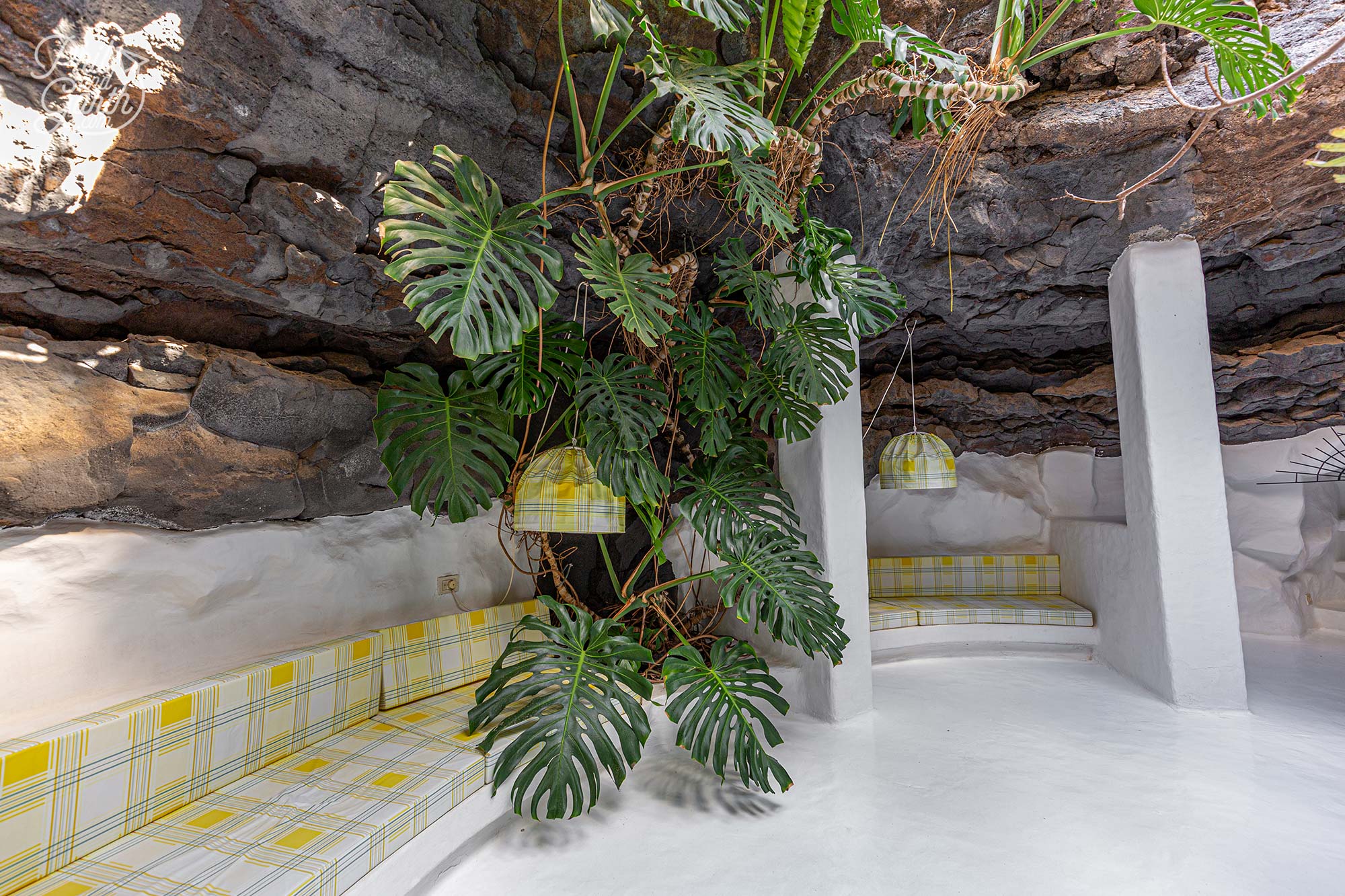
Another bubble and another entertaining space
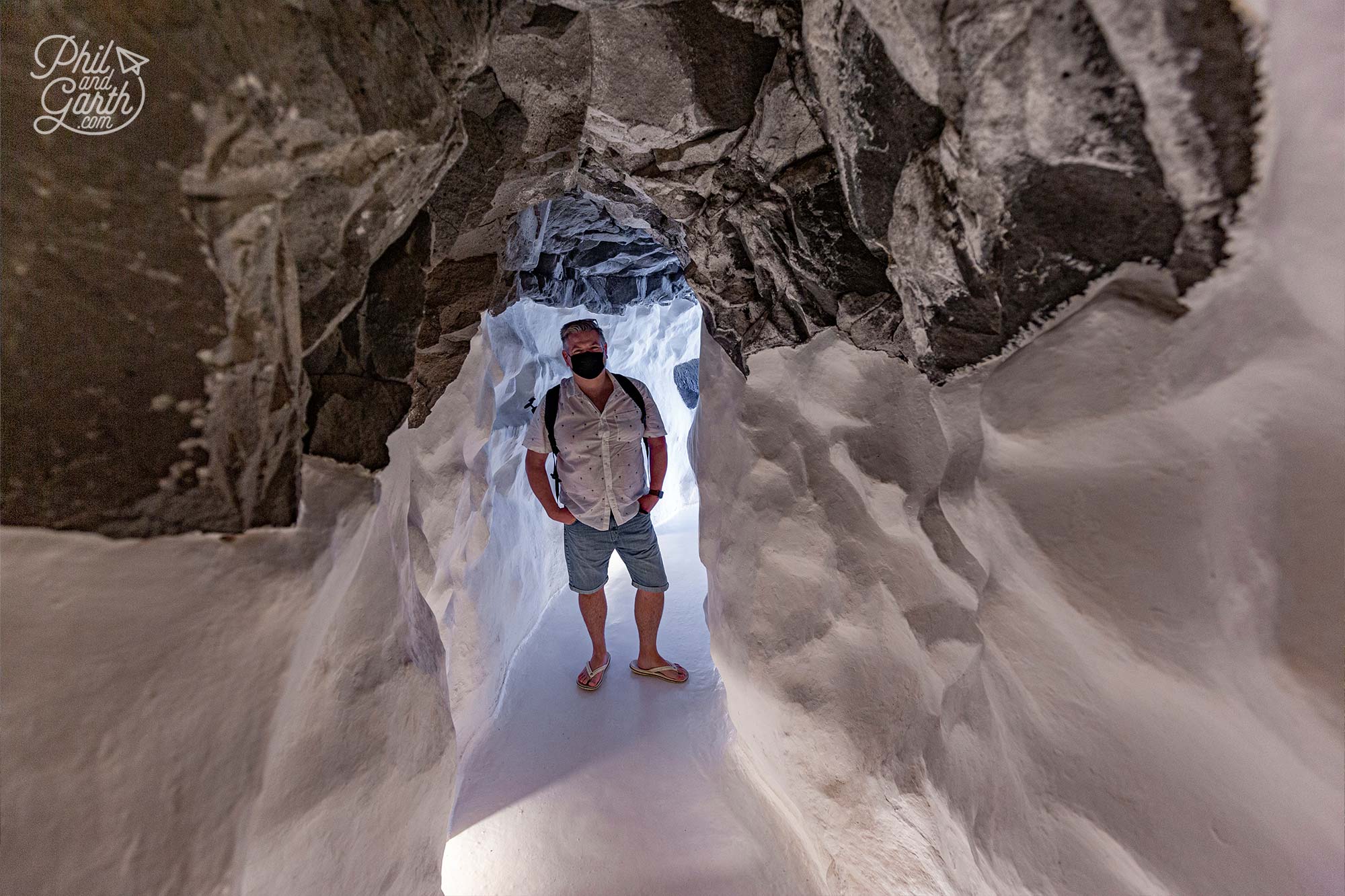
Another tunnel leads you to the outdoor space
The outside space is equally stunning, the sunken garden with its gorgeous swimming pool is a small oasis of calm and tranquillity. We loved the 70s orange furniture and the lava bridge over the water, it’s the ultimate in chic eco-design.
The last garden is more formal with a huge mural on a long white wall. Made from broken tile pieces it depicts several Spanish bulls.
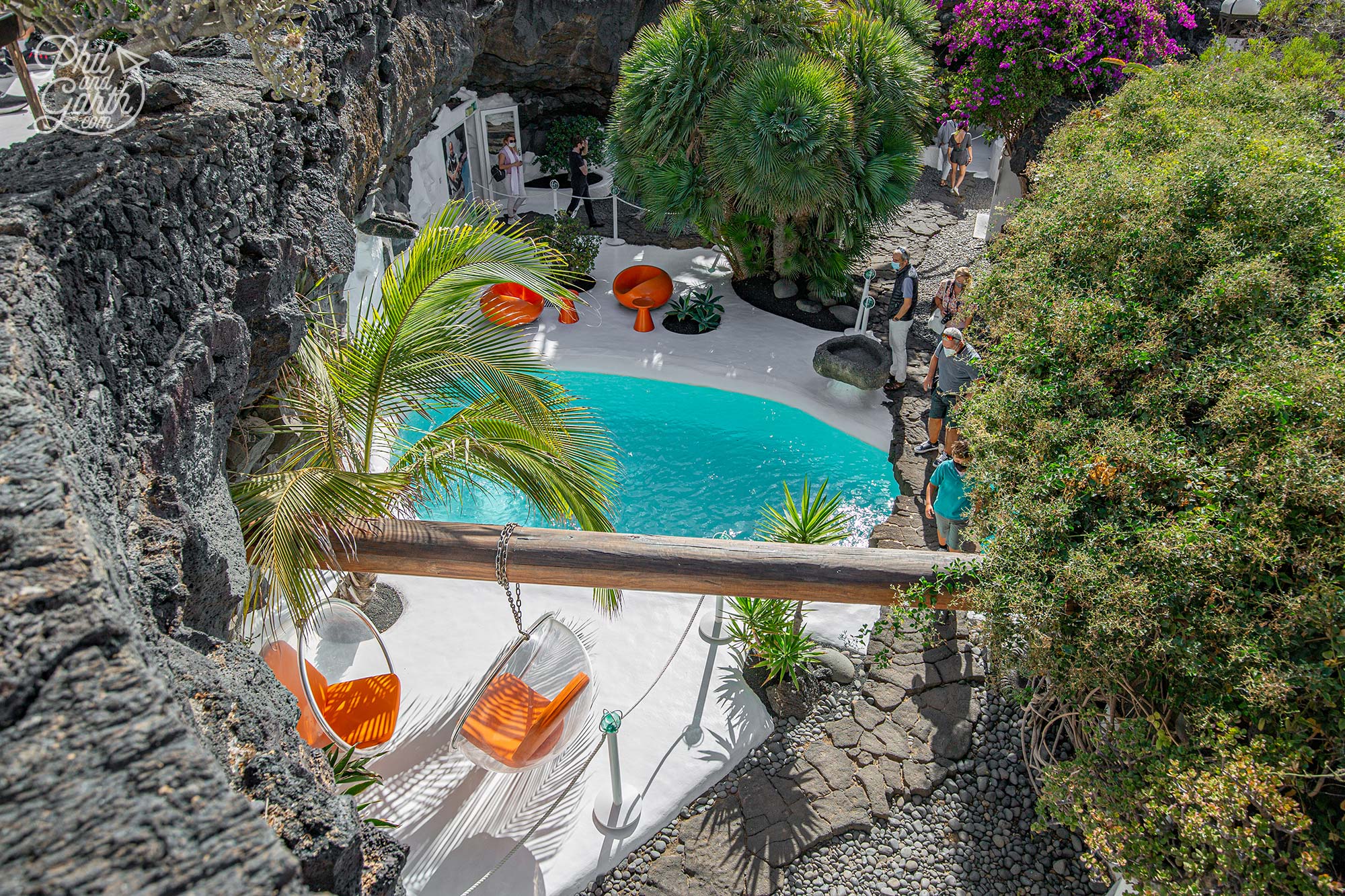
The sunken garden is an oasis of calm and tranquility
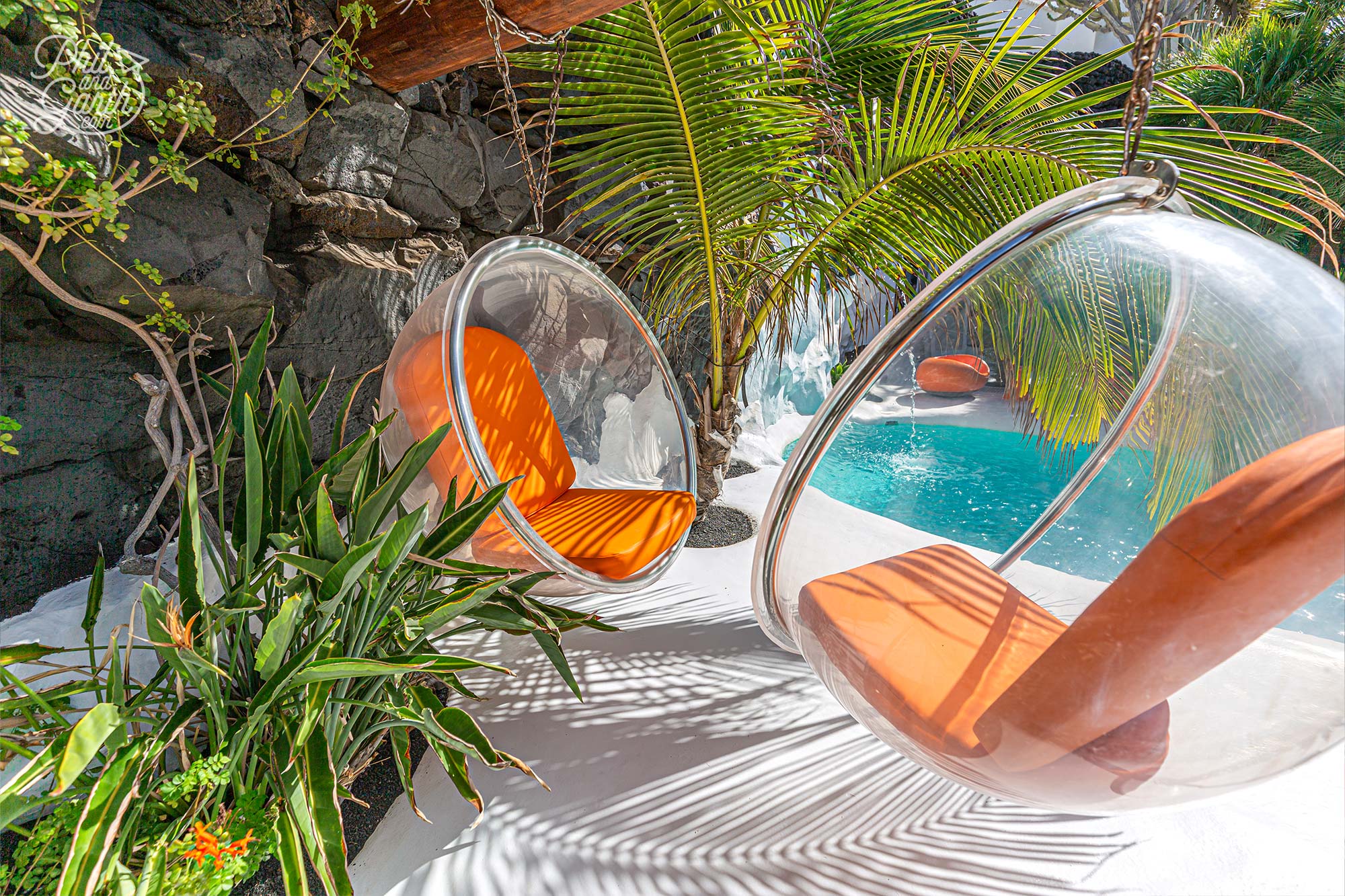
What a great party pad it must have been!
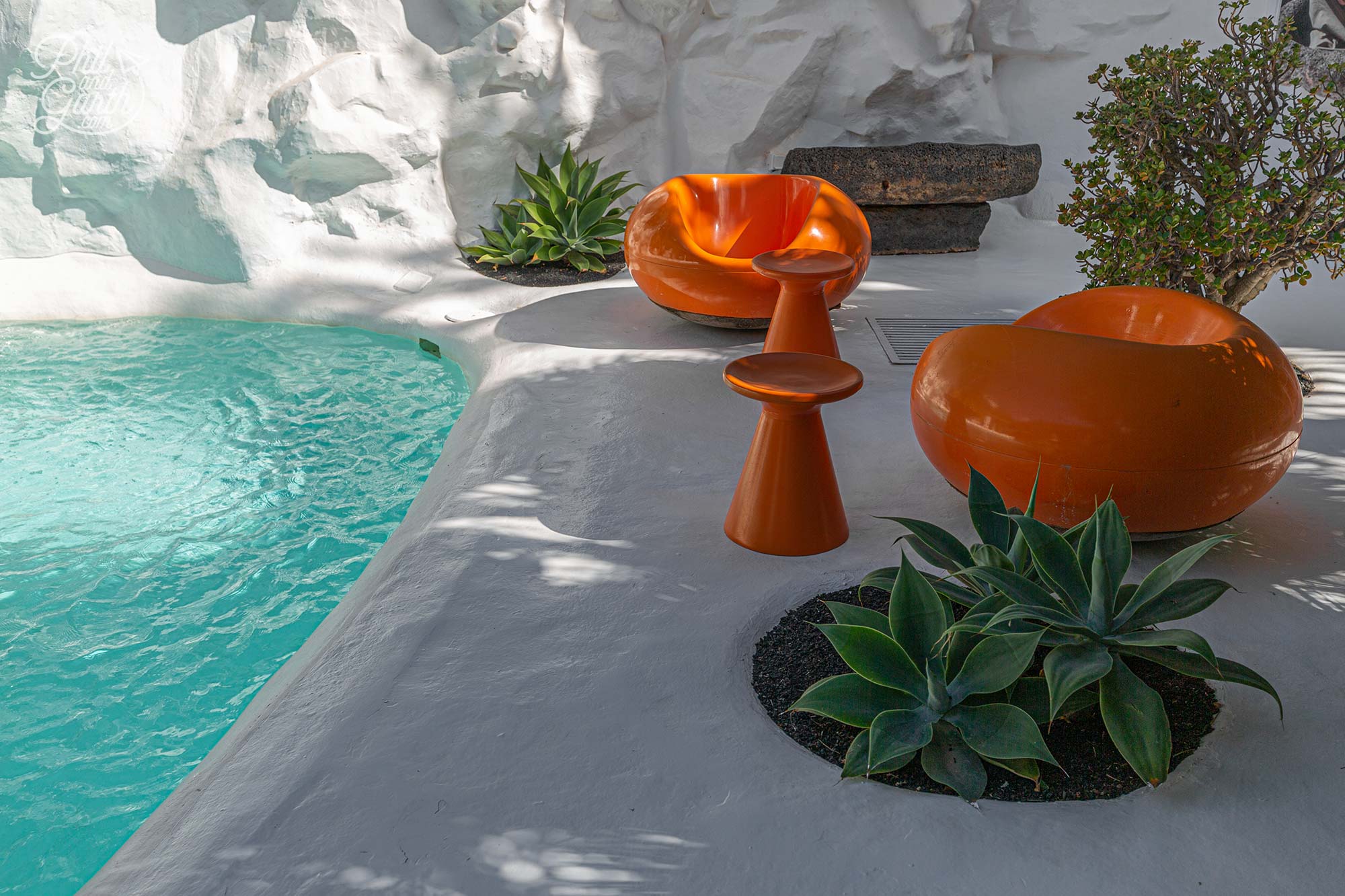
Loving all the details of the 70s chic design
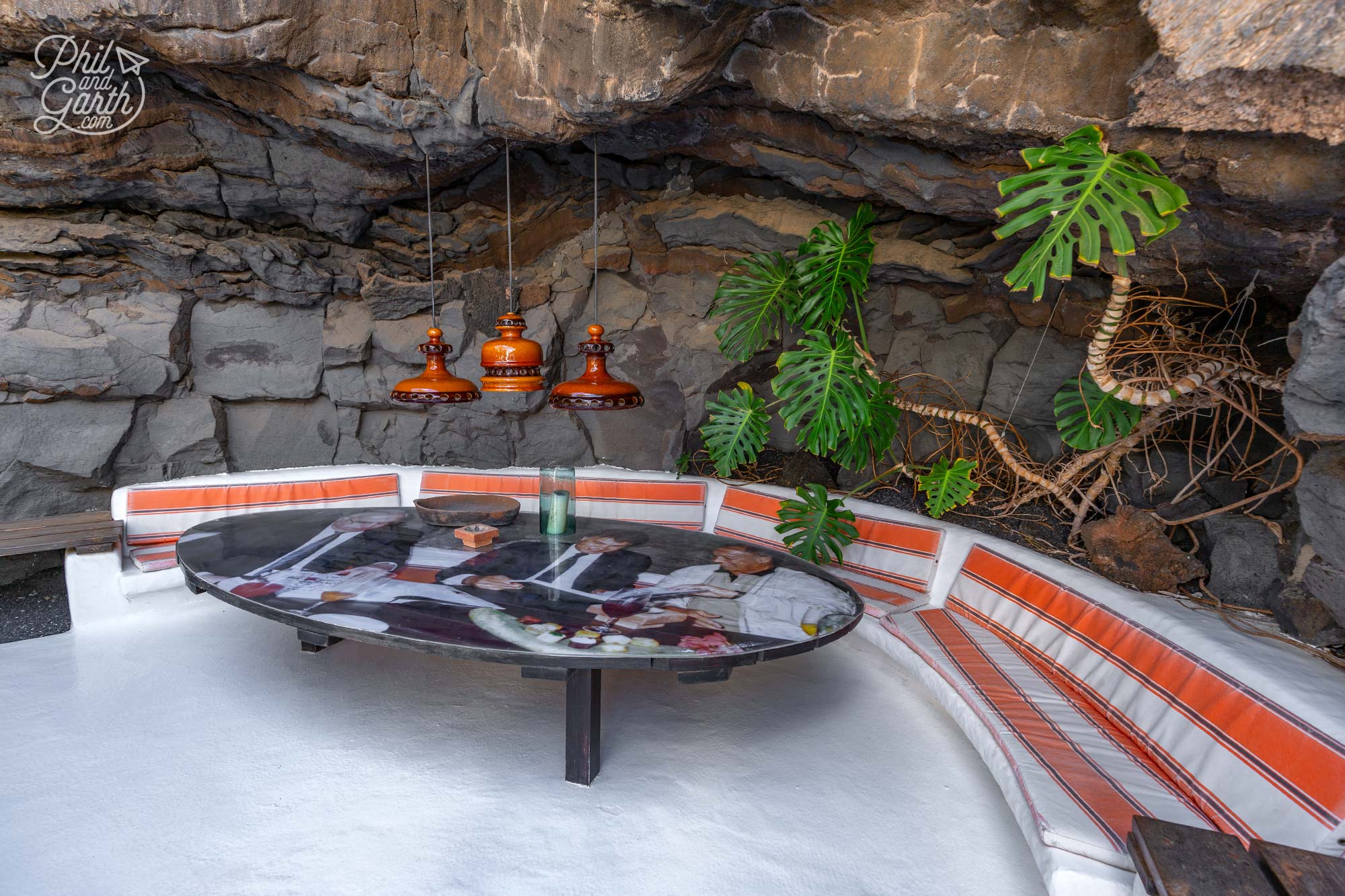
Another entertaining space in the sunken garden
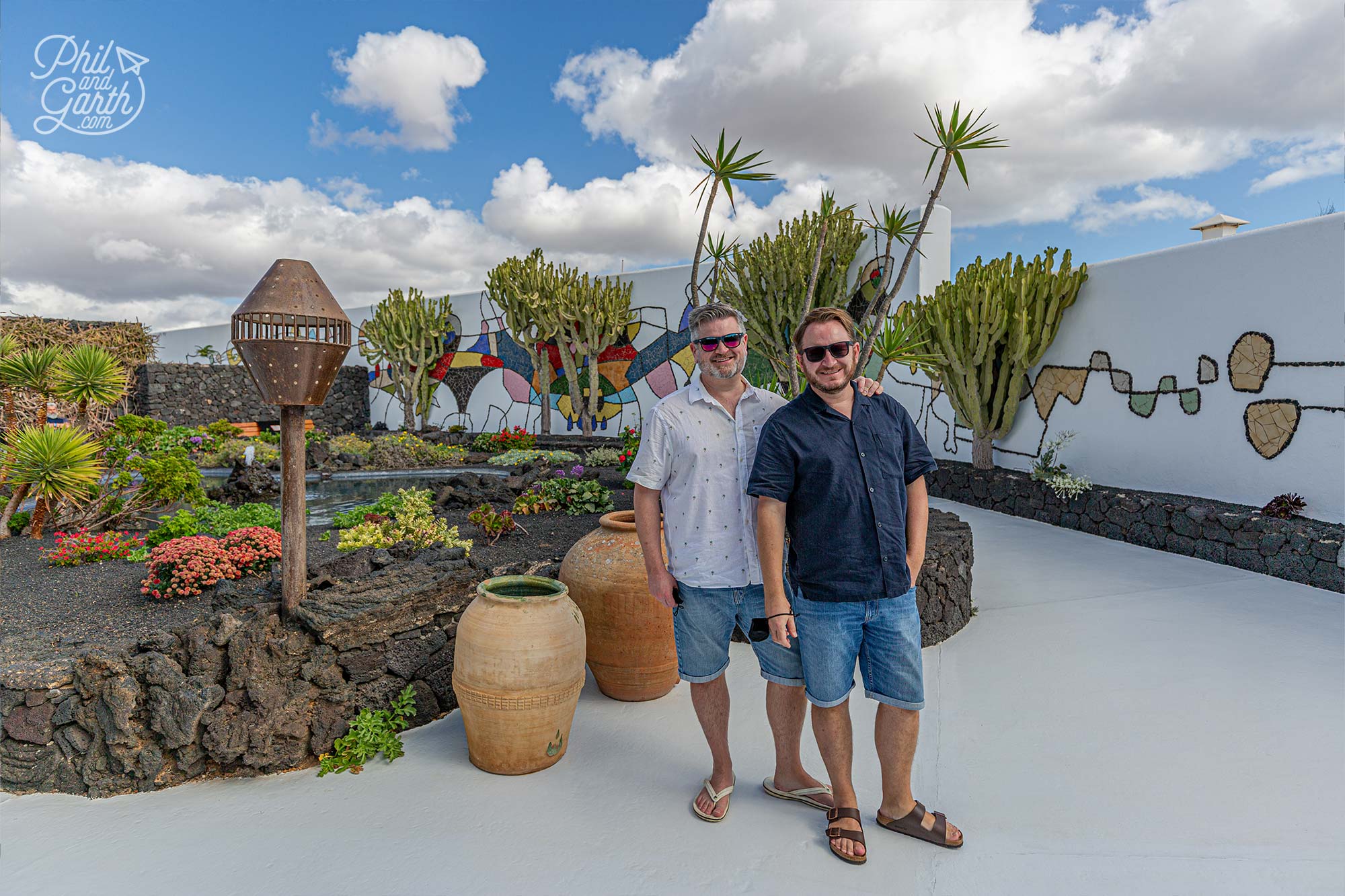
Manrique’s formal garden with colourful plants to compliment the colourful mural
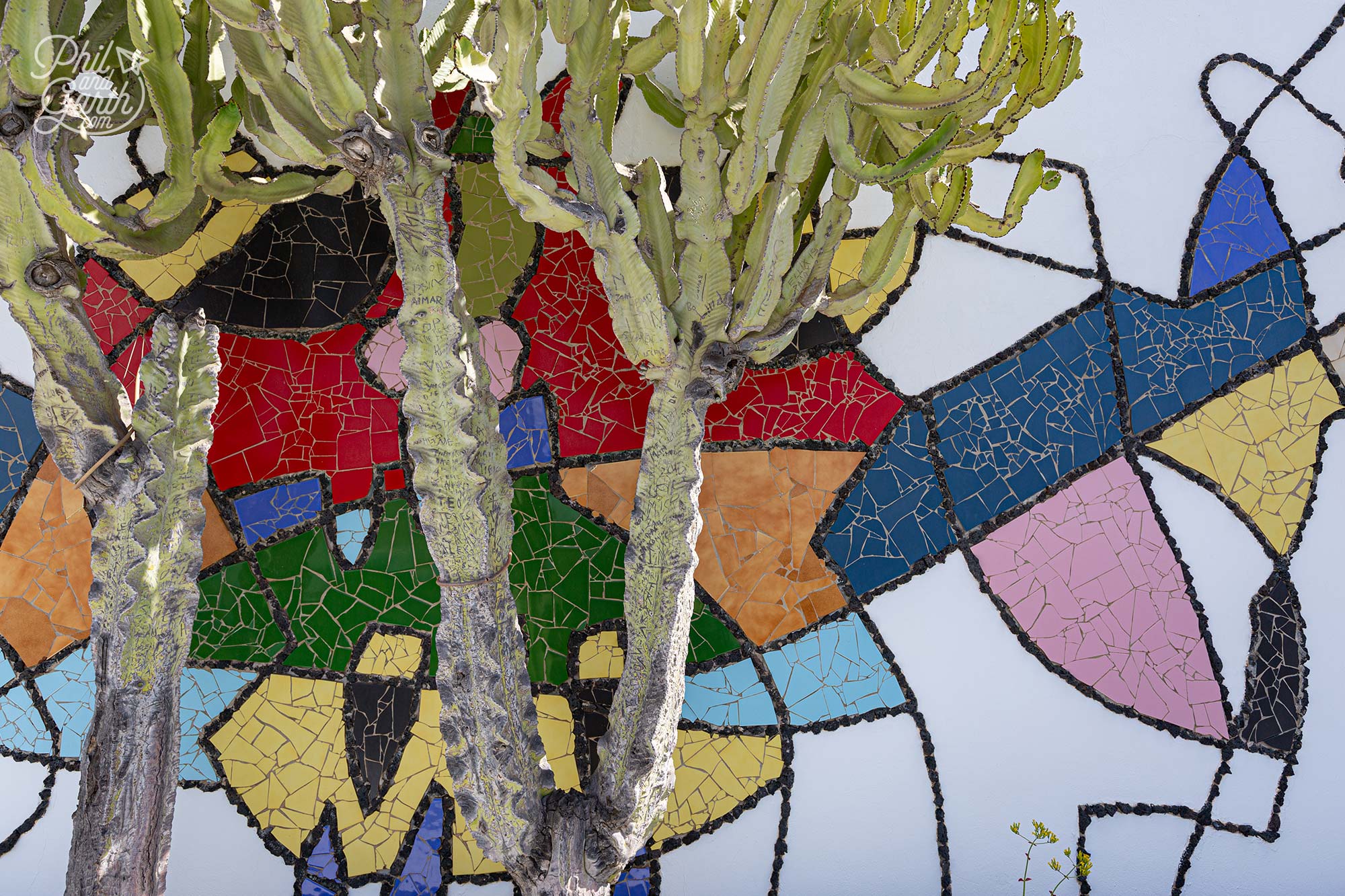
A close up of the mural in the Cactus Garden
Fundación César Manrique is open everyday from 10.00am – 3.00pm. An adult ticket costs €10. The ticket office closes at 2.15pm.
7. Jardín de Cactus
If you’ve got green fingers like Garth then you’ll love the Jardín de Cactus. It’s another creation by César Manrique and was his last project on Lanzarote before he died in 1992. Built in a volcanic crater of a disused gravel quarry, the garden features over 450 species of cactus and 4,500 plants from 13 different families of cactus all over the world. Garth thought the green cactus looked really striking against the black volcanic soil.
The windmill here is 240 years old was used to make Canarian cornmeal. There are some lovely views of the surrounding countryside from this vantage point. There’s also a cafe to take in the view of the cactus garden.
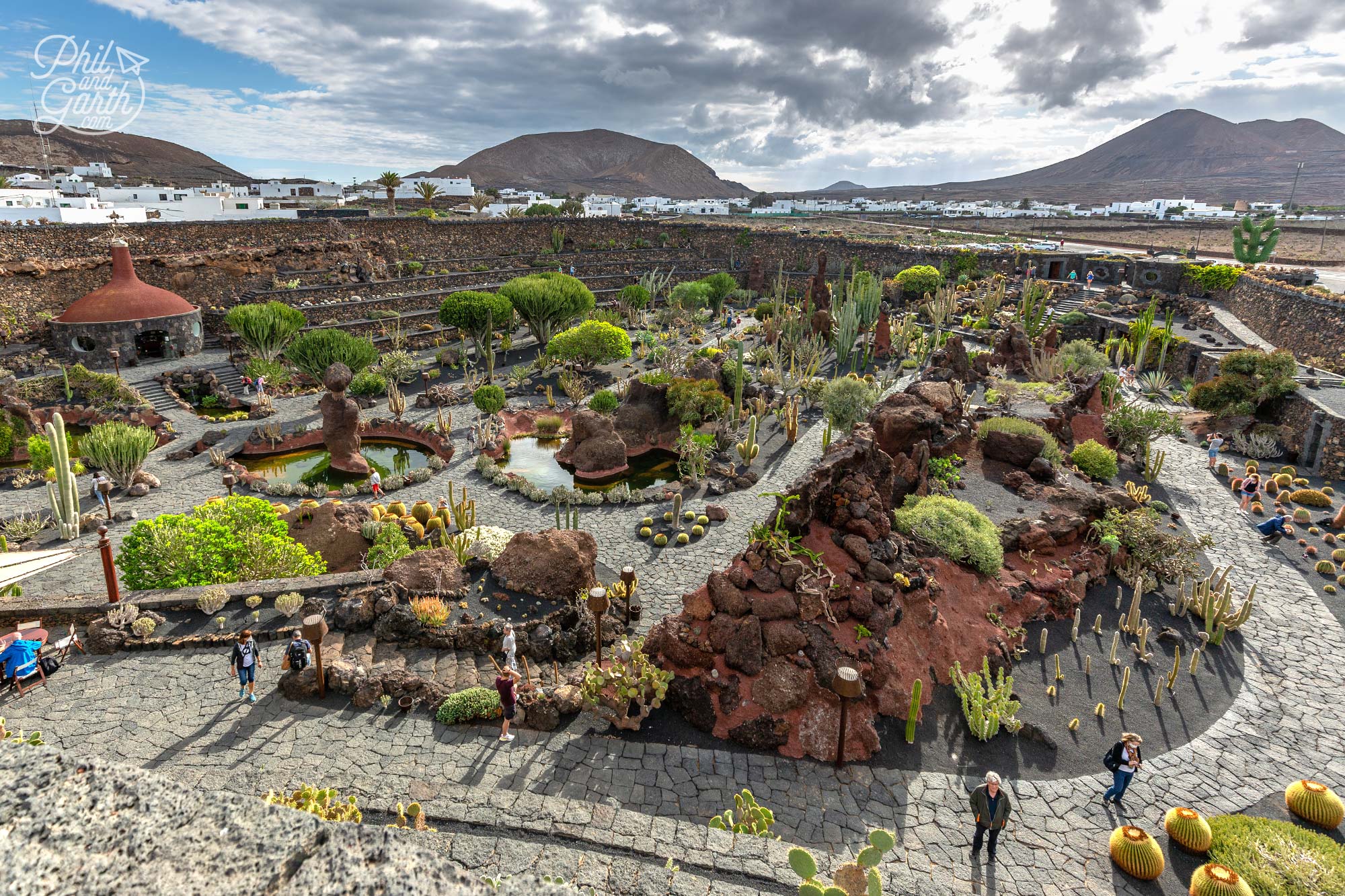
Gardeners and nature lovers will love Jardin de Cactus
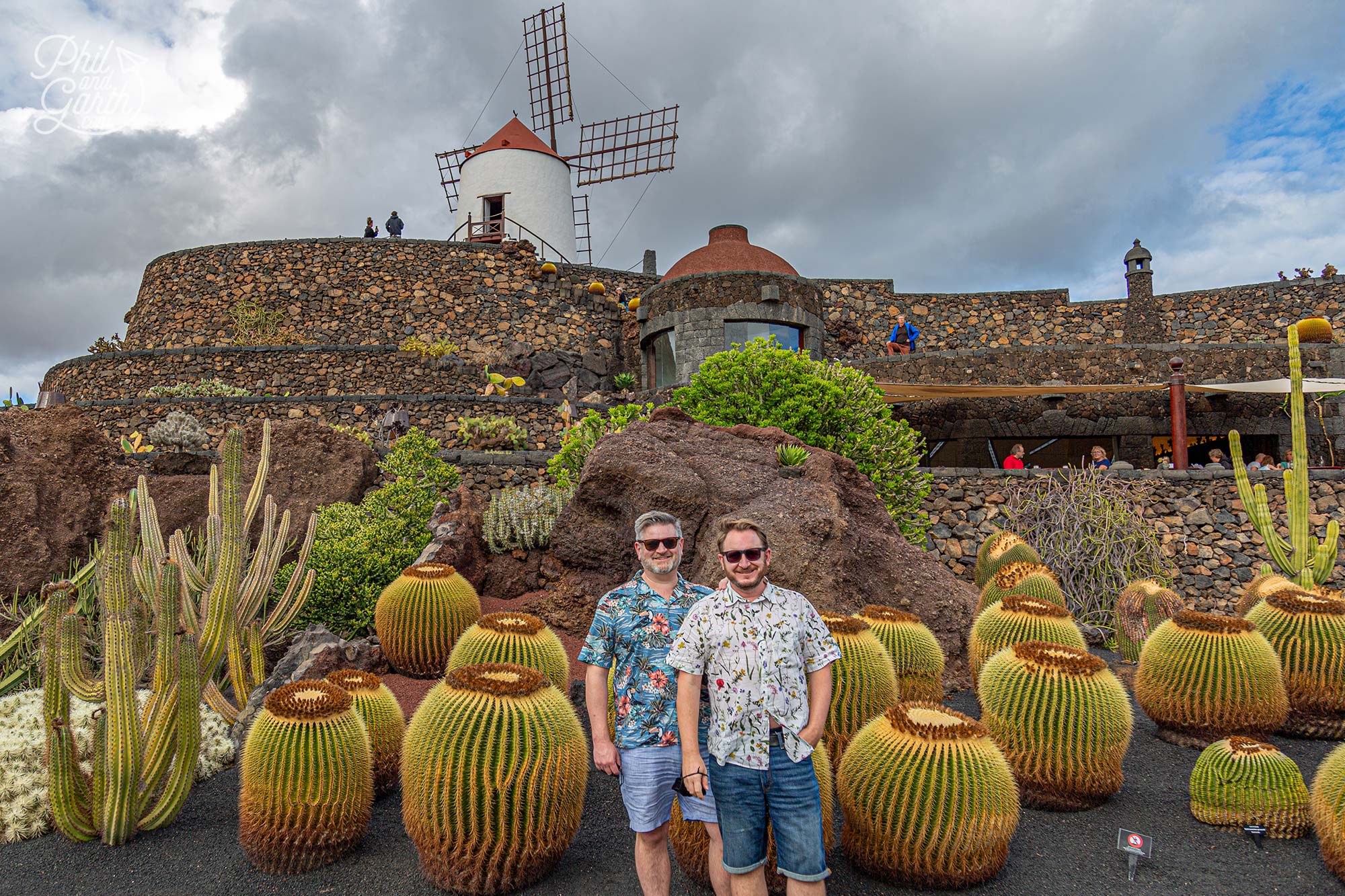
You’ll see 4,500 examples of 450 species of cactus
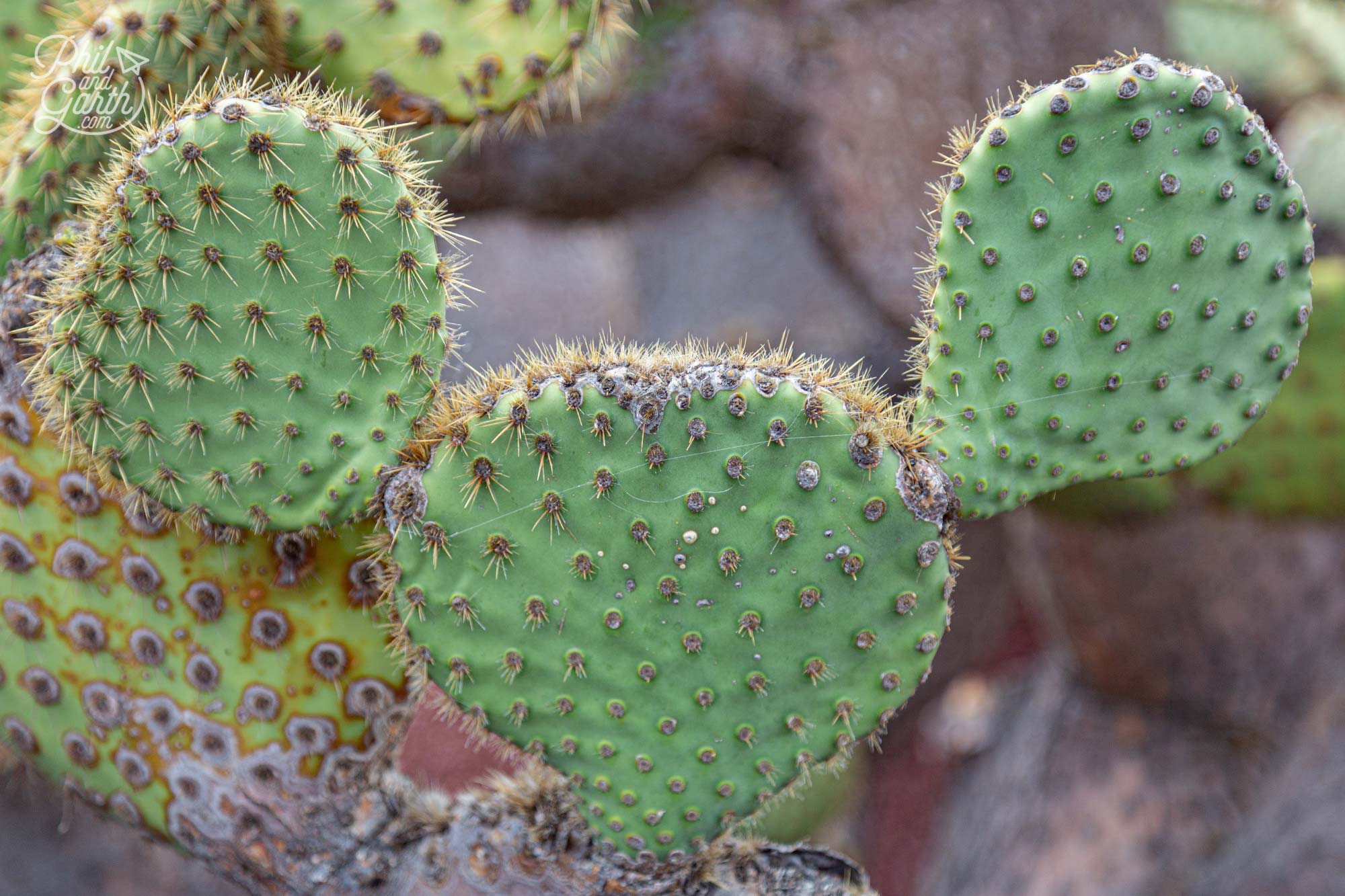
We found a Mickey Mouse cactus
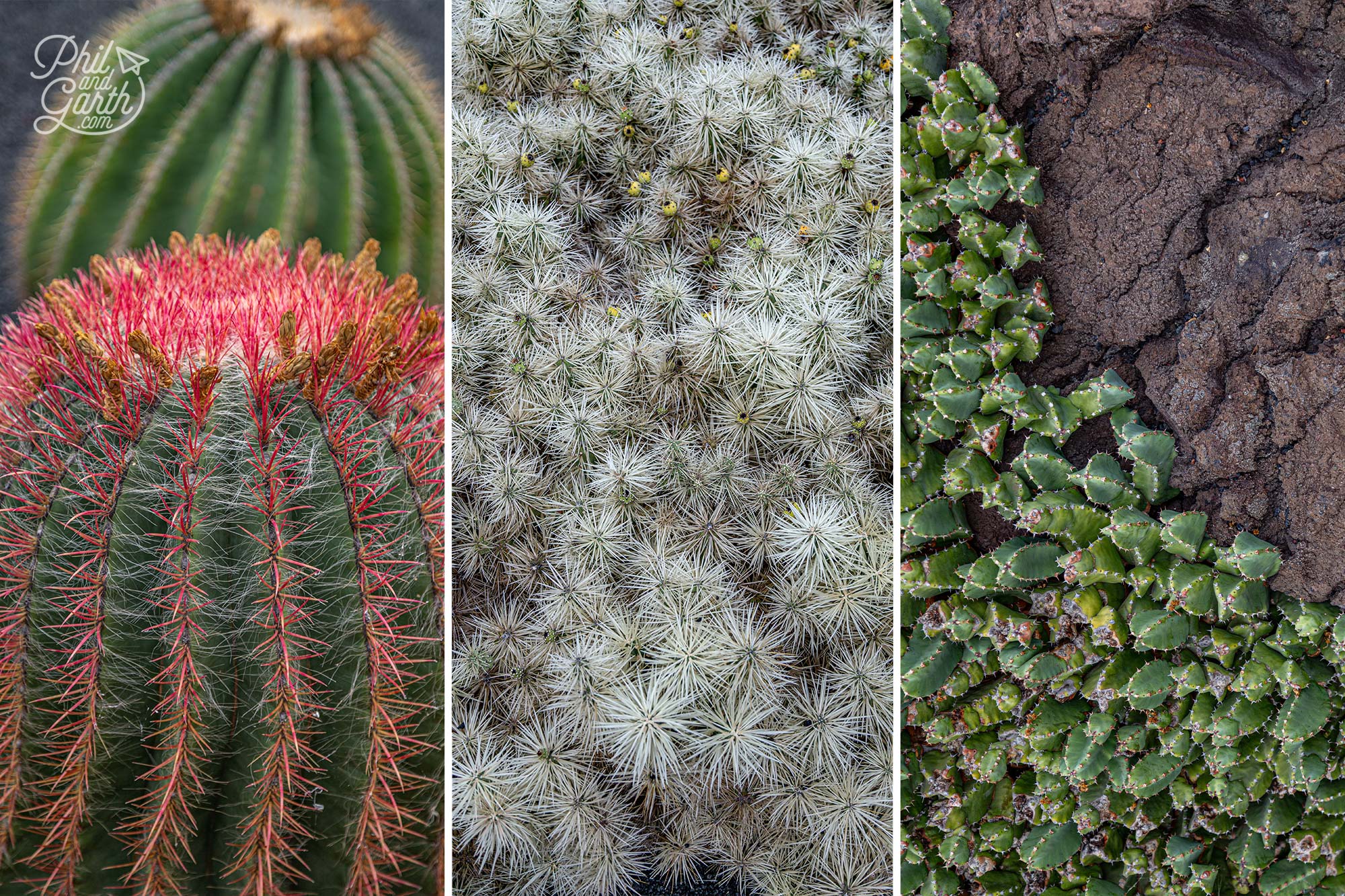
The garden was designed by César Manrique built in an old quarry
Jardín de Cactus is open everyday from 10.00am – 5.00pm. An adult ticket costs €6.5. For the least crowds at Jardín de Cactus visit first thing in the morning or late afternoon.
8. Volcanic vineyards of Lanzarote
So what we didn’t know is that Lanzarote is known for producing a dry white wine called Malvasia. To find out more we headed inland to La Geria which is Lanzarote’s wine producing region because of the fertile volcanic soil found here.
The landscape is covered with patterns of ‘zocos’ – semicircular lava rock walls that protect the vines drying out from the constant winds. They also help protect the dew on the vine each morning needed to feed and keep them alive. They are a striking sight, with the green vines set against the black soil. We thought it was amazing to think they can actually grow grapes in such an arid environment. Most of the zocos are planted with Malvasia grapes grown for their juicy sweetness.
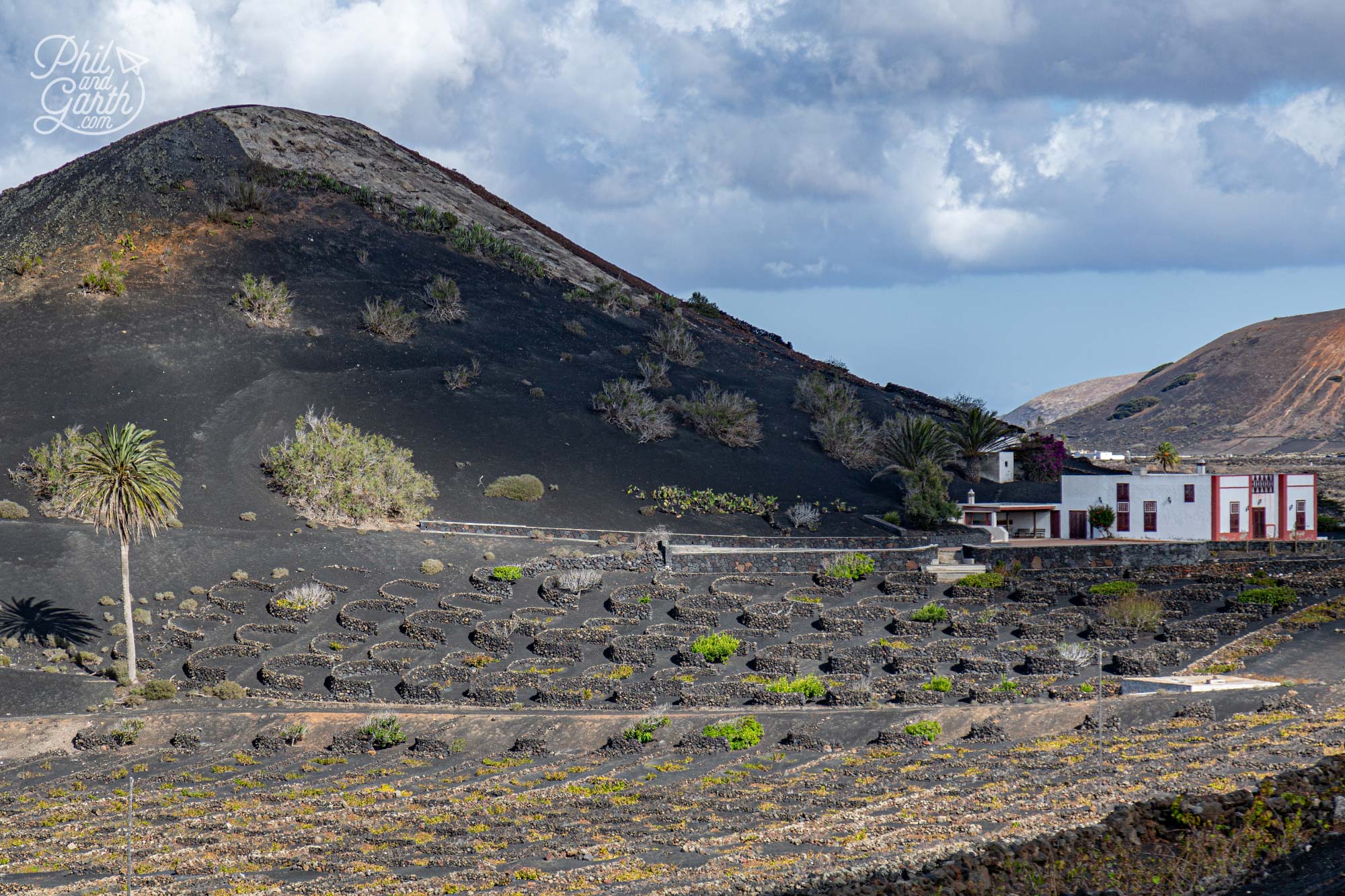
La Geria is Lanzarote’s Malvasia wine producing region
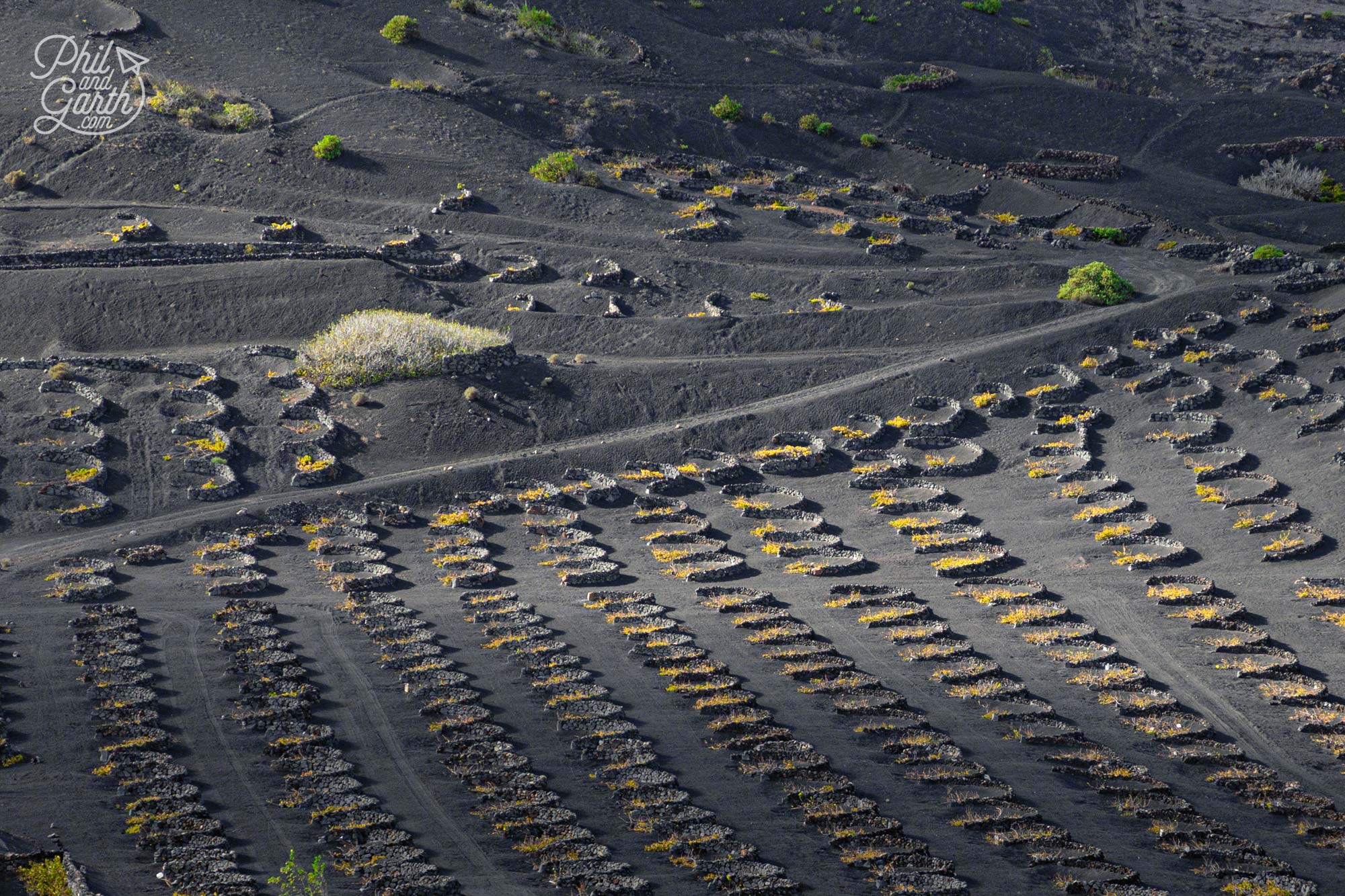
Patterns of ‘zocos’ cover the landsacape – lava rock walls that protect the vines
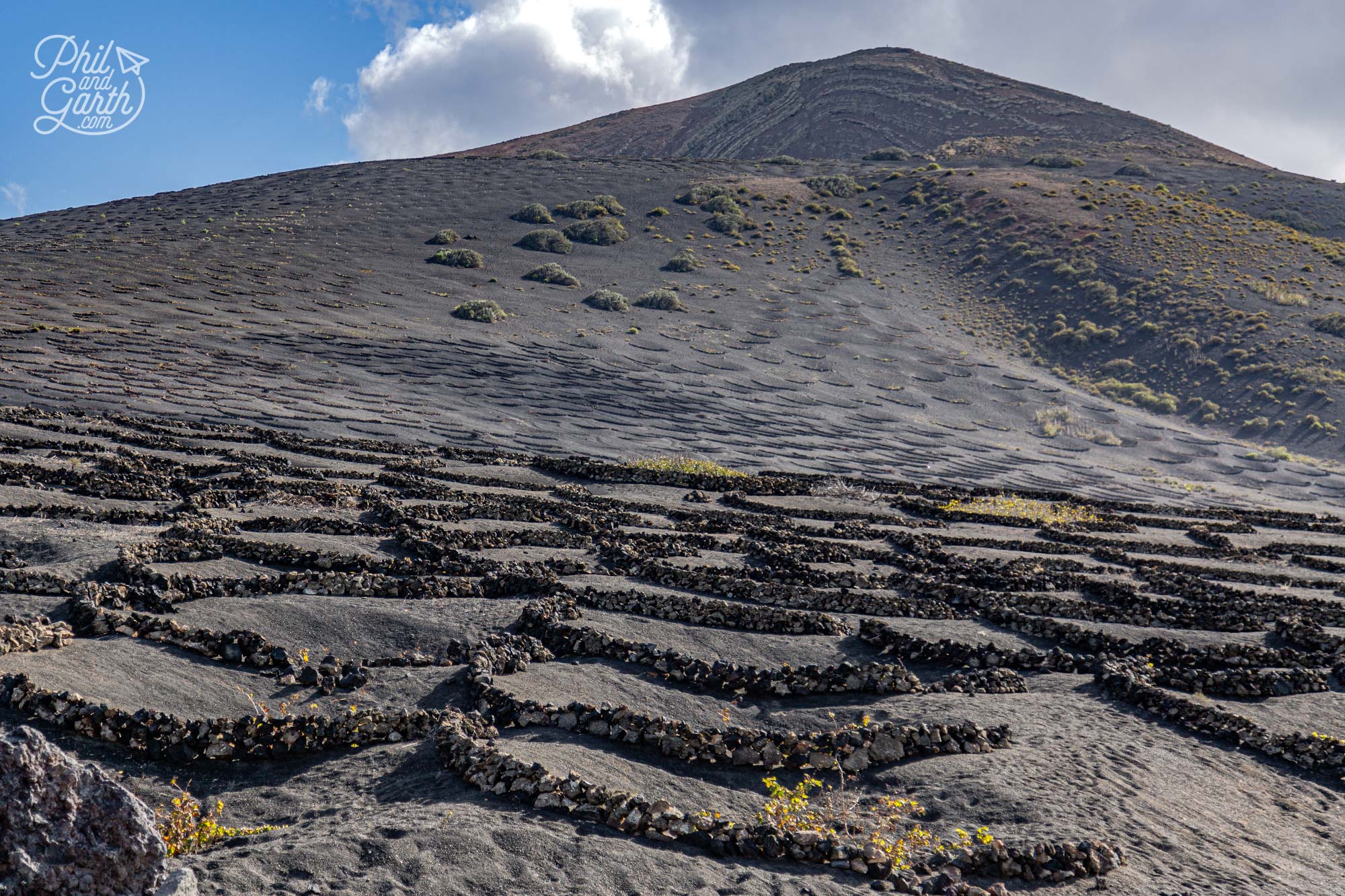
Grape vines grow in the dark volcanic soil
So of course we had to try a tipple of Malvasia. We headed to the oldest winery, Bodegas El Grifo. It dates back to 1775 and is the oldest winery of the Canary Islands and one of the oldest in Spain. We checked out their small museum before moving on to the wine tasting at their bar where we tried 3 different white Malvasia’s. Phil liked the driest Malvasia the most. After the tasting we went on a walk around the vineyard where you see fields of vines growing, some of them look incredibly old.
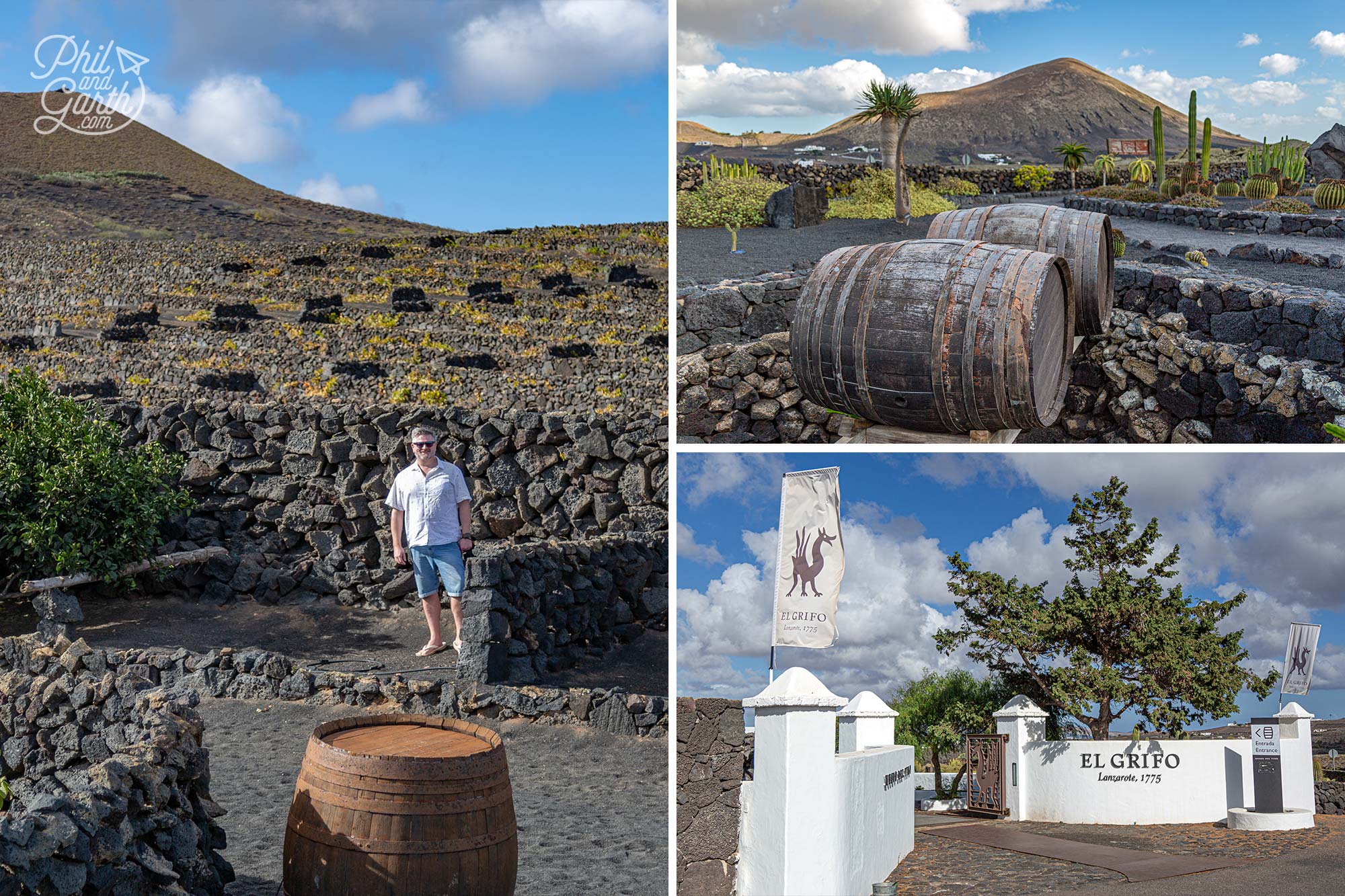
Bodegas El Grifo is the the oldest winery on Lanzarote
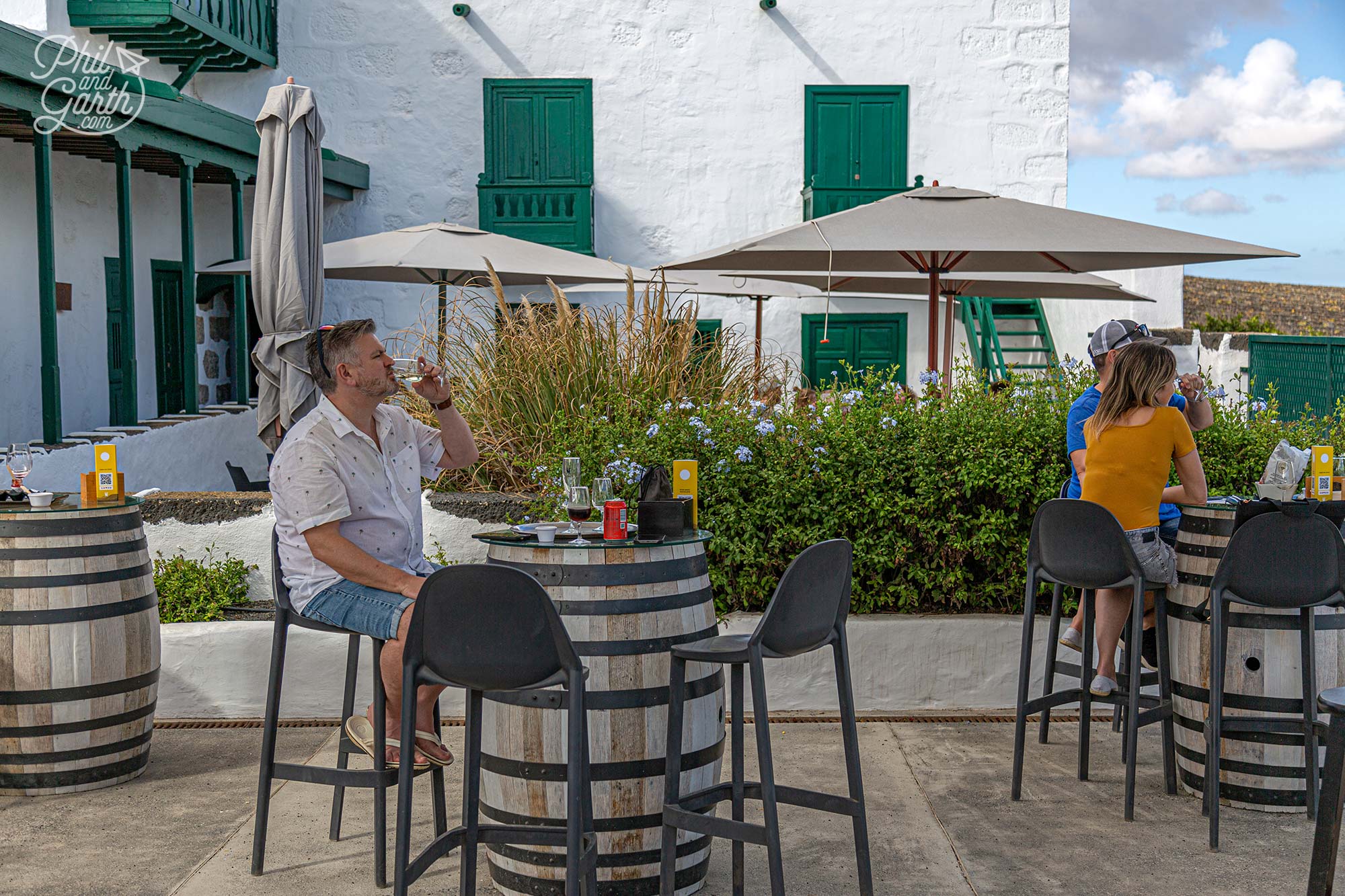
Tasting different Malvasia wines at Bodegas El Grifo
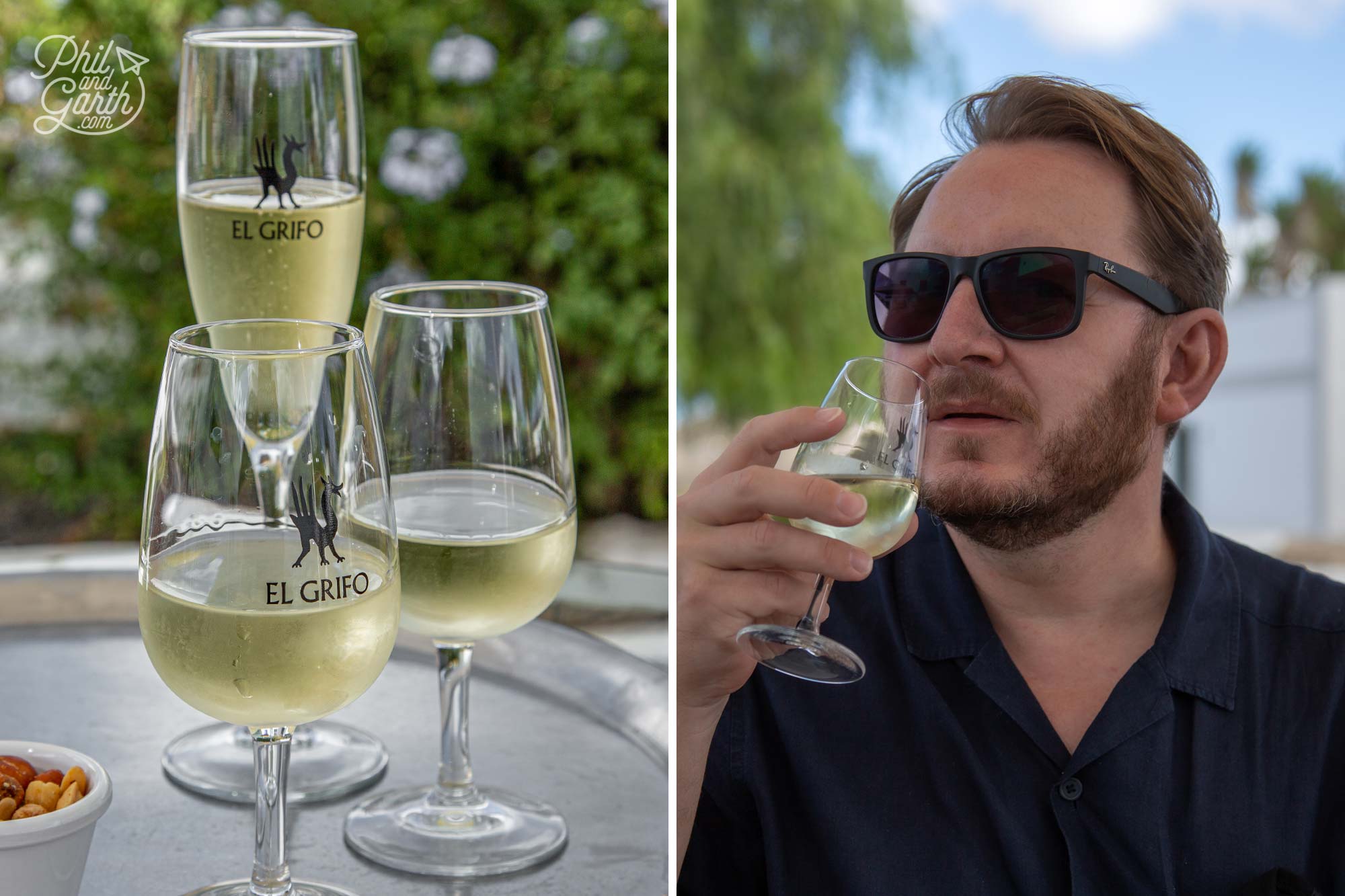
Garth having a little sip of a Malvasia wine
Bodegas El Grifo is open everyday from 10.30am – 7pm. If you want a full guided tour experience you can book it on their website. Other wineries include Los Bermejos and Bodegas Rubicon which has stunning views from their restaurant.
9. Papagayo Beaches
Inside the Los Ajaches Nature Reserve are the stunning Papagayo Beaches. It’s Lanzarote’s idyllic stretch of coastline with a collection of 5 unspoilt beaches separated by cliffs. They are all simple and serene beaches in sheltered bays with calm turquoise waters. It’s a world away from the rows of coloured umbrellas and lively beach bars of the main resorts.
It costs €3 euros to enter the nature reserve where you have to drive down a long, bumpy and dusty unsurfaced track to reach one of the 5 Papagayo beaches – Mujeres, El Pozo, Caleta del Congrio, Puerto Muelas and El Papagayo.
We opted for the main El Papagayo Beach, which attracts a younger crowd. The dust track leads to a large car park right next to Papagayo. There are no facilities here apart from a couple of bar shacks at the top of the cliff. Like most other people visiting we just took a picnic, our beach blanket and towels. It’s really lovely here because it’s totally unspoilt, just golden sand with crystal clear and calm waters protected from currents and waves. Is Papagayo the nicest part of Lanzarote? Well we thought so, a perfect beach for relaxing at.
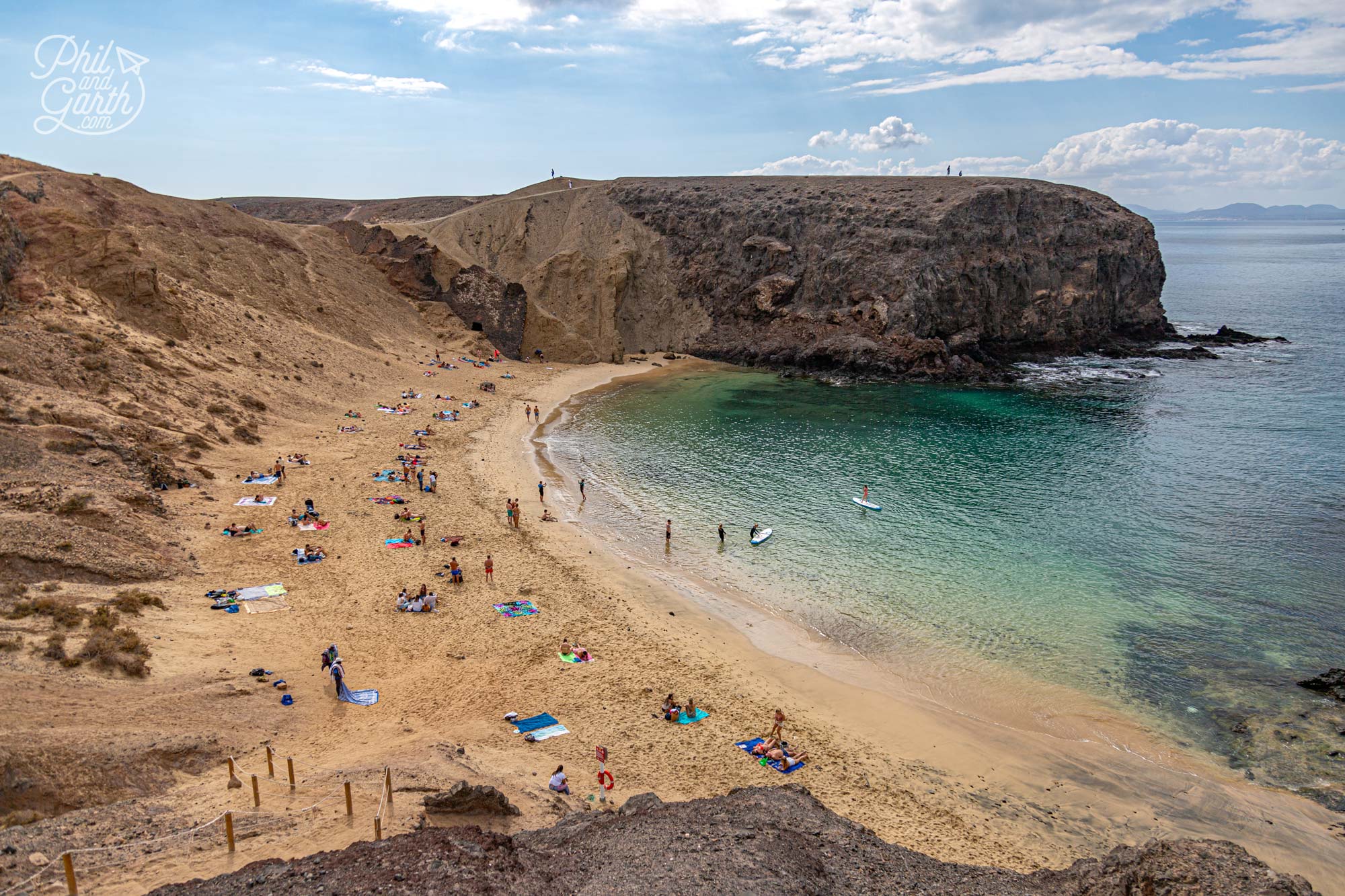
Papagayo Beach is Lanzarote’s famous instagrammed beach
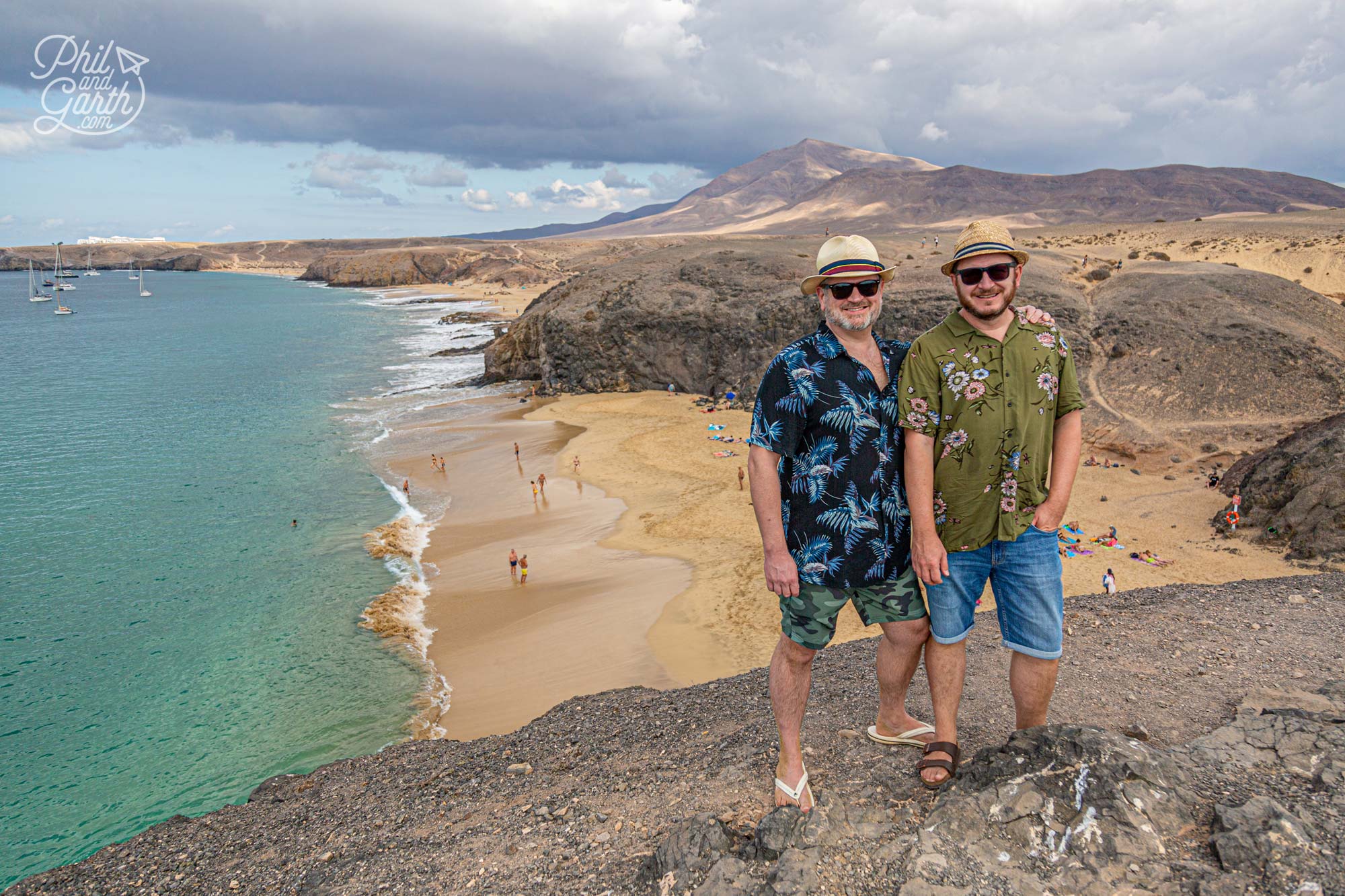
The Papagayo Beaches are made up of 5 beaches – Mujeres, El Pozo, Caleta del Congrio, Puerto Muelas and El Papagayo
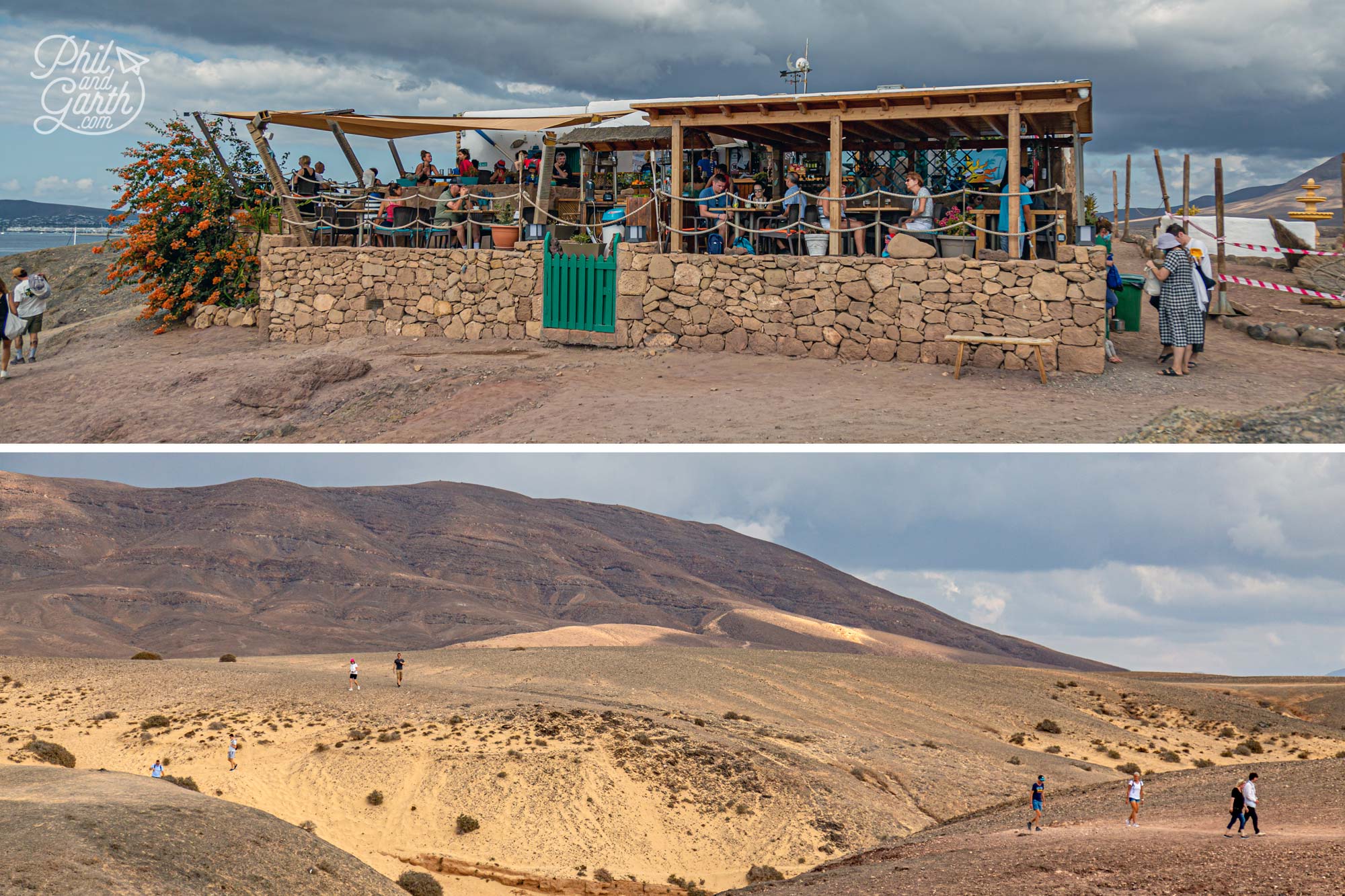
There are no facilities at the Papagayo Beaches apart from a couple of beach bar shacks
10. Los Hervideros Sea Caves
Los Hervideros is Lanzarote’s most dramatic stretch of volcanic coastline. These jagged cliffs were formed by lava flows that met the Atlantic Ocean and solidified.
From the car park walk to the cliffs and wander along a wonderfully created path to get to the different viewing balconies. We watched as the fierce waves crashed against the volcanic rock inside the sea caves. The water looks like pools of boiling water which is what Los Hervideros means “boiling pots”.
Phil was amazed at the power of the water, each time a wave crashed the water would shoot up in a different position. The thrust of each wave almost feels like you will be dragged away with the power of it. Garth thought the cliffs had a similar feel to Fingal’s Cave in Scotland.
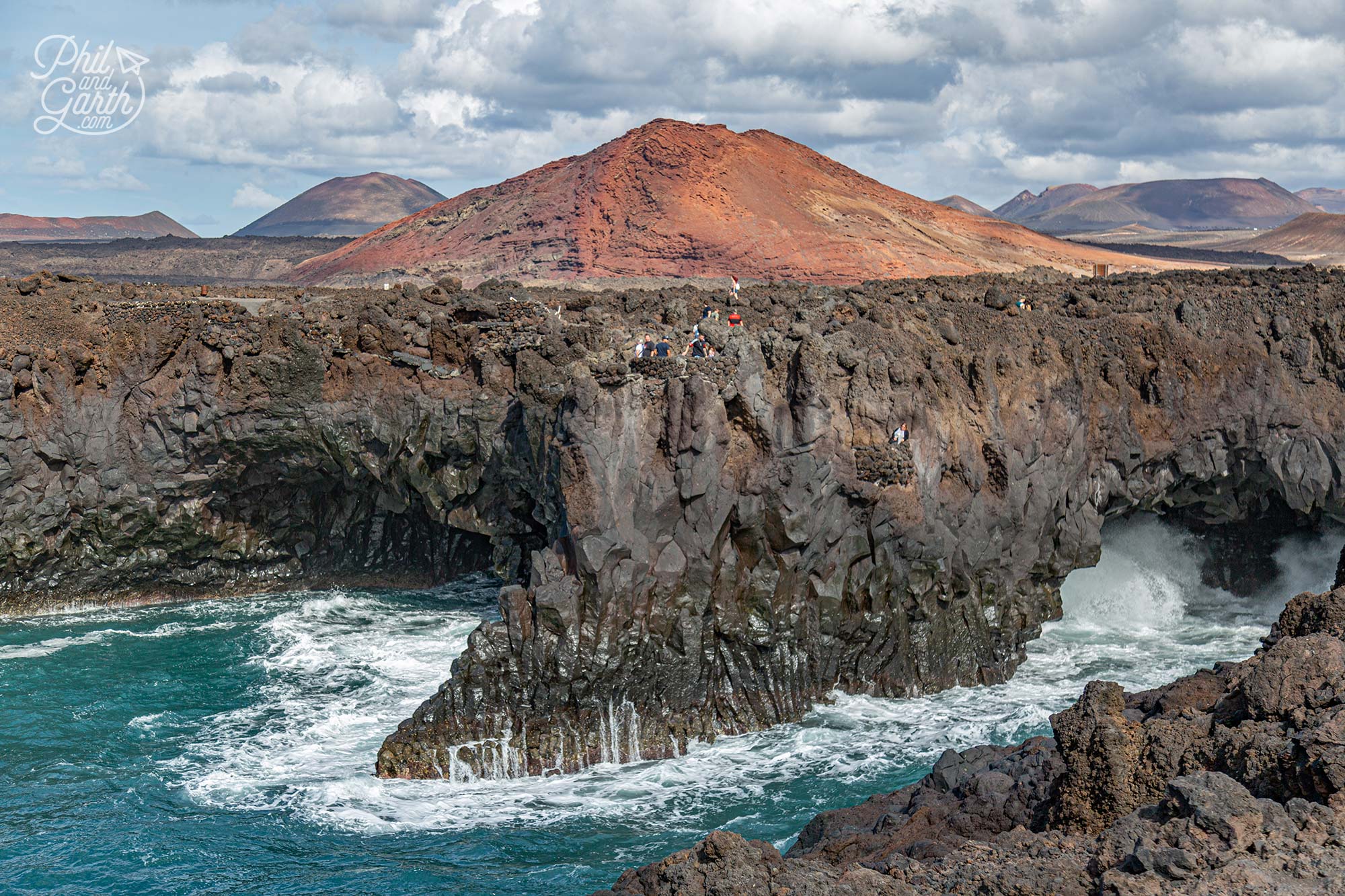
Los Hervideros is 15 minutes from Playa Blanca
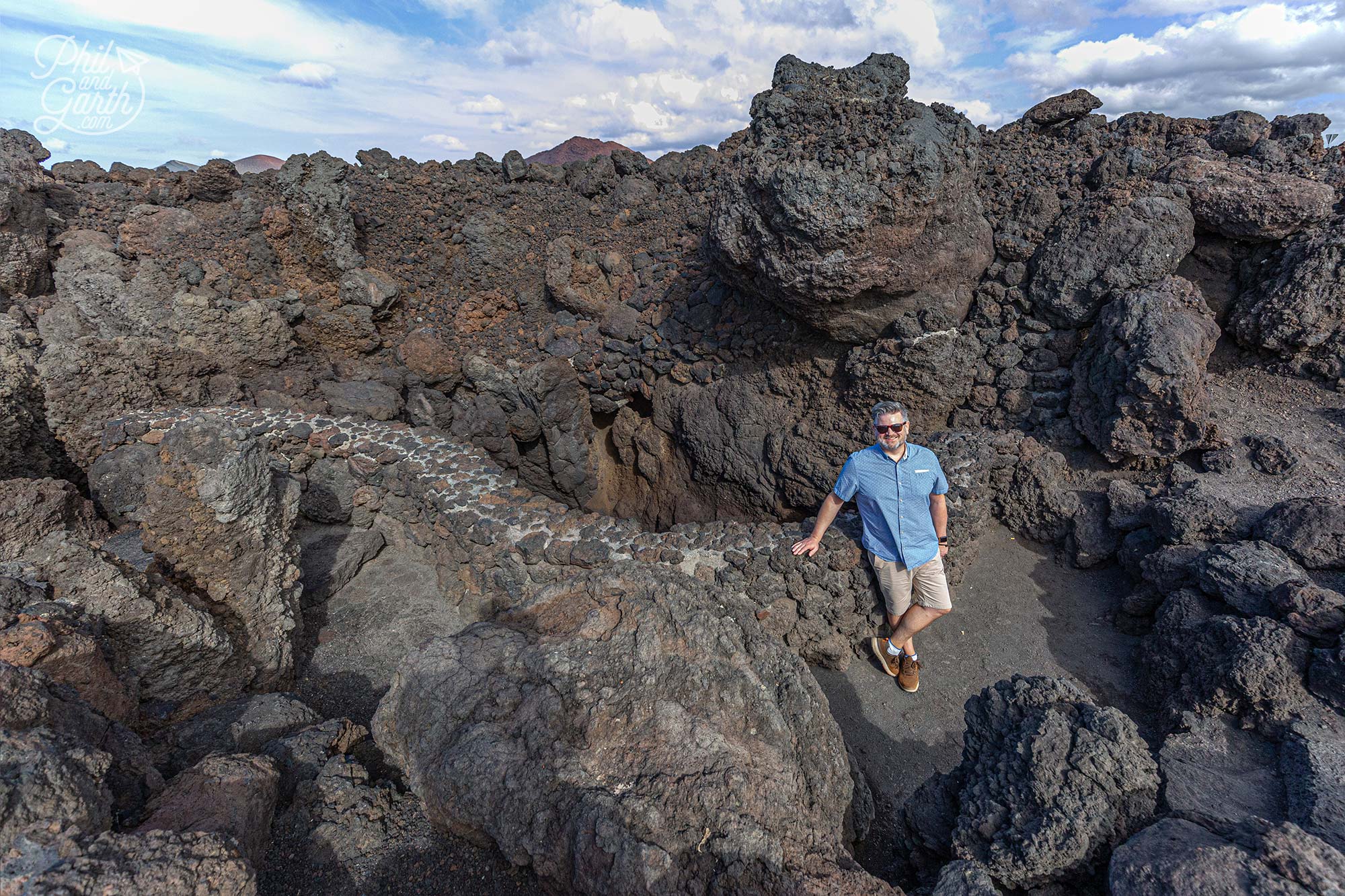
Phil stood next to one of the viewing balconies at Los Hervideros
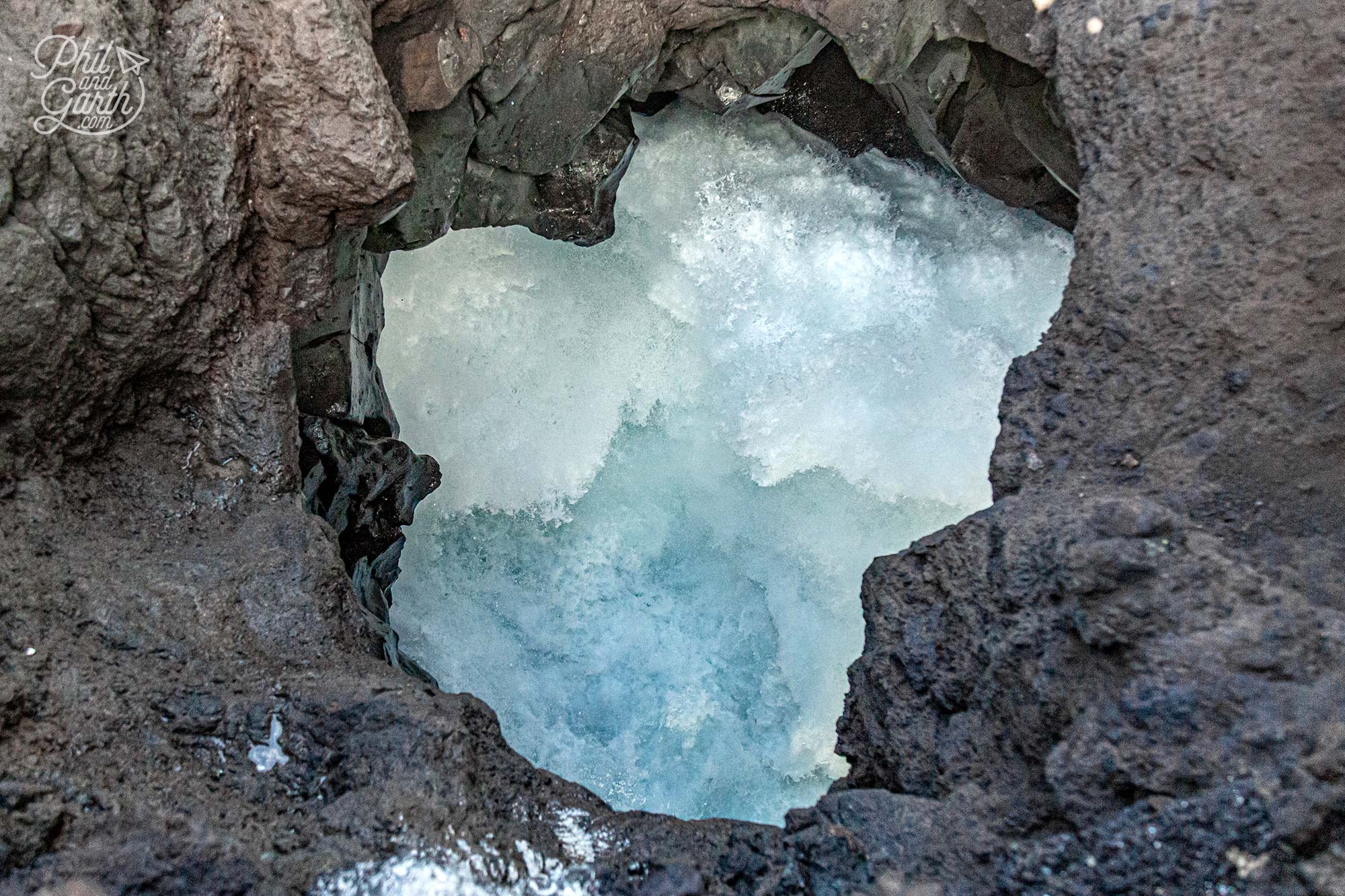
Looking down at the waves crash against the rock inside the caves
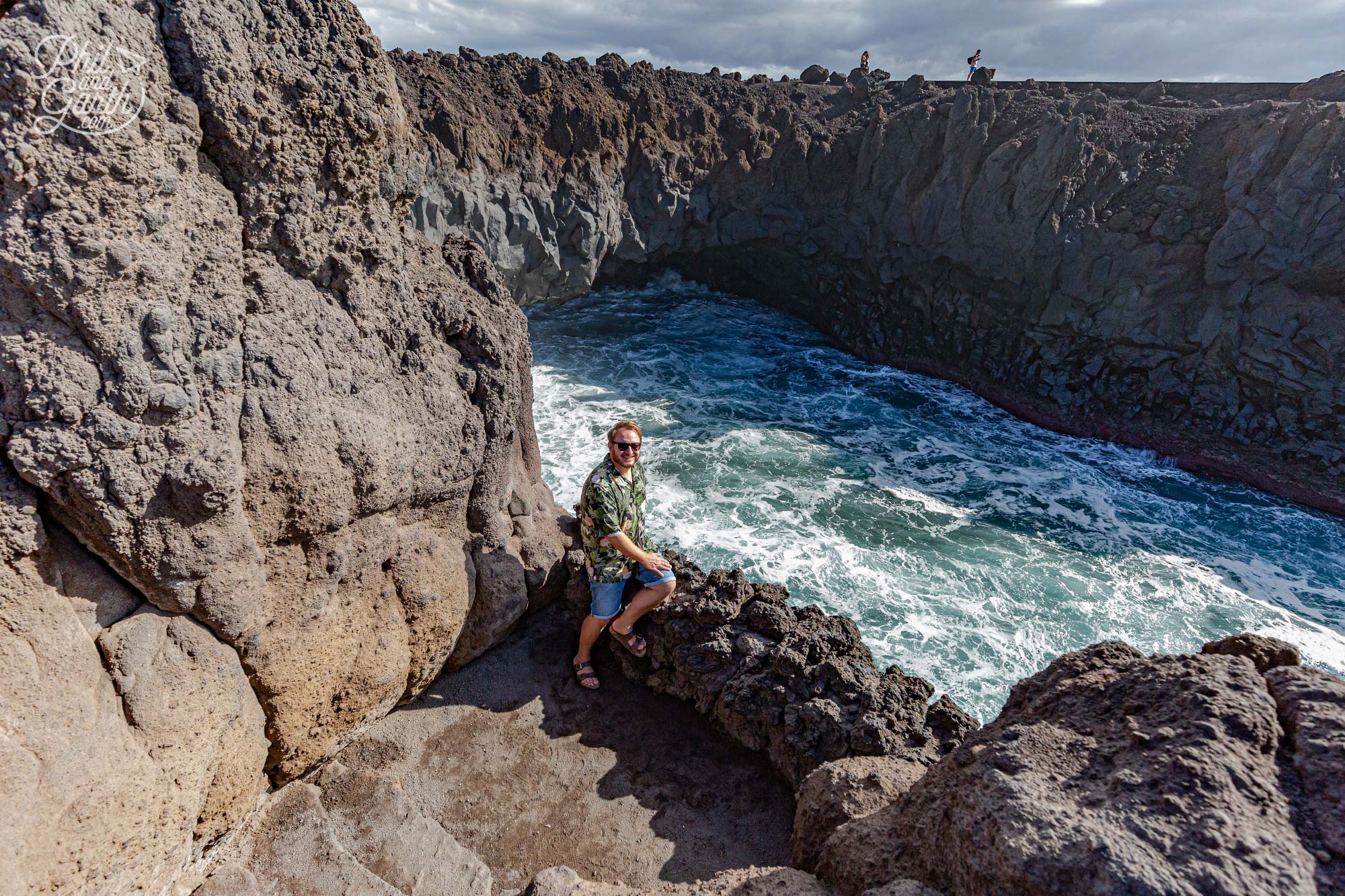
Garth watching the sea churning against the Los Hervideros cliffs
11. Janubio Salt Flats
A 15-minute drive from Los Hervideros you’ll discover the last remaining patchwork of salt flats on Lanzarote. Created in 1895 these multi-coloured terraced salt lakes were built to meet the needs of the entire island for preserving fish. It’s still family-owned and the traditional methods of extracting salt haven’t changed. Water comes from the Atlantic Ocean next to this natural lagoon and then evaporates to form sea salt.
We booked a small group guided tour around the salinas, which was fascinating to learn about all the different processes. Seawater is pumped from the lagoon to the top salt plains and over time passed down several salt beds before the salt is extracted. It needs to go through several salt beds because there isn’t a lot of salt in the Atlantic seawater so each time the water goes into another bed the saltwater mix (brine) becomes more and more concentrated. It takes approx 6 months to create the salt and then another 18 months to fully dry out before going on sale.
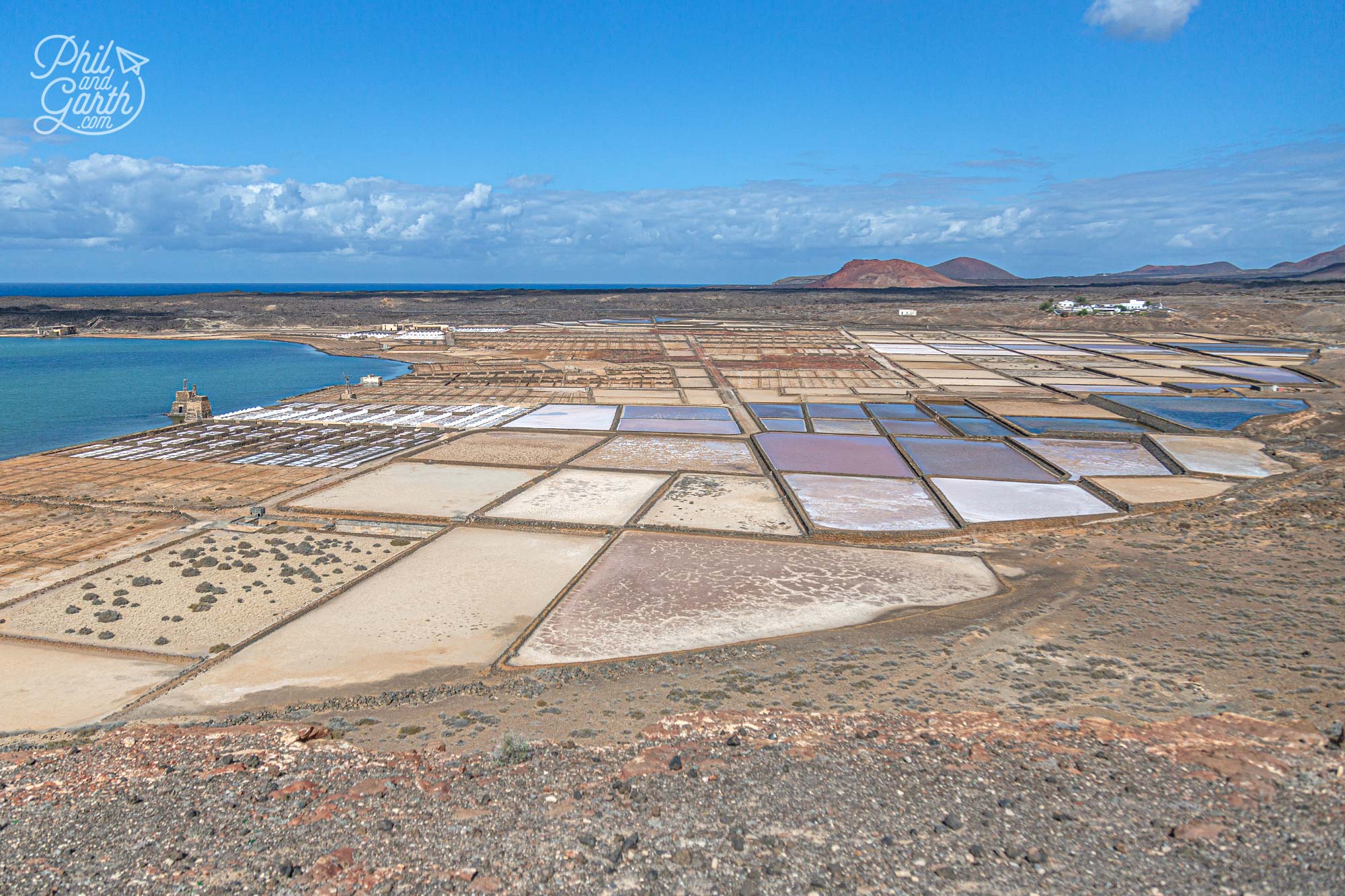
Lanzarote’s Janubio Salt Flats pastel hues look like a patchwork quilt
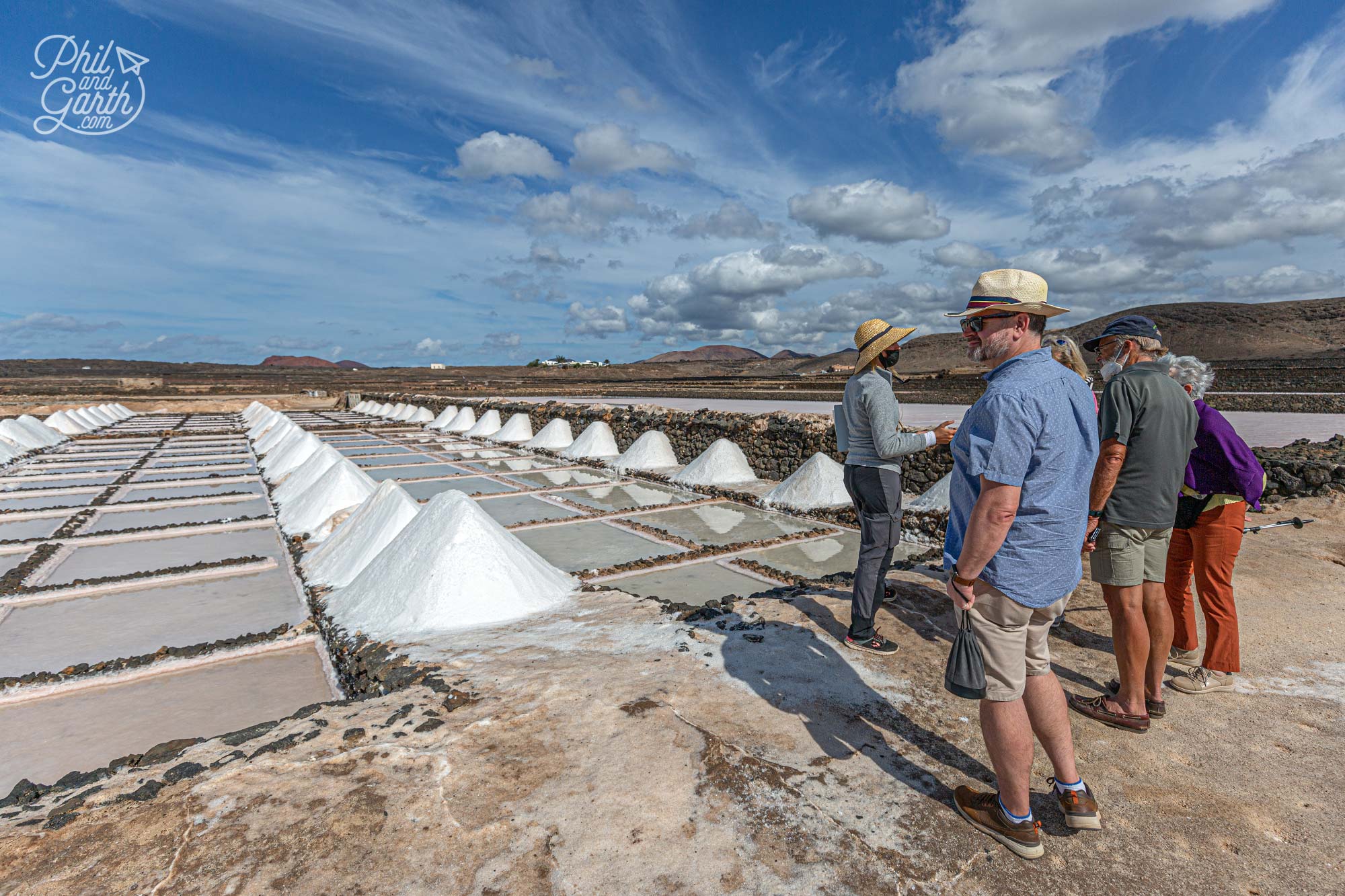
We took a small group guided tour of the Janubio Salt Flats
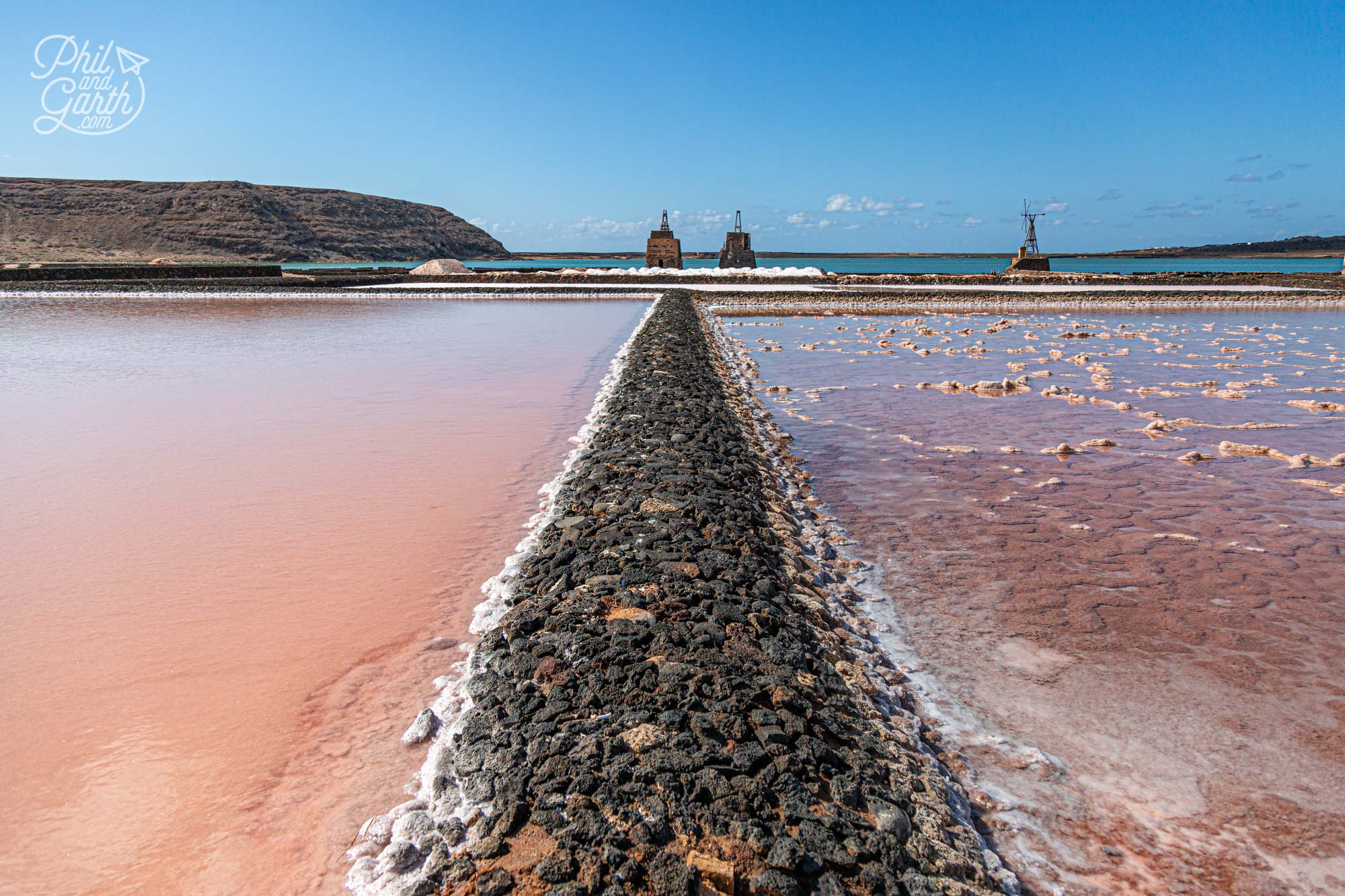
The pink colour comes from red brine shrimps that live in the water
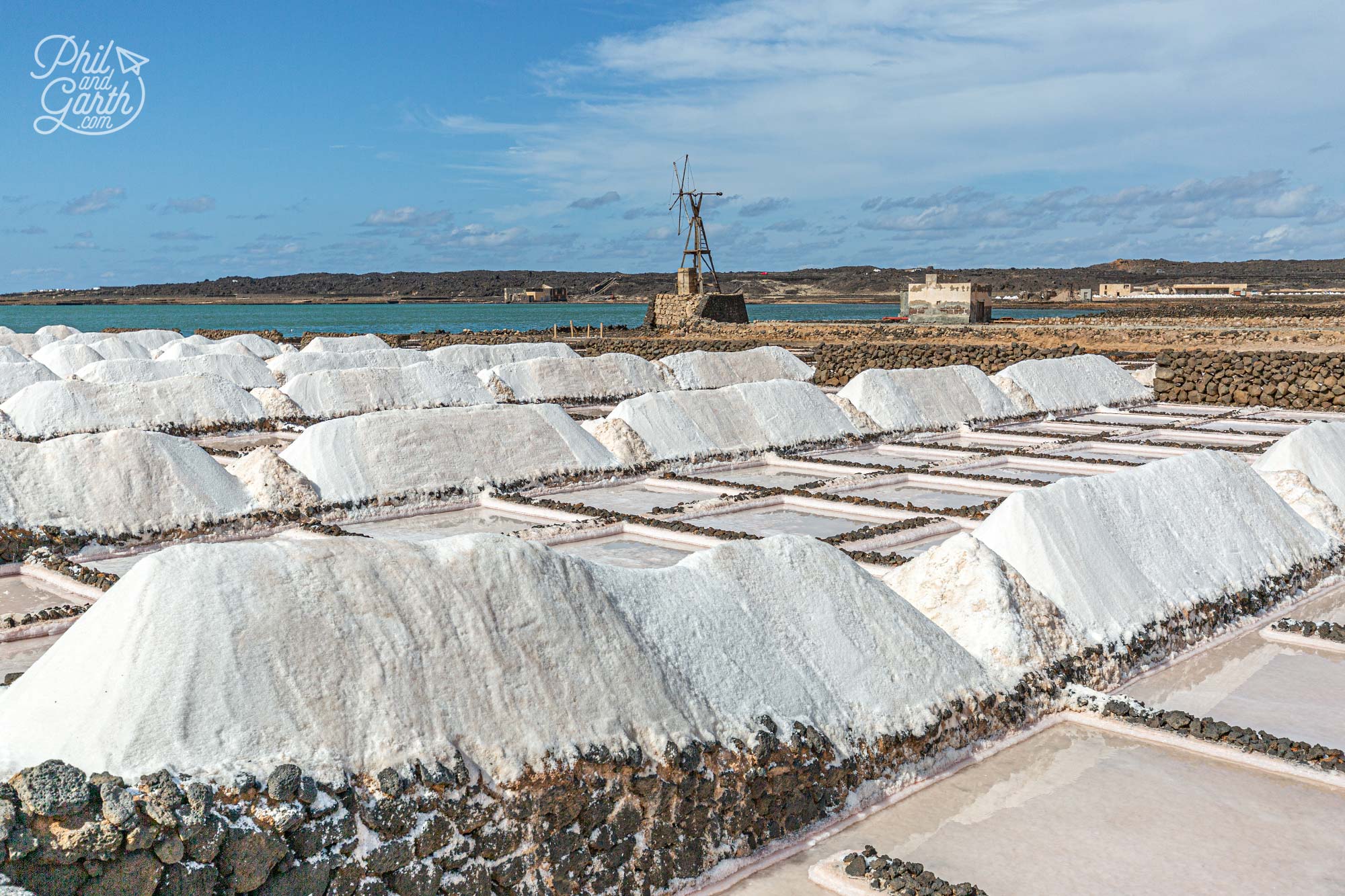
Traditional salt production at Janubio Salt Flats
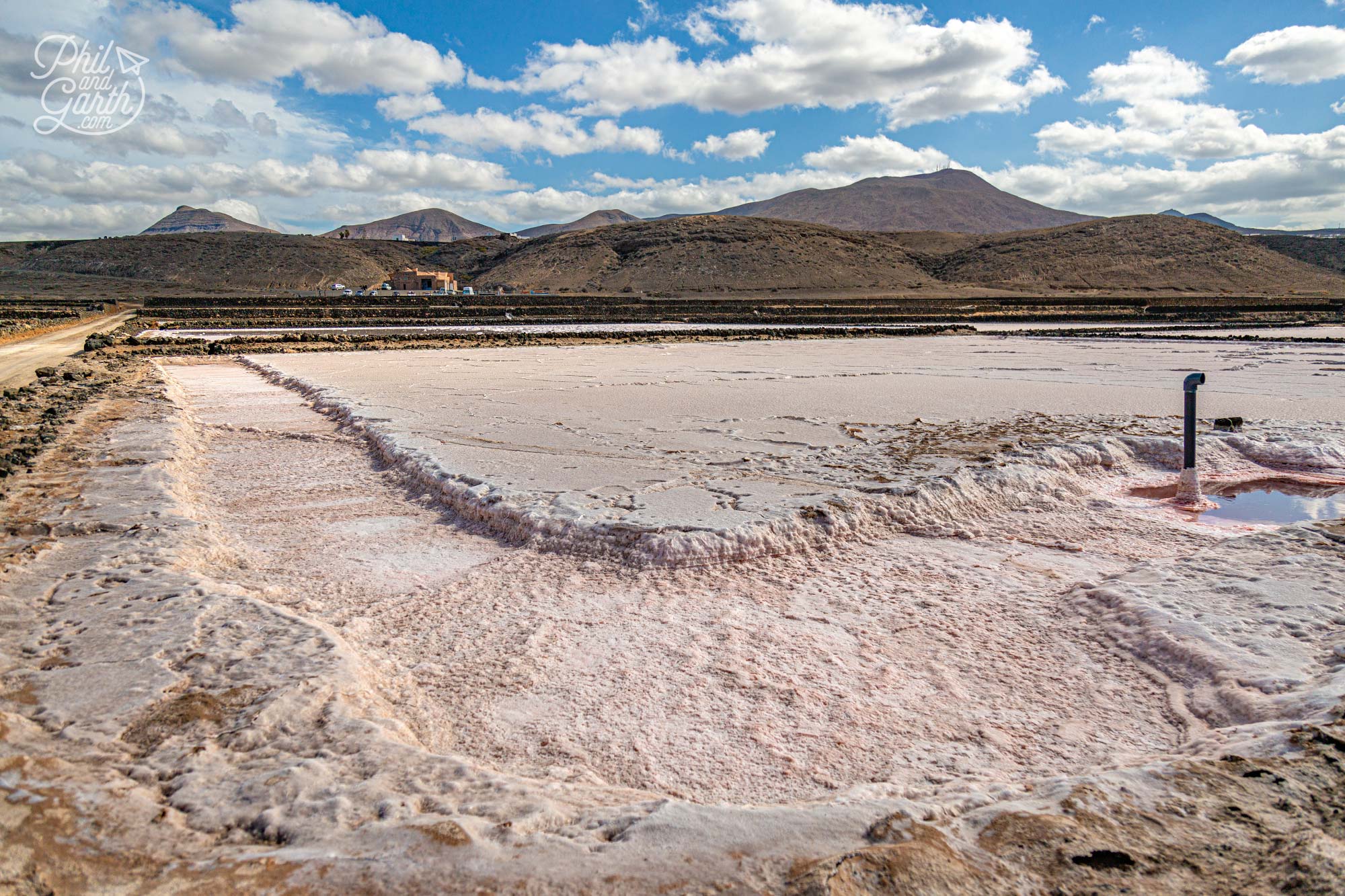
The salt flats are owned by a couple of different families
At the end of the tour is a salt tasting session. Salt tasting might sound disgusting, but it was great. We were treated to a small glass of wine or water and a small sprinkling of salt is put onto tomato slices. A bit of a problem for Phil as the only thing in the whole world he doesn’t eat is raw tomatoes! doh. Anyway, with a sprinkling of the flavoured salt, he was a changed man! At their small shop, we bought their signature flower salt and a small jar of chimichurri and a mojo picón for seasoning steaks and fish. A bargain and a perfectly authentic and useful souvenir to take home.
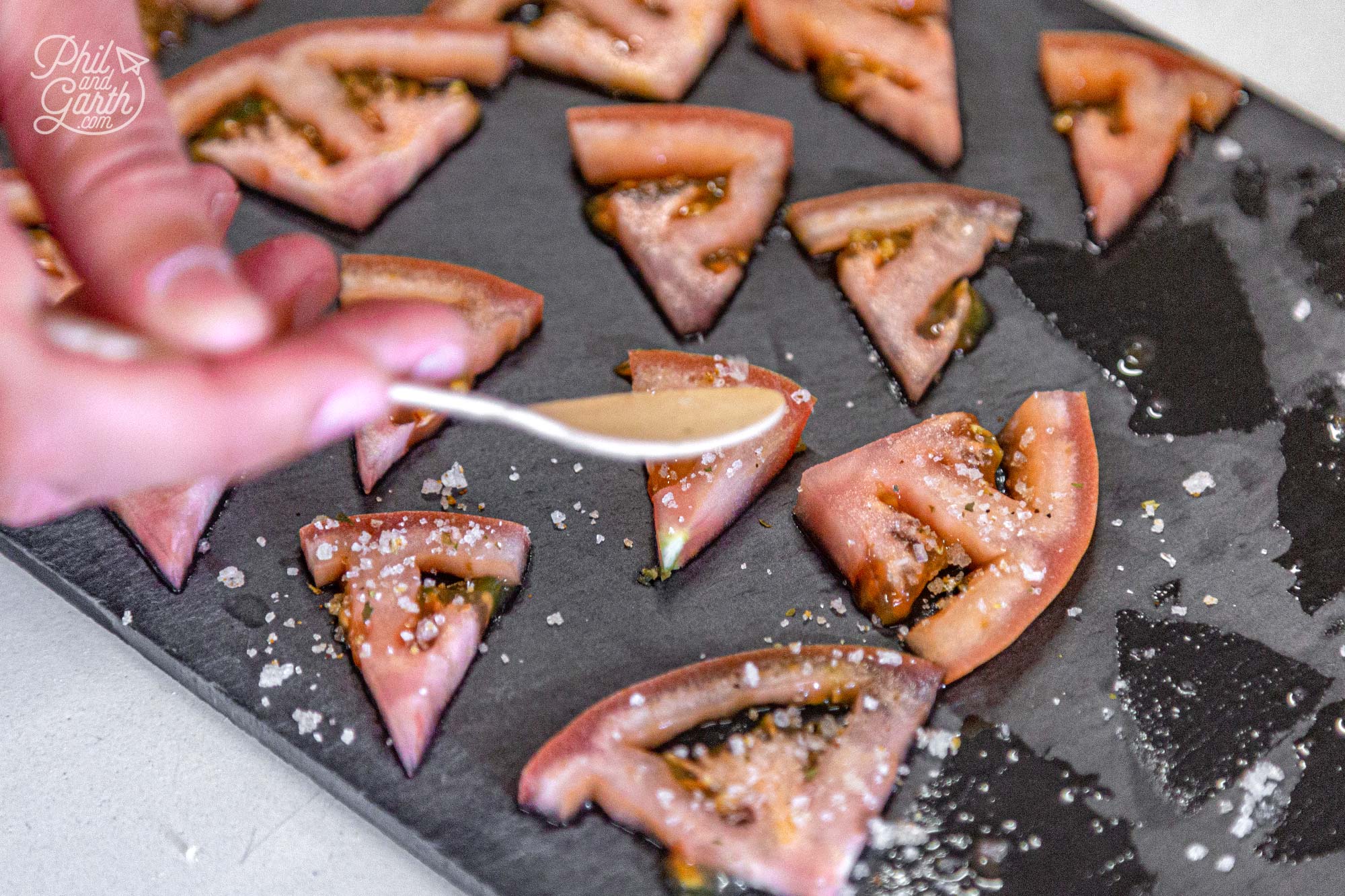
A salt tasting session is included in the guided tour
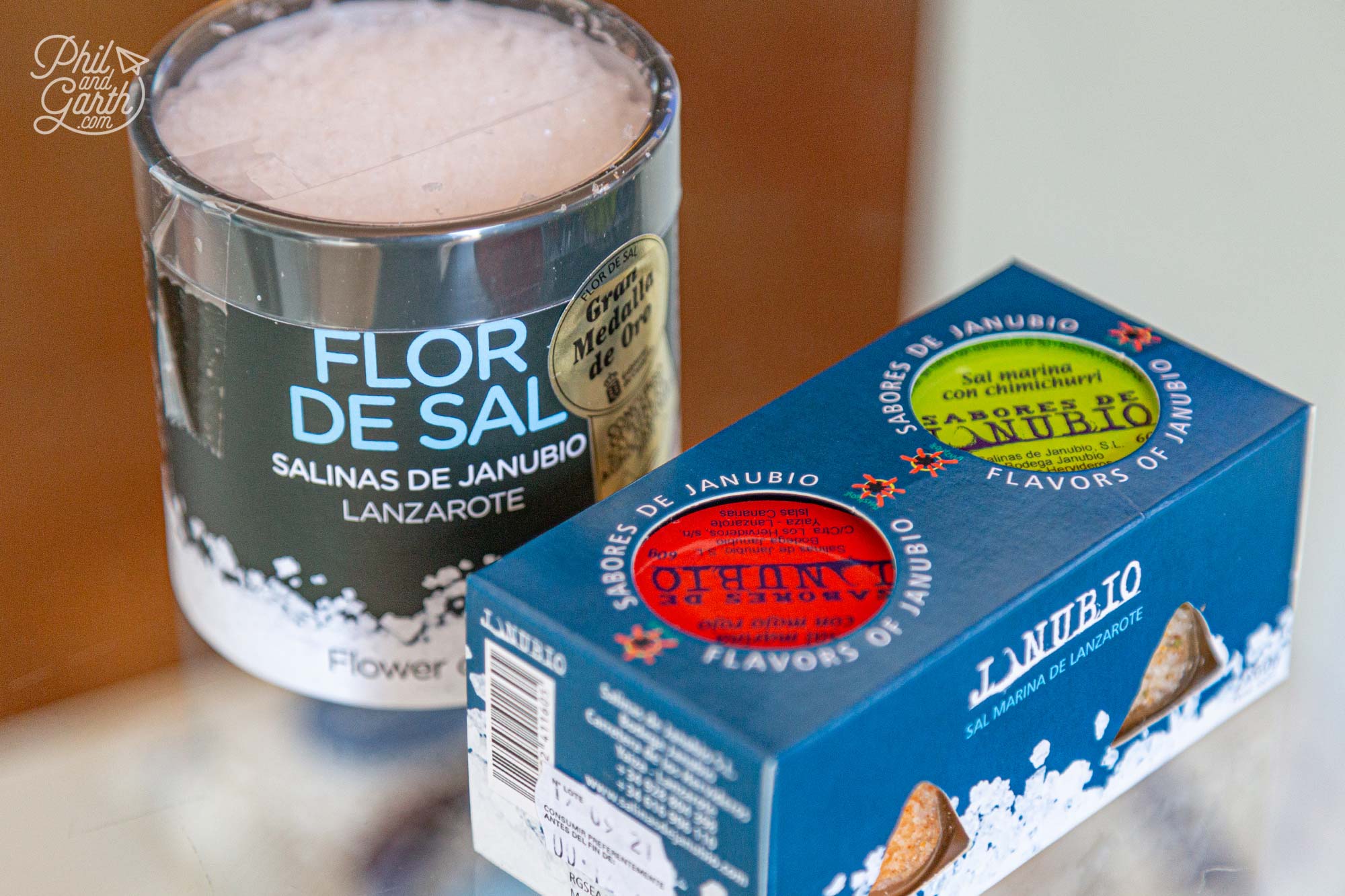
Jars of salt make a perfect useful souvenir to take home from Lanzarote
Janubio Salt Flats is a great spot to view the sunset. There is also a viewing point for a higher panoramic view on the upper coastal road. You can book a tour on their website an adult ticket costs €12.
12. LZ-67 Photo Spot
We’ve included this view of the LZ-67 road looking towards Yaiza because it makes a really cool photo from the car window.
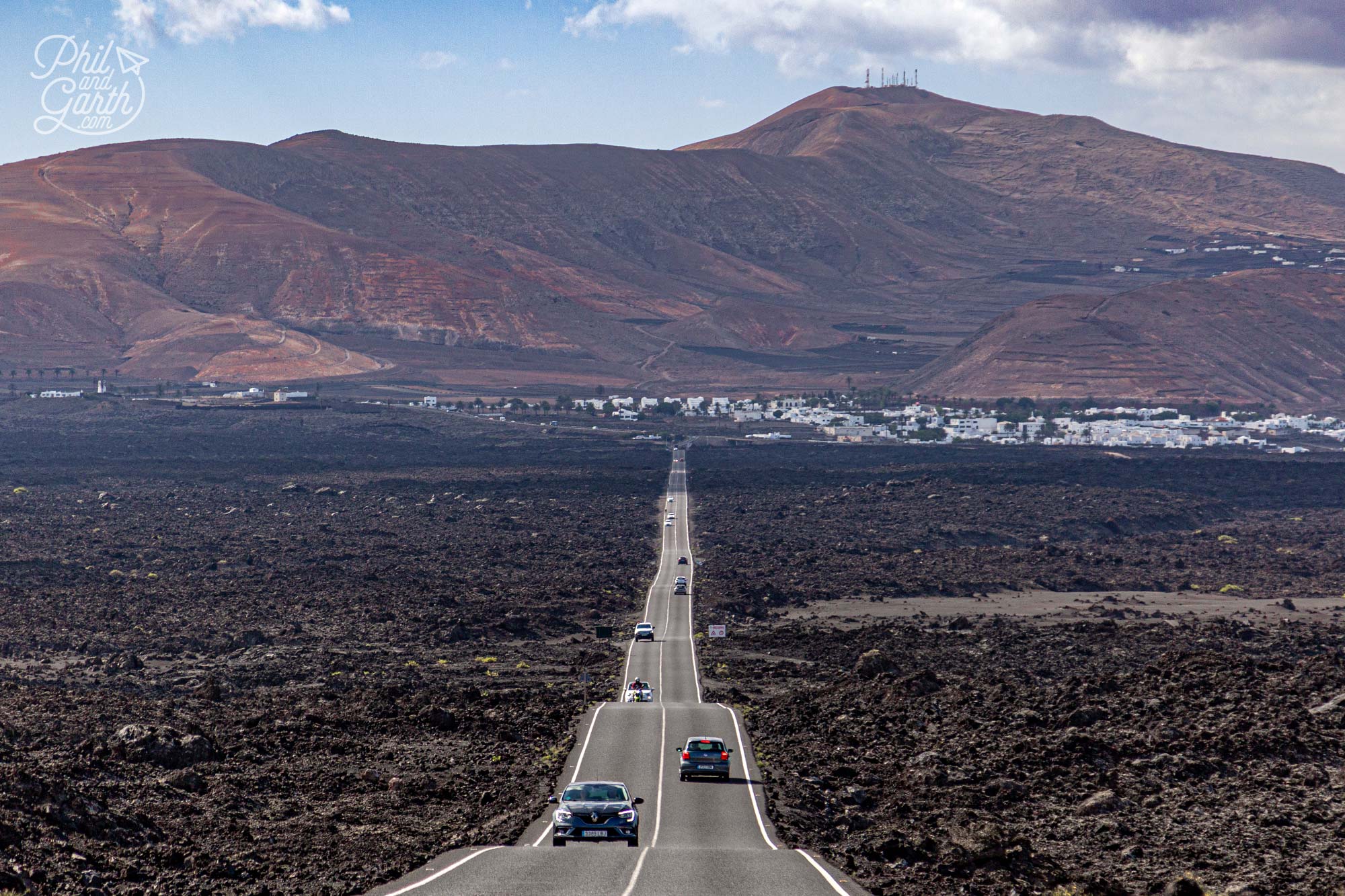
Cool photo spot
Lanzarote Facts and Useful Advice
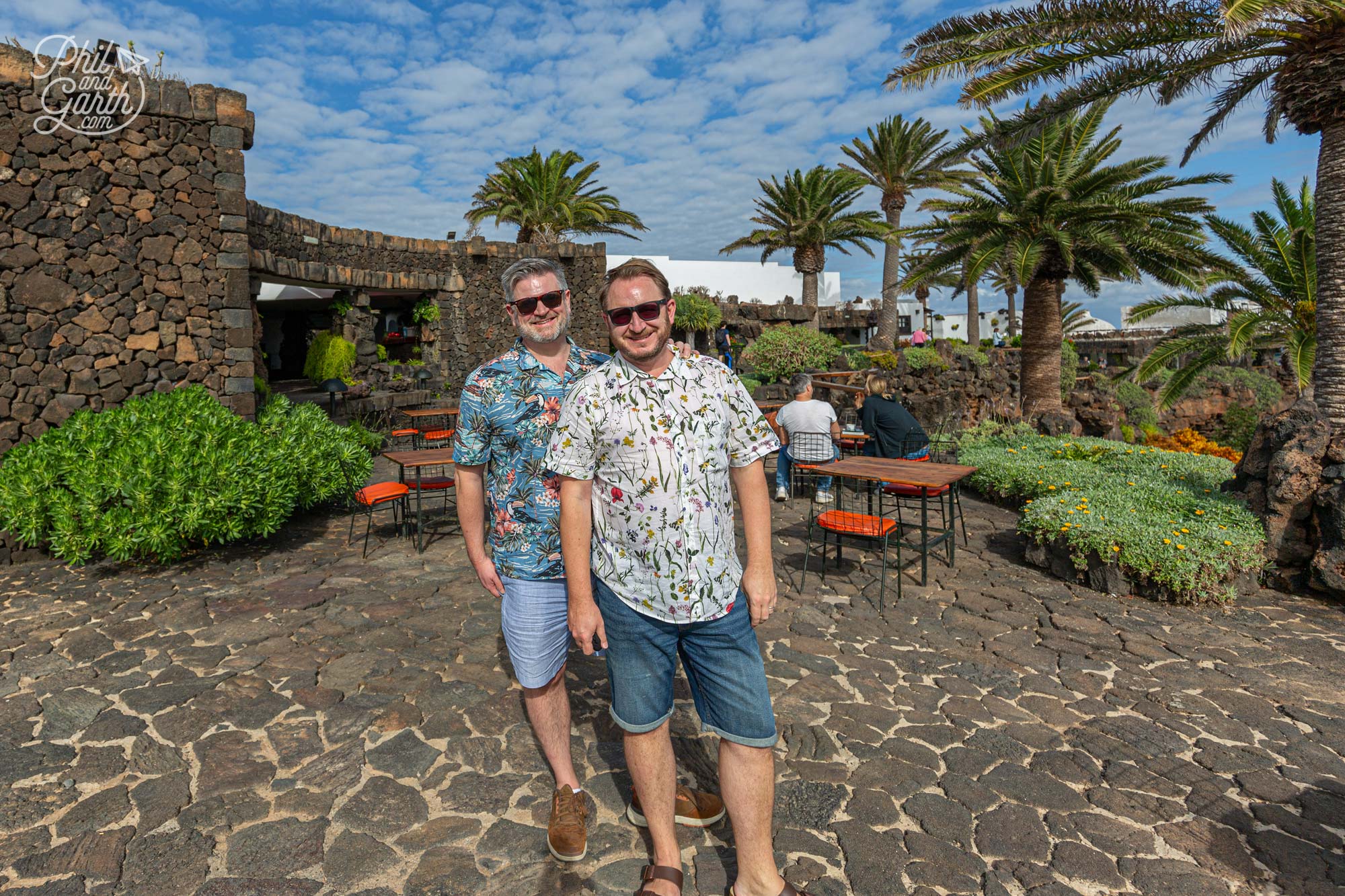
Phil and Garth on Lanzarote
Phil and Garth’s Top 5 Lanzarote Tips
- Tip #1: Lanzarote’s cool breeze is deceiving and you will get sunburnt, so make sure you cover up with sunscreen.
- Tip #2: Don’t drink the tap water in Lanzarote – only drink bottled water.
- Tip #3: Prices rocket during school holidays, so go outside these times for the best deals.
- Tip #4: If you plan on visiting a few Manrique sites, purchase a multiple site ticket.
- Tip #5: Take your binoculars to the island’s various viewpoints.
Google Map of Lanzarote Attractions
7 Day Lanzarote Itinerary
Day 1
- Fly into Lanzarote.
- Relax at hotel / accommodation.
Day 2
- Morning: Mirador del Rio.
- Lunchtime: Jameos del Agua.
- Afternoon: Jardín de Cactus.
Day 3
- Morning: César Manrique’s Volcano House.
- Lunchtime: Casa Museo del Campesino.
- Afternoon: Wine tasting at Bodegas El Grifo.
Day 4
- Morning: Timanfaya National Park, El Golfo & Los Hervideros.
- Afternoon: Janubio Salt Flats.
Day 5
- Morning: Playa del Papagayo.
- Afternoon: Explore Playa Blanca.
Day 6
- Lunchtime: Marina rubicon for lunch.
- Afternoon: Relax at hotel / accommodation.
Day 7
- All day: Relax at hotel / accommodation.
Day 8
- Fly home.
Summary of Lanzarote Beaches
Lanzarote has 3 main tourist resort towns offering a mix of cheap to 5 star accommodation plus lots of villas to rent.
- Playa Blanca – Home to best hotels in Lanzarote. It’s a laid back beach resort, more upscale for those looking for peace and relaxation. The large yacht marina, Marina Rubicón offers classy restaurants and bars. From the port you can take a short ferry trip over to the neighbouring Fuerteventura island.
- Puerto Del Carmen – Largest resort with 6km of golden sandy beaches. Best for lively bars, casinos, shopping and nightlife. Plus cosy restaurants in the quieter old town. It’s the most popular resort and a favourite for people from the UK, Germany and Scandinavia.
- Costa Teguise – Family favourite resort with a water park and markets. Windsurfing and watersports in this breezy spot.
Lanzarote FAQs
- Where is Lanzarote? Part of the Canary Islands in the Atlantic Ocean. Lanzarote is just 78 miles from Africa’s mainland.
- What is Lanzarote’s airport code? ACE – (Arrecife) Aeropuerto de César Manrique-Lanzarote.
- What time is it in Lanzarote? GMT +1 hour. Western European Standard Time.
- What currency is used on Lanzarote? Euro (symbol: €)
- What language is spoken in Lanzarote? Spanish and English is widely spoken.
- What is the population of Lanzarote? 150,998
- What number should I call in an emergency? – Call 112 for all emergencies.
- What plug type is used in Lanzarote? Plug Type C & F (Europlug type). Voltage is 230V / 50Hz.
- When is the best time to visit Lanzarote? June and September have the highest temperatures.
- When is the worst time to visit Lanzarote? The school holidays when prices skyrocket. January is also the coldest month averaging 17ºC. December is the wettest month.
- What is Lanzarote famous for? Volcanic landscapes, beach resorts, vineyards, black beaches.
- What are Lanzarote’s 5 must see sights? Timanfaya National Park, Jameos del Agua, Fundación César Manrique, Mirador del Rio & Papagayo beaches.
- What is the local food? Sanchoco is Lanzarote’s signature salted sea bream stew. Other Canarian dishes to try include red sea bream, rabbit stew, paella.
- What is the best way to get around? A hire car is the best way to get around and to make the most of your time.
- What’s a fun fact about Lanzarote? In 1999 a British Airways Concorde landed in Lanzarote. The same G-BOAC aeroplane is now on display at Manchester Airport.
- What movies have been filmed on Lanzarote? One Million Years BC (1966), Krull (1983) and Clash of the Titans (2010).
- Where is the best photo spot? Timanfaya National Park.
- Where is a hidden gem in Lanzarote? Unspoilt Papagayo beach.
- What’s the best souvenir to buy in Lanzarote? A bottle of Malvasia – the local wine.
- What is the Lanzarote official tourism website? Click here.
- What is the website for arrivals at Lanzarote airport? Click here.
How We Did It
- We wanted to stay at the Villas Kamezi but they were fully booked, so we opted for a last-minute hotel – Hipotels Natura Palace – an adults-only hotel.
- We hired a car with TopCar. Always found them to be good value and no hassle.
- We visited in mid-November, sunny spells and very cloudy at times, the average temperature during the day was 22C. Evenings were chilly at 16c. Mosquitos were out in the evenings.
Pin our Lanzarote travel guide for later.
- Top 12 Attractions of Lanzarote
- Lanzarote 7 Day Itinerary


